Paul van Yperen's Blog, page 209
January 17, 2020
New Acquisitions: Nos artistes dans leur loge
In 2012, EFSP had a post on the French postcard series 'Nos artistes dans leur loge'. The series presents dozens of French stage and film stars of the early 1920s in their dressing rooms. Nearly all of the postcards were produced by the French journal Comoedia. Since then, Ivo Blom collected more cards of the series and we did a post on these in November last year. Here are 31 more fascinating examples of the series, which Ivo acquired recently and EFSP never published before.
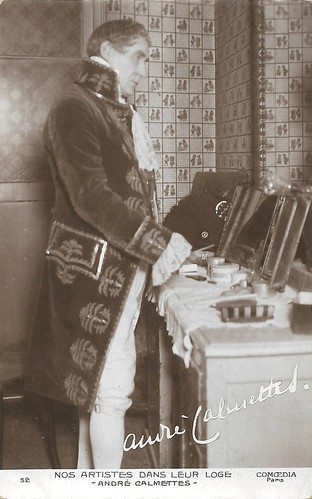
French postcard in the Nos artistes dans leur loge series, no. 52. Photo: Comoedia, Paris.
André Calmettes (1861-1942) was a French stage and screen actor an director. After being a stage actor for twenty years, Calmettes became artistic director and director of the company Le Film d'Art, founded by the Laffitte brothers. Its films were distributed by Pathé Frères. Until the early 1920s he acted on stage, mainly at the Parisian theatres Odéon, Vaudeville, Gymnase, and Porte St. Martin.
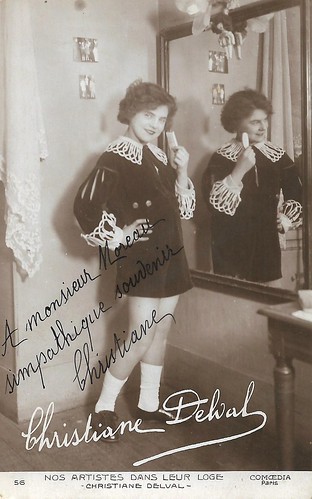
French postcard in the Series Nos artistes dans leur loge, no. 56. Photo: Comoedia.
Christiane Delval (?-?) acted as child actress in eight French silent films in the early 1920s, starting with the drama Face à l’océan (René Leprince, 1920). That year, Delval also acted in Le petit poucet (Robert Boudrioz, 1920) and Fabienne (Camille de Morlhon, 1920). Delval acted as young Geneviève and Palôtte in the four episodes of the family drama Gigolette (Henry Pouctal, 1921). Other films Delval acted in were the Zola adaptation Le rêve (Jacques de Baroncelli, 1920) with Gabriel Signoret and Andrée Brabant , La tentation (Henry de Golen, 1921) with Georges Wague , La folie du doute (René Leprince, 1923) with Jean Dax , and Pour une nuit d'amour (Yakov Protazanov, 1923) with Edmond Van Daële. In 1931 Delval acted in the French early sound comedy Plein la vue (Edmond Carlus, 1931), shot at the Tobis studios in Epinay, while her last part was in the comedy Dora Nelson (René Guissart, 1935) starring Elvire Popesco . Delval also acted on stage.
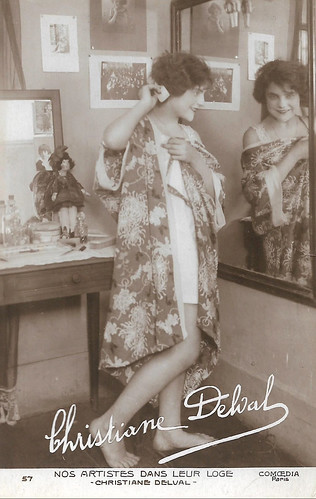
French postcard in the Series Nos artistes dans leur loge, no. 57. Photo: Comoedia.
Christiane Delval (?-?) acted as a child actress in eight French silent films in the early 1920s, starting with the drama Face à l’océan (René Leprince, 1920). In 1920 Delval also acted in Le petit poucet (Robert Boudrioz, 1920) and Fabienne (Camille de Morlhon, 1920). In 1921 Delval acted as young Geneviève and Palôtte in the four episodes of the family drama Gigolette (Henry Pouctal, 1921). Other films Delval acted in were the Emile Zola adaptation Le rêve (Jacques de Baroncelli, 1920) with Gabriel Signoret and Andrée Brabant , La tentation (Henry de Golen, 1921) with Georges Wague, La folie du doute (René Leprince, 1923) with Jean Dax , and Pour une nuit d'amour (Yakov Protazanov, 1923) with Edmond Van Daële. In 1931 Delval acted in the French early sound comedy Plein la vue (Edmond Carlus, 1931) starring Raymond Dandy and shot at the Tobis studios in Epinay, while her last part was in the comedy Dora Nelson (René Guissart, 1935) starring Elvire Popesco .
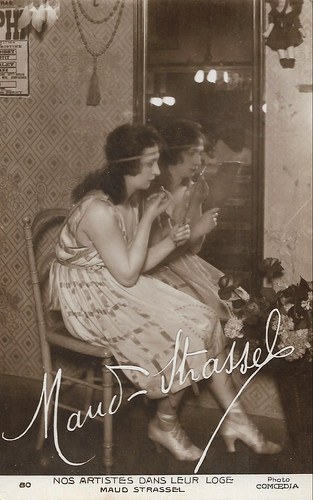
French postcard in the Series Nos artistes dans leur loge, no. 80. Photo: Comoedia.
Little is known about Maud Strassel but shat was a performer in revues and operettas in the early 1920s. In those years she played Aphasie in the operetta 'Phi-Phi' at the Bouffes Parisiens, and also performed e.g. at the Folies-Bergère and the Théàtre de la Gaité-Lyrique. As far as known she did not act in cinema.
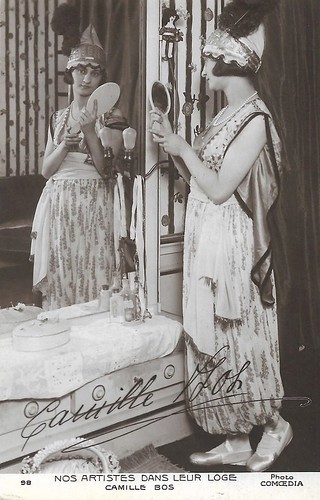
French postcard in the Series Nos artistes dans leur loge, no. 98. Photo: Comoedia.
Camille Bos (born 1899) was a French ballet dancer. At the age of 10, she entered the ballet school of the Paris Opera. In 1920 she was named 'première danseuse', and in 1925 she was promoted to 'danseuse étoile/star dancer'. Bos participated in numerous performances e.g. 'Siang-Sin' (1927), 'L'écran des jeunes filles' (1929) and 'La Grisi' (1935). Her partners included the famous Serge Peretti and Serge Lifar with whom she danced in 'Le Spectre de la Rose' (1931) by Michel Fokine. At the age of 36 she stopped dancing to dedicate herself to teaching. For 12 years she taught at the Opéra de Paris. Her only known film performance was as a dancer in the Zola adaptation Nantas (Donatien, 1925), starring Donatien , Lucienne Legrand, and Maxime Desjardins .
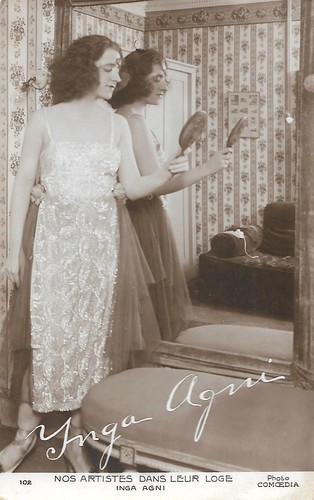
French postcard in the Series Nos artistes dans leur loge, no. 102. Photo: Comoedia
Little is known about singer/actress Inga Agni. In the early 1920s she performed at the Folies-Bergère, e.g. in the revue 'C'est la folie', and at the Casino de Paris, e.g. in the revue 'Y a qu' Paris!' with Dorville. She probably never acted in cinema.
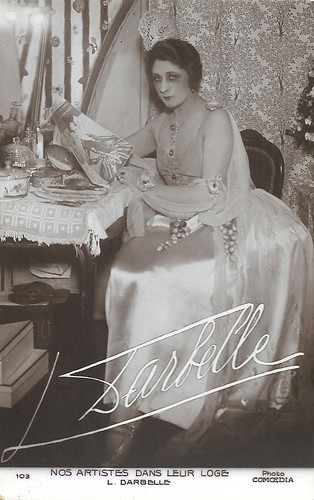
French postcard in the Series Nos artistes dans leur loge, no. 103. Photo: Comoedia.
Lucette Darbelle (?-1943), originally Louise Silvain, was a French operetta singer. She probably didn't act in film. Darbelle became a Parisian vedette after the success of her part of Madame Phidias in Phi-Phi in 1921. She was e.g. part of the troupe of 'La Revue des Étoiles '(1922), starring American crime serial queen Pearl White. She had a fatal ending during the war: because of a relationship with a German officer, she was strangled with a telephone cable. Not to be confused with the actress Louise Silvain (1874–1930), wife of actor Eugène Silvain .
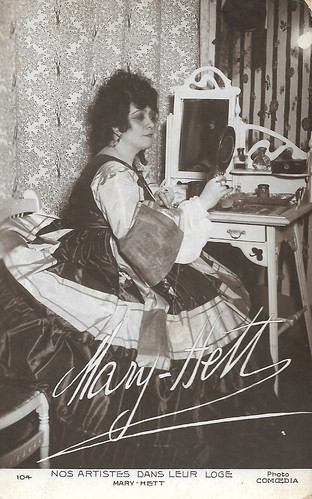
French postcard in the Series Nos artistes dans leur loge, no. 104. Photo: Comoedia.
French actress and operetta singer Mary-Hett (?-?) was already around 1900 a popular Parisian café-concert singer and would remain so for decades. In the late 1890s Edouard Marchand overtook the Parisian theatre Eldorado, appointed Leon Garnier as director and the latter composed a group of newcomers among whom a few would become very popular such as Mistinguett and Dranem . Mary Hett was also among these newcomers. She was also a popular actress in revues at the Folies-Bergères and sang at the Scala. In 1909-1910, she played Conchita in 'L'Amour en Espagne', which revived the French operetta after its fall, while in 1915 she starred in the comic operetta 'Antonio Toréador'. She would remain highly active operetta singer all through the 1920s, in operettas mostly by Maurice Yvain, including 'La dame en rose' (1921), the extremely popular 'Ta bouche' (1922-1931, with reprisals in 1936, 1940 and 1944), and 'La dame en décolleté' (1923-1925). Mary Hett acted in a handful of short films in the early cinema. In 1909 she started at Pathé Frères in the comedy Octave (1909) with a young Harry Baur , the comedy Le Roman d’une bottine et d’un escarpin (Georges Monca, 1909), L'Infidélité d’Ernest (1910) with Prince , and the drama Le Bon agent (Georges Monca, 1910). Under the name of Miss Ellynett, Hett also acted in the comedy Mariage à l’espagnole (Michel Carré, 1909) and La Malle du peintre (1910) with Prince . Later, she acted in the Lux production Un bal d'apaches dans le grand monde (André Heuzé, 1912), and was one of the leads in the two-reeler comedy Deux maris, deux femmes et un commissaire (1917), about a presumed adultery cleared before the police. The title of the feature-length silent comedy Miss Helyett (Georges Monca, Maurice Kéroul, 1928) seems to hint at Hett's earlier used pseudonym. Hett herself also had a major part in the film as a Spanish senorita, though the title role was for Marie Glory . It was her last film role.
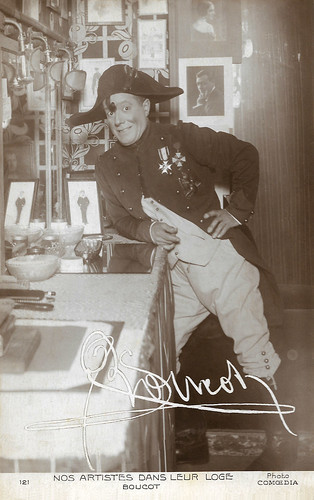
French postcard in the Nos artistes dans leur loge series, no. 121. Photo: Comoedia, Paris.
Louis-Jacques Boucot aka Boucot (1882-1949) was a French stage and screen actor, famous for his comic characters of Pénard and Babylas.
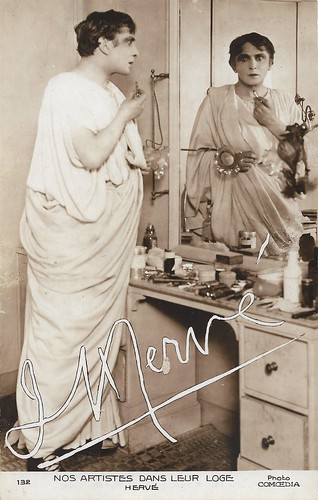
French postcard in the Nos artistes dans leur loge series, no. 132. Photo: Comoedia.
Jean Hervé (1884-1966) was a French stage and screen actor, known for his work at the Comédie-Française but also for his parts in Film d'Art cinema, the Rocambole films, La Terre (1921) and Feu Mathias Pascal (1926).
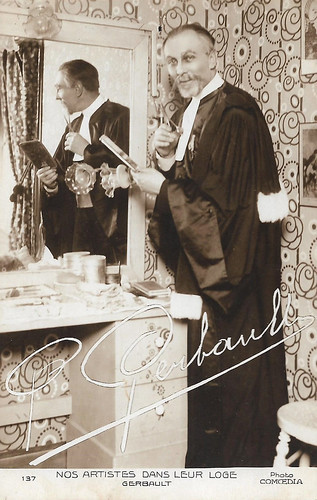
French postcard in the Series Nos artistes dans leur loge, no. 137. Photo: Comoedia.
Paul Gerbault (?-?) was an esteemed French stage actor, who also played in a handful of films. As far as can be reconstructed, he acted at the Comédie-Française from 1912 onward, first in Le Ménage de Molière (1912). He alternated the classics of Molière, Corneille, Euripides, Sophocles, and Hugo, with modern repertory by Bataille, Bernard, and Ibsen. In 1931 Gerbault acted in his last Comédie performance, 'Patrie!' by Sardou, directed by Émile Fabre, and starring Albert Lambert fils and an all-star cast. The play was reprised in 1932, with Gerbault again acting, by the Théâtre National Populaire. Gerbault's last part was that of Orgon in Molière's classic 'Tartuffe', in 1935 at the Théâtre du Vieux-Colombier.In the cinema, Gerbault acted in the historical drama La Jacquerie, révolution paysanne de 1358 (Henri Pouctal, 1911), a Pathé production on a farmer's rebellion in the Middle Ages. He played Colline in the Pathé drama La Bohème (Albert Capellani, 1912) with Paul Capellani as Rodolphe and Suzanne Revonne as Mimí. In 1914 he acted opposite Léon Bernard in Sa majesté l'argent (Adrien Caillard, 1914). After a long absence from the screen, Gerbault returned as Dr. Boudon in Le crime du Bouif (1922), starring the popular comedian Tramel . His last film part was that of the judge in La main qui a tué (Maurice de Marsan, Maurice Gleize, 1924). The costume on the postcard reminds this part. Gina Manès played the lead in this film.
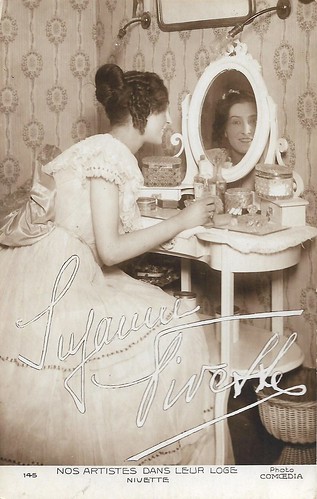
French postcard in the Series Nos artistes dans leur loge, no. 145. Photo: Comoedia.
French stage and screen actress Suzanne Nivette (1895-1995) debuted on screen as Eponine in Les Misérables (Henri Fescourt, 1925), based on Victor Hugo's classical novel, while in 1921 she had debuted on stage in the theatrical version of the same source. This was her only silent film part, as only from 1934 she had a steady career as film actress in the French sound cinema, which would end in 1960 and include some 20 films. One of her last film parts would be in another adaptation of Les Misérables (1958), now playing Mademoiselle Gillesnormand. In addition to film, Nivette had a rich stage career. Her last part evolved at the Comédie Française in the early 1950s. Suzanne Nivette would become 100. She was married to the actor Georges Saillard (1877-1967).
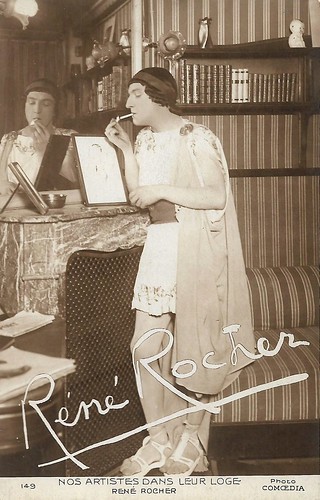
French postcard in the Series Nos artistes dans leur loge, no. 149. Photo: Comoedia.
René Rocher (1890–1970) was a France stage actor and theater director. In 1923, Rocher gave its name to the current Comédie-Caumartin. He was managing director of the Théâtre Antoine from 1928 to 1933, then of the Théâtre du Vieux-Colombier from 1935 to 1943, and of the Théâtre de l'Odéon from 1940 to 1944. In the 1910s he acted in four films, a.o. Le coupable (André Antoine, 1917) and Blessée au coeur (director unknown, 1917).
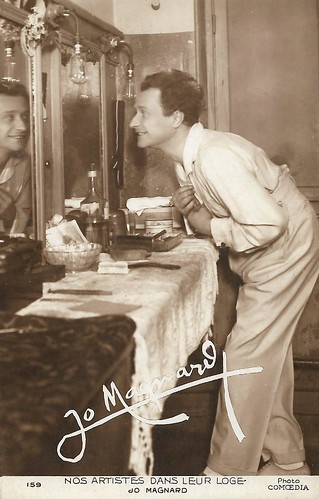
French postcard in the Series Nos artistes dans leur loge, no. 159. Photo: Comoedia.
While a Jo Magnard could not be found, this may have been the actor Jean Magnard (?-1924), aka Magnard. The earliest known film with him is the Pathé production La coupable (1911), with Henry Krauss and Stacia Napierkowska , about a woman who tries to prevent her sister's husband to kill her for adultery, by taking the blame on herself. In 1916 Magnard acted in Chignon d'or (André Hugon, 1916), starring Mistinguett as the title character. The film was shown last year at the Giornate del Cinema Muto within the Mistinguett retro, and deals with a vedette of the stage who amuses herself posing as a gigolette in the Parisian underworld, and has an affair with a count who is also posing as apache. Magnard plays the jealous real apache, called Le Frisé, causing trouble to the fake apaches of course. Magnard then acted in a comical short La chambre de la bonne (Georges Monca, 1918), in which he is he romantic hero, and La marque révélatrice (Maurice de Marsan, 1919). After a gap, Magnard acted in two more films, but minor parts: he was an apache in Soirée mondaine (Pierre Colombier, 1924) starring André Luguet , and André in L'étrange aventure (Robert Saidreau, 1924) about a husband (Pierre Etchepare) who wants his wife (Edmée Dormeuil) to remain submissive and plays a dirty trick on her. Magnard first had a stage career. Then he focused on music-hall, and performed in 'La revue des Folies Bergère' by Michel Carré and André Barde in 1913. In 1923 he married Maryse Tirville, music-hall artist like himself. While Magnard in 1924 still performed in a revue by Rip and Briquet at the theatre Chez Fursy et Mauricet, he died in October 1924 after a long and painful illness.
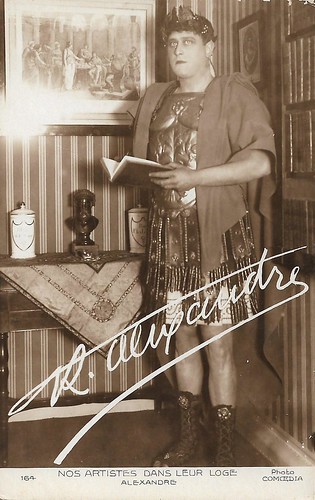
French postcard in the Nos artistes dans leur loge series, no. 164. Photo: Comoedia, Paris.
René Alexandre (1885-1946) was a French actor of the Comédie-Française. Between 1909 and 1940 he acted in some 53 films, mainly shorts by Pathé but also Antoine’s rural drama La Terre (1921).
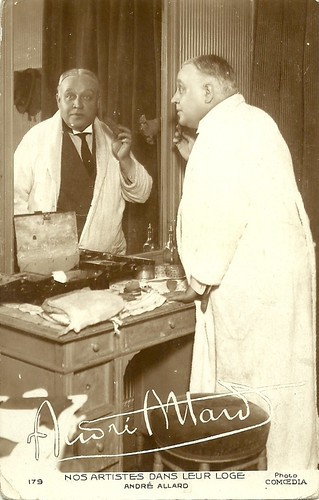
French postcard in the Series Nos artistes dans leur loge, no. 179. Photo: Comoedia.
André Allard (1874-1939) was a French opera and operetta singer. He studied singing at the Conservatoire de Paris and made his debut in 1897 at the Opéra National de Bordeaux. He entered the Parisian Opéra Comique in 1900, and was one of its stars between 1900 and 1910. In the early 1910s he starred at the Opéra de Monte-Carlo, while during WWI and the early 1920s, he returned to the Opéra-Comique. Allard only performed randomly in cinema: in 1920 he had the lead opposite Suzanne Bianchetti and André Nox in La Marseillaise (Henri Desfontaines, 1920), and in 1930 he had a supporting part in the French early sound film Le Requin (Henri Chomette, 1930).
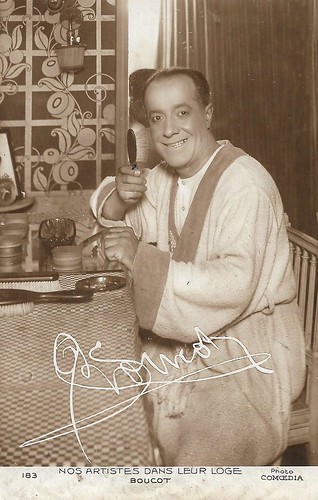
French postcard in the Series Nos artistes dans leur loge, no. 183. Photo: Comoedia. (See also no. 121).
Louis-Jacques Boucot aka Boucot (1882-1949) was a French stage and screen actor, famous for his comic characters of Pénard and Babylas. Just like the more famous Dranem , Boucot was a comical actor known for his vivacity and grimaces who knew a career from music-hall to cinema. Boucot started acting at Pathé Frères in 1910, first in Une petite femme bien douce (Georges Denola, 1910), scripted and performed by Mistinguett . By 1911 he had his own comedies such as Ami trop entreprenant (1911) and La dame de compagnie (1911), while in the same year he also developed the popular comic character of Babylas in various shorts directed by Alfred Machin. Sometimes, Machin's pet panther Mimir acted in these films too, such as in Babylas vient d'hériter d'une panthère (Alfred Machin, 1911). In 1912 Boucot also developed another character, Pénard, with whom he made even more short comedies (16 films in 1912-13), all for Pathé. During the First World War, Boucot could only be seen in one Babylas comedy, Babylas marraine (1917). After the war, he acted in only one film in the 1920s, La première idylle de Boucot (Robert Saidreau, 1920). He only returned to the screen when sound film had set in and would act in 14 films between 1930 and 1938, such as the drama Une femme a menti (Charles de Rochefort, 1930), the musical comedy Arthur (Léonce Perret, 1931) with Boucot in the lead, Le costaud des PTT (Jean Bertin, 1931) in which he sang several songs, La bonne aventure (Henri Diamant-Berger, 1932) with again Boucot in the lead, Brevet 95-75 (Pierre Miquel, 1934), and Le puritain (Jeff Musso, 1938).
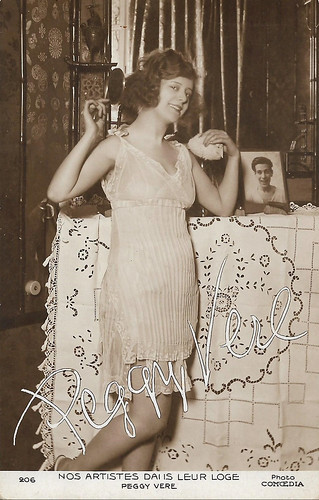
French postcard in the Series Nos artistes dans leur loge, no. 206. Photo: Comoedia.
Peggy Vere (?-?) was a British music-hall artist, dancer and singer, as well as a stage and screen actress. She debuted at the Parisian music-hall Concert Mayol and at the Théâtre des Variétés, then moved on to the Ambassadeurs and Casino de Paris in 1920. Between 1920 and 1940 she mostly performed at the Concert Mayol again. She was active in spreading the Lambeth Walk in France. De Vere debuted on the film screen in the propagandist drama Dans les ténèbres (Théo Bergerat, 1919). In 1923 she acted in La porteuse de pain (René Le Somptier, 1923), one of the many adaptations of Xavier de Montepin's popular novel, scripted by Germaine Dulac, and with Suzanne Desprès in the lead. In the comedy Ma tante d'Honfleur (Robert Saidreau, 1923) she played Albertine, opposite Jane Loury as the title character. In the early sound era she also played in two films, Le roi du camembert (Antoine Mourre, 1931), in which she had a lead as Miss Peggy Wood opposite Louis Rollin as the title character, and she played a supporting part in La dernière nuit (Jacques de Casembroot, 1933), starring Florelle .
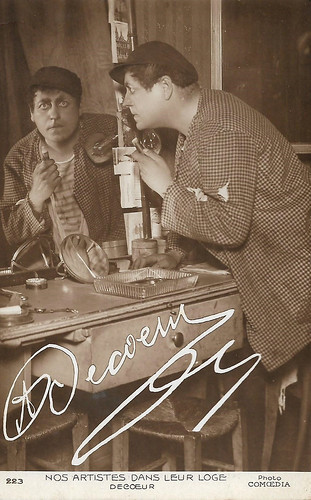
French postcard in the Series Nos artistes dans leur loge, no. 223. Photo: Comoedia.
Albert Decoeur (1879-?), aka Decoeur, was a French stage and screen actor. In 1911 he debuted in the film Le pouce, made by Gaston Roudès for the company Éclipse. In 1912 he played Francis Drake in the Pathé production Les amours de la reine Élisabeth (Henri Desfontaines, Louis Mercanton, 1912) starring Sarah Bernhardt and Lou Tellegen , followed by Adrienne Lecouvreur (Henri Desfontaines, Louis Mercanton, 1913) again with Bernhardt. In 1913 he continued at Éclipse with La sandale rouge (Henry Houry, 1913), while for the company Éclair he had the male lead in La bergère d'Ivry (Maurice Tourneur, 1913). In 1914 he played Thomas Wyatt in the Éclipse film Anne de Boleyn (1914), and had the lead of a detective fighting a gang in The Thumb Print (1914), a Gaumont film for which the French title is unknown. In 1920 Decoeur retook his screen career and would act in 12 films between 1920 and 1927, including La faute d'Odette Maréchal (1920), La fille des chiffonniers (1922), La bouquetière des innocents (1923), Les première armes de Rocambole (1924), Les amours de Rocambole (1924), Les deux gosses (1924), Mylord l'Arsouille (1925), Jean Chouan (1926), L'espionne aux yeux noirs (1926), La petite bonne du palace (1926), Le capitaine Rascasse (1927), and Casanova (1927). Often these were historical drama and adventure films. Memorable were Decoeur's major supporting parts as the evil Bamboche in La fille des chiffonniers, Jacques Bonhomme in La bouquetière des innocents, and Sir William in the Rocambole films, though he never was the male lead in his films anymore. His last film Decoeur did, was the sound film La châtelaine du Liban (Jean Epstein, 1934), starring Spinelly and Jean Murat .
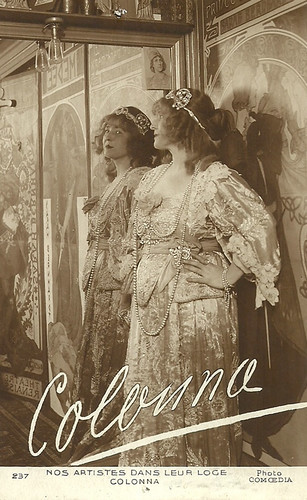
French postcard in the Series Nos artistes dans leur loge, no. 237. Photo: Comoedia.
Gabrielle Dreyfuss, better known as (Gabrielle) Colonna-Romano aka Colonna (1883-1981) was a French stage and screen actress. A pupil and devotee of Sarah Bernhardt , Colonna Romano became a member of the Comédie-Française from 1913 to 1936. She was famous for her roles as tragedienne, and she gave numerous plays and poetry readings, notably by the poet Saint-Pol-Roux. She was also a favourite model of the Impressionist painter Auguste Renoir for several of his paintings, notably 'Jeune femme à la rose' (1913), while she had an affair with his son Pierre until he left her for the actress Vera Sergine . In 1916 Romano married actor Georges Grand (1863-1921), who died of a heart attack at the age of 56. In 1939 she married actor Pierre Alcover (1893-1957). Both her husbands were actors from the Comédie-Française. Colonna-Romano can be seen acting in the documentary Un soir à la Comédie-Française (Léonce Perret, 1935). Between 1908 and 1913 she also acted in such Film d'art shorts as Hamlet (Henri Desfontaines, 1908), in which she played Queen Gertrude, Hop-Frog (Henri Desfontaines, 1910), and L'Honneur (Albert Capellani, 1910).
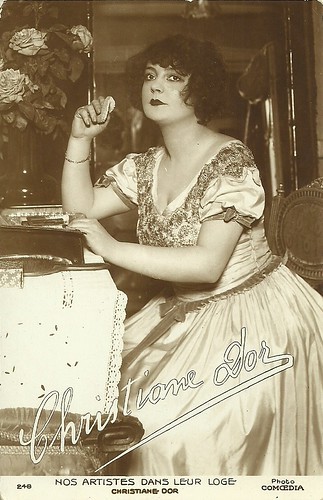
French postcard in the Series Nos artistes dans leur loge, no. 248. photo: Comoedia.
Christiane Dor (1892-1939) was a French stage and screen actress and singer, who was a star in 1920s French operettas and musical comedies. Apart from one French silent film, she acted in some 25 French sound films between 1932 and 1936. Notable films with her were Poil de carotte (Julien Duvivier, 1932) with Robert Lynen in the title role and Harry Baur , and Pomme d'amour (Jean Dréville, 1932), with André Perchicot and Raymond Cordy, followed by Madame Bovary (Jean Renoir, 19330, with Valentine Tessier in the title role and Renoir himself, and Cette vieille canaille (Anatole Litvak, 1933) with Harry Baur and Pierre Blanchar .
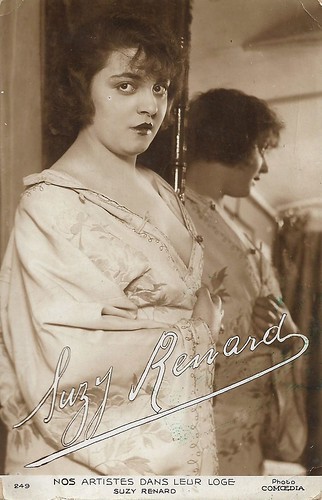
French postcard in the Series Nos artistes dans leur loge, no. 249. photo: Comoedia.
Suzy Renard (?-?) was a stage actress who had a small film career too. Renard did the Conservatoire in Paris, but according to the stage journal La Rampe she received a harsh judgement by the jury in 1918, although she won second prize in the category Comedy. The same year she joined a tour around France with the play 'La Reine Wanda', starring Pierre Magnier. In 1919, the Comédie Française engaged Renard for its summer tour, where she debuted in 'Le Dépit amoureux'. December 1919 she acted at the Comédie française in 'Les Soeurs d'amour' by Bataille, starring Léon Bernard. Renard, though, never became a pensionnaire nor a sociétaire of the Comédie. In the satirical journal Les Potins de Paris, her collaboration with the respectful Comédie Française was even criticised and ridiculed.Renard left the Comédie after one year and focused on light comedy on the stage. In 1921 she played a supporting part in 'Le Chasseur de chez Maxim's', performed at the Théâtre du Palais-Royal. Renard debuted in cinema in the Gaumont drama Le Noël d'Yveline (Georges-André Lacroix, 1918), with Suzy Prim and Simone Vaudry . In 1920 she was with Blanche Ritier in the Film d'Art production Illusions (Jean Manoussi, 1920). Her last part according to IMDb was in the shor, La revanche de Suzanne (1921), for whom the director is unknown. Renard seems also to have played in a Feydeau adaptation, the comedy Un fil à la patte (Robert Saidreau, 1924) starring Armand Bernard . In it, the actress is credited at IMDB as Suzanne Renard, but papers from 1924 indicate it was Suzy.
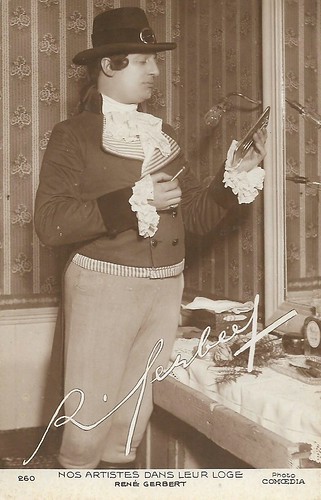
French postcard in the Series Nos artistes dans leur loge, no. 260. Photo: Comoedia.
René Gerbert (?-?) was a popular French operetta singer of the 1920s and early 1930s, for a long time engaged to the Théâtre de la Gaité-Lyrique. In 1921 he sang there the part of Tromboli in Franz von Suppé's 'Boccaccio'. Around 1929-1930, Gerbert was most prominent at the Théâtre de la Gaité-Lyrique when performing the title character in the operetta 'Mr. Beaucaire'. As far as can be traced he didn't act in films, while his voice could be heard singing 'Les gars de la marine' and 'Quand la brise vagabonde' in Le capitaine Craddock (Hanns Schwarz, Max de Vaucorbeil, 1931), the French version of Bomben auf Monte Carlo/Bombs Over Monte Carlo (Hanns Schwarz, 1931). The songs were released on records too, just like several of Gerbert's operetta songs like 'Tous nous charme' from Emmerich Kalman's 'Die Czardasprinzessin'.
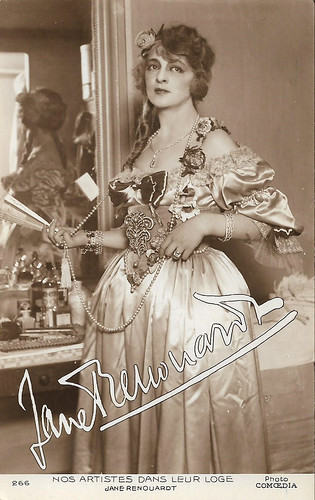
French postcard in the Series Nos artistes dans leur loge, no. 266. Photo: Comoedia.
Jane Renouardt aka Jane Renouard (1890–1972), born Victorine Catherine Renouard, was a French actress of the silent screen. She played Jane, the partner of Max Linder , in many of his short comedies for Pathé Frères. During the First World War she acted in various feature films, such as the pantomime L'Enfant prodigue (Michel Carré, André Wormser, 1916) with Cécile Guyon as Pierrot and Renouardt as 'his' beloved Phrynette, and the tragedy Clown/Le Clown (1917) by and starring Maurice de Féraudy , as an old clown who kills himself for his son (René Rocher). In 1919 Renouardt did her last film, En quatrième vitesse, by Marcel Simon. She was the first manager of the Theater Danou, which opened in 1921. In 1936 she married the actor Fernand Gravey .
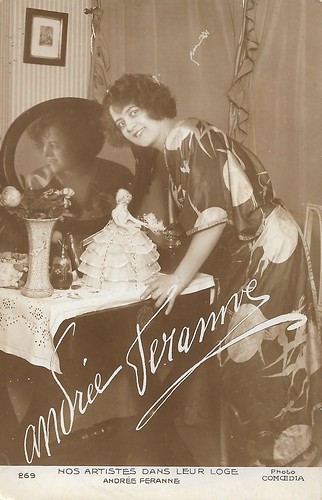
French postcard in the Series Nos artistes dans leur loge, no. 269. Photo: Comoedia.
Little is known about French actress Andrée Féranne. She acted in one film: Vers l'argent ( René Plaissetty, 1920), starring Mary Massart.
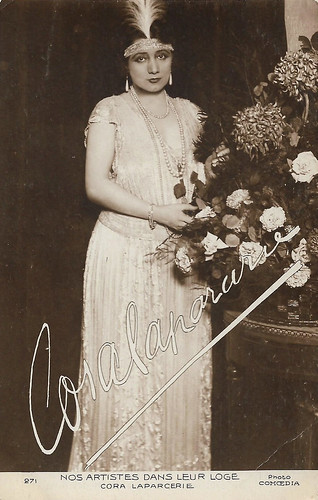
French postcard in the Series Nos artistes dans leur loge, no. 271. Photo: Comoedia.
Marie-Caroline Laparcerie, better known as Cora Laparcerie (1875-1951), was an actress, poetess and French theatre director. Laparcerie was noticed by the actor Coquelin Sr. and began her career at the Théâtre de l'Odéon in Paris in 1896, before performing around the world. She acted in particular in tragedies set in Antiquity or ancient mythology such as 'Dejanira', 'Fausta', 'Prométhée', and 'Lysistrata', of which some were staged by the Odeon players in the Summer season at the Théâtre des Arènes at Béziers. In 1901, she married the poet Jacques Richepin, whose works she interpreted. Laparcerie was director of several Parisian theatres, notably the Bouffes-Parisiens theatre (1907 or 1909-1913), the Renaissance theatre (1913-1928), the Mogador theatre (1923-1924) - rebaptised Théâtre Cora Laparcerie but too costly an adventure, so she returned to the Renaissance theatre in 1925. In 1926, Laparcerie received the Legion of Honour, but fell seriously ill in 1927. She had to stop her theatrical career, and took a three-year leave to the Côte d'Azur with her family. However, she continued to direct, became a columnist in the magazine Comœdia and created radio theatre on 9 June 1935 by performing on Radio-Paris 'La Vraie Carmen'. As far is known, Laparcerie didn't perform in films.
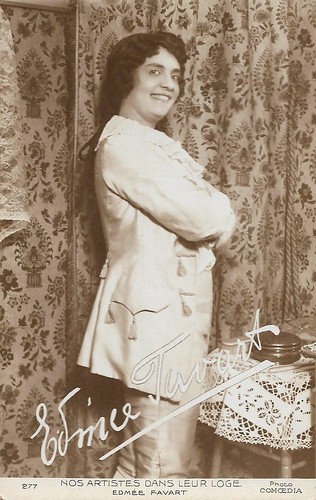
French postcard in the Series Nos artistes dans leur loge, no. 277. Photo: Comoedia.
Edmée Favart (1879-1941) was a French singer and the daughter of baritone, director and manager of French operas, Edmond Favart. As far as known, she acted in only one film: Mannequins (René Hervil, 1933).
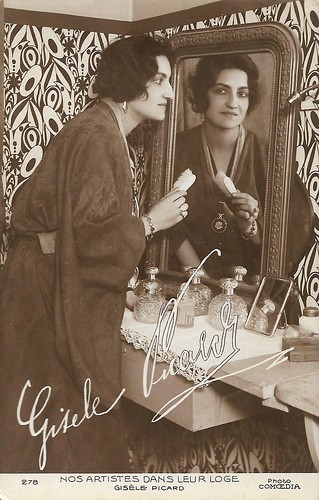
French postcard in the Series Nos artistes dans leur loge, no. 278. Photo: Comoedia, Paris.
Gisèle Picard was a French stage actress, who performed at the Odeon in Paris in the 1920s. She was the older sister of the more known actress Nadine Picard. While Nadine Picard acted in some 18 films, her sister is not mentioned at IMDb.
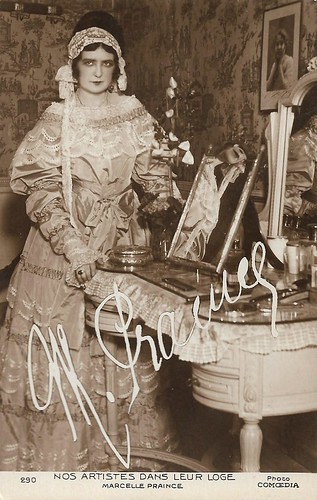
French postcard in the Series Nos artistes dans leur loge, no. 290. Photo: Comoedia, Paris.
Marcelle Praince (1882–1969) was a French stage and screen actress, who debuted on stage around 1905 and had a first peak in her film career in the Pathé comedies with Prince . From 1930 until the mid-1950s, she had a rich career in French sound cinema, playing grandmothers, concierges, old countesses, and even fortunetellers, in over 50 films. Memorable titles were a.o. Rive gauche (Alexander Korda, 1931), La Vie parisienne (Robert Siodmak, 1936), Maman Colibri (Jean Dréville, 1937), Félicie Nanteuil (Marc Allégret, 1942/1945), Impasse des Deux-Anges (Maurice Tourneur, 1948), and Sous le ciel de Paris (Julien Duvivier, 1951). Praince had her last major film part in Chaque jour a son secret (Claude Boissol, 1958). In 1959, she stopped with acting on stage too.
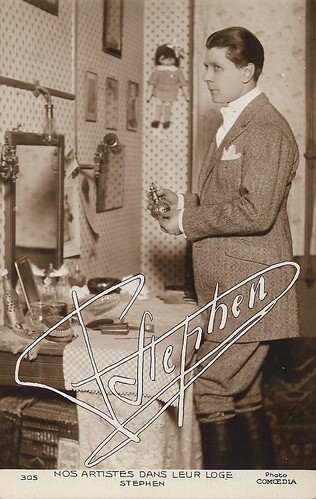
French postcard in the Series Nos artistes dans leur loge, no. 305. Photo: Comoedia, Paris.
Pierre Stéphen (1890–1980), originally Pierre Trambouze, was a French stage and screen actor. In 1906 he entered the Conservatoire, after which he was hired by the Odeon theater and started using his stage name. In 1920 he married the actress Yvonne Thénard and started his film career, acting in over 70 films between 1920 and 1962, often in the part of the stupid, shy and stammering lover. Memorable titles are Le double piège (Gaston Roudès, 1923), Les mufles (Robert Péguy, 1929) with Suzanne Bianchetti , Cette vieille canaille (Anatole Litvak, 1933) with Harry Baur , Au son des guitares (Pierre-Jean Ducis, 1936) with Tino Rossi , On ne roule pas Antoinette (Paul Madeux, 1936) with Armand Bernard , Les trois valses (Ludwig Berger, 1938) with Yvonne Printemps , and the TV film La dame aux camélias (François Gir, 1962).
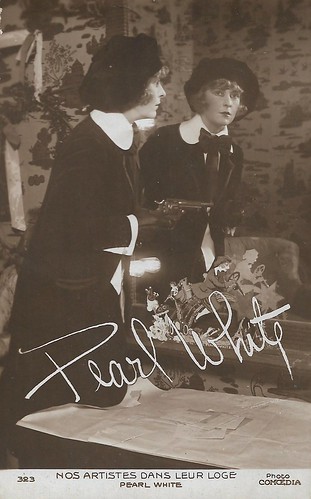
French postcard in the Series Nos artistes dans leur loge, no. 323. Photo: Comoedia, Paris.
Pearl White (1889-1938) was dubbed 'Queen of the Serials', and noted for doing her own stunts, in silent film serials such as The Perils of Pauline (1914) and The Exploits of Elaine (1914-1915). Many episodes ended with a literal cliffhanger. In Europe, The Exploits of Elaine were re-edited with two subsequent serials into Les Mystères de New York. Until the end of the First World War, White remained globally a popular action heroine.
NB. The 'Nos artistes dans leur loge' postcards were published in or before 1924, as in that year the journal Comoedia published the full list of all cards from the series.
Sources: Fondation Jerome Seydoux (French), Les étoiles de l'Opera de Paris (French), Les archives du spectacle (French), Giornate del cinema muto, Gallica, Wikipedia (French) and IMDb.

French postcard in the Nos artistes dans leur loge series, no. 52. Photo: Comoedia, Paris.
André Calmettes (1861-1942) was a French stage and screen actor an director. After being a stage actor for twenty years, Calmettes became artistic director and director of the company Le Film d'Art, founded by the Laffitte brothers. Its films were distributed by Pathé Frères. Until the early 1920s he acted on stage, mainly at the Parisian theatres Odéon, Vaudeville, Gymnase, and Porte St. Martin.

French postcard in the Series Nos artistes dans leur loge, no. 56. Photo: Comoedia.
Christiane Delval (?-?) acted as child actress in eight French silent films in the early 1920s, starting with the drama Face à l’océan (René Leprince, 1920). That year, Delval also acted in Le petit poucet (Robert Boudrioz, 1920) and Fabienne (Camille de Morlhon, 1920). Delval acted as young Geneviève and Palôtte in the four episodes of the family drama Gigolette (Henry Pouctal, 1921). Other films Delval acted in were the Zola adaptation Le rêve (Jacques de Baroncelli, 1920) with Gabriel Signoret and Andrée Brabant , La tentation (Henry de Golen, 1921) with Georges Wague , La folie du doute (René Leprince, 1923) with Jean Dax , and Pour une nuit d'amour (Yakov Protazanov, 1923) with Edmond Van Daële. In 1931 Delval acted in the French early sound comedy Plein la vue (Edmond Carlus, 1931), shot at the Tobis studios in Epinay, while her last part was in the comedy Dora Nelson (René Guissart, 1935) starring Elvire Popesco . Delval also acted on stage.

French postcard in the Series Nos artistes dans leur loge, no. 57. Photo: Comoedia.
Christiane Delval (?-?) acted as a child actress in eight French silent films in the early 1920s, starting with the drama Face à l’océan (René Leprince, 1920). In 1920 Delval also acted in Le petit poucet (Robert Boudrioz, 1920) and Fabienne (Camille de Morlhon, 1920). In 1921 Delval acted as young Geneviève and Palôtte in the four episodes of the family drama Gigolette (Henry Pouctal, 1921). Other films Delval acted in were the Emile Zola adaptation Le rêve (Jacques de Baroncelli, 1920) with Gabriel Signoret and Andrée Brabant , La tentation (Henry de Golen, 1921) with Georges Wague, La folie du doute (René Leprince, 1923) with Jean Dax , and Pour une nuit d'amour (Yakov Protazanov, 1923) with Edmond Van Daële. In 1931 Delval acted in the French early sound comedy Plein la vue (Edmond Carlus, 1931) starring Raymond Dandy and shot at the Tobis studios in Epinay, while her last part was in the comedy Dora Nelson (René Guissart, 1935) starring Elvire Popesco .

French postcard in the Series Nos artistes dans leur loge, no. 80. Photo: Comoedia.
Little is known about Maud Strassel but shat was a performer in revues and operettas in the early 1920s. In those years she played Aphasie in the operetta 'Phi-Phi' at the Bouffes Parisiens, and also performed e.g. at the Folies-Bergère and the Théàtre de la Gaité-Lyrique. As far as known she did not act in cinema.

French postcard in the Series Nos artistes dans leur loge, no. 98. Photo: Comoedia.
Camille Bos (born 1899) was a French ballet dancer. At the age of 10, she entered the ballet school of the Paris Opera. In 1920 she was named 'première danseuse', and in 1925 she was promoted to 'danseuse étoile/star dancer'. Bos participated in numerous performances e.g. 'Siang-Sin' (1927), 'L'écran des jeunes filles' (1929) and 'La Grisi' (1935). Her partners included the famous Serge Peretti and Serge Lifar with whom she danced in 'Le Spectre de la Rose' (1931) by Michel Fokine. At the age of 36 she stopped dancing to dedicate herself to teaching. For 12 years she taught at the Opéra de Paris. Her only known film performance was as a dancer in the Zola adaptation Nantas (Donatien, 1925), starring Donatien , Lucienne Legrand, and Maxime Desjardins .

French postcard in the Series Nos artistes dans leur loge, no. 102. Photo: Comoedia
Little is known about singer/actress Inga Agni. In the early 1920s she performed at the Folies-Bergère, e.g. in the revue 'C'est la folie', and at the Casino de Paris, e.g. in the revue 'Y a qu' Paris!' with Dorville. She probably never acted in cinema.

French postcard in the Series Nos artistes dans leur loge, no. 103. Photo: Comoedia.
Lucette Darbelle (?-1943), originally Louise Silvain, was a French operetta singer. She probably didn't act in film. Darbelle became a Parisian vedette after the success of her part of Madame Phidias in Phi-Phi in 1921. She was e.g. part of the troupe of 'La Revue des Étoiles '(1922), starring American crime serial queen Pearl White. She had a fatal ending during the war: because of a relationship with a German officer, she was strangled with a telephone cable. Not to be confused with the actress Louise Silvain (1874–1930), wife of actor Eugène Silvain .

French postcard in the Series Nos artistes dans leur loge, no. 104. Photo: Comoedia.
French actress and operetta singer Mary-Hett (?-?) was already around 1900 a popular Parisian café-concert singer and would remain so for decades. In the late 1890s Edouard Marchand overtook the Parisian theatre Eldorado, appointed Leon Garnier as director and the latter composed a group of newcomers among whom a few would become very popular such as Mistinguett and Dranem . Mary Hett was also among these newcomers. She was also a popular actress in revues at the Folies-Bergères and sang at the Scala. In 1909-1910, she played Conchita in 'L'Amour en Espagne', which revived the French operetta after its fall, while in 1915 she starred in the comic operetta 'Antonio Toréador'. She would remain highly active operetta singer all through the 1920s, in operettas mostly by Maurice Yvain, including 'La dame en rose' (1921), the extremely popular 'Ta bouche' (1922-1931, with reprisals in 1936, 1940 and 1944), and 'La dame en décolleté' (1923-1925). Mary Hett acted in a handful of short films in the early cinema. In 1909 she started at Pathé Frères in the comedy Octave (1909) with a young Harry Baur , the comedy Le Roman d’une bottine et d’un escarpin (Georges Monca, 1909), L'Infidélité d’Ernest (1910) with Prince , and the drama Le Bon agent (Georges Monca, 1910). Under the name of Miss Ellynett, Hett also acted in the comedy Mariage à l’espagnole (Michel Carré, 1909) and La Malle du peintre (1910) with Prince . Later, she acted in the Lux production Un bal d'apaches dans le grand monde (André Heuzé, 1912), and was one of the leads in the two-reeler comedy Deux maris, deux femmes et un commissaire (1917), about a presumed adultery cleared before the police. The title of the feature-length silent comedy Miss Helyett (Georges Monca, Maurice Kéroul, 1928) seems to hint at Hett's earlier used pseudonym. Hett herself also had a major part in the film as a Spanish senorita, though the title role was for Marie Glory . It was her last film role.

French postcard in the Nos artistes dans leur loge series, no. 121. Photo: Comoedia, Paris.
Louis-Jacques Boucot aka Boucot (1882-1949) was a French stage and screen actor, famous for his comic characters of Pénard and Babylas.

French postcard in the Nos artistes dans leur loge series, no. 132. Photo: Comoedia.
Jean Hervé (1884-1966) was a French stage and screen actor, known for his work at the Comédie-Française but also for his parts in Film d'Art cinema, the Rocambole films, La Terre (1921) and Feu Mathias Pascal (1926).

French postcard in the Series Nos artistes dans leur loge, no. 137. Photo: Comoedia.
Paul Gerbault (?-?) was an esteemed French stage actor, who also played in a handful of films. As far as can be reconstructed, he acted at the Comédie-Française from 1912 onward, first in Le Ménage de Molière (1912). He alternated the classics of Molière, Corneille, Euripides, Sophocles, and Hugo, with modern repertory by Bataille, Bernard, and Ibsen. In 1931 Gerbault acted in his last Comédie performance, 'Patrie!' by Sardou, directed by Émile Fabre, and starring Albert Lambert fils and an all-star cast. The play was reprised in 1932, with Gerbault again acting, by the Théâtre National Populaire. Gerbault's last part was that of Orgon in Molière's classic 'Tartuffe', in 1935 at the Théâtre du Vieux-Colombier.In the cinema, Gerbault acted in the historical drama La Jacquerie, révolution paysanne de 1358 (Henri Pouctal, 1911), a Pathé production on a farmer's rebellion in the Middle Ages. He played Colline in the Pathé drama La Bohème (Albert Capellani, 1912) with Paul Capellani as Rodolphe and Suzanne Revonne as Mimí. In 1914 he acted opposite Léon Bernard in Sa majesté l'argent (Adrien Caillard, 1914). After a long absence from the screen, Gerbault returned as Dr. Boudon in Le crime du Bouif (1922), starring the popular comedian Tramel . His last film part was that of the judge in La main qui a tué (Maurice de Marsan, Maurice Gleize, 1924). The costume on the postcard reminds this part. Gina Manès played the lead in this film.

French postcard in the Series Nos artistes dans leur loge, no. 145. Photo: Comoedia.
French stage and screen actress Suzanne Nivette (1895-1995) debuted on screen as Eponine in Les Misérables (Henri Fescourt, 1925), based on Victor Hugo's classical novel, while in 1921 she had debuted on stage in the theatrical version of the same source. This was her only silent film part, as only from 1934 she had a steady career as film actress in the French sound cinema, which would end in 1960 and include some 20 films. One of her last film parts would be in another adaptation of Les Misérables (1958), now playing Mademoiselle Gillesnormand. In addition to film, Nivette had a rich stage career. Her last part evolved at the Comédie Française in the early 1950s. Suzanne Nivette would become 100. She was married to the actor Georges Saillard (1877-1967).

French postcard in the Series Nos artistes dans leur loge, no. 149. Photo: Comoedia.
René Rocher (1890–1970) was a France stage actor and theater director. In 1923, Rocher gave its name to the current Comédie-Caumartin. He was managing director of the Théâtre Antoine from 1928 to 1933, then of the Théâtre du Vieux-Colombier from 1935 to 1943, and of the Théâtre de l'Odéon from 1940 to 1944. In the 1910s he acted in four films, a.o. Le coupable (André Antoine, 1917) and Blessée au coeur (director unknown, 1917).

French postcard in the Series Nos artistes dans leur loge, no. 159. Photo: Comoedia.
While a Jo Magnard could not be found, this may have been the actor Jean Magnard (?-1924), aka Magnard. The earliest known film with him is the Pathé production La coupable (1911), with Henry Krauss and Stacia Napierkowska , about a woman who tries to prevent her sister's husband to kill her for adultery, by taking the blame on herself. In 1916 Magnard acted in Chignon d'or (André Hugon, 1916), starring Mistinguett as the title character. The film was shown last year at the Giornate del Cinema Muto within the Mistinguett retro, and deals with a vedette of the stage who amuses herself posing as a gigolette in the Parisian underworld, and has an affair with a count who is also posing as apache. Magnard plays the jealous real apache, called Le Frisé, causing trouble to the fake apaches of course. Magnard then acted in a comical short La chambre de la bonne (Georges Monca, 1918), in which he is he romantic hero, and La marque révélatrice (Maurice de Marsan, 1919). After a gap, Magnard acted in two more films, but minor parts: he was an apache in Soirée mondaine (Pierre Colombier, 1924) starring André Luguet , and André in L'étrange aventure (Robert Saidreau, 1924) about a husband (Pierre Etchepare) who wants his wife (Edmée Dormeuil) to remain submissive and plays a dirty trick on her. Magnard first had a stage career. Then he focused on music-hall, and performed in 'La revue des Folies Bergère' by Michel Carré and André Barde in 1913. In 1923 he married Maryse Tirville, music-hall artist like himself. While Magnard in 1924 still performed in a revue by Rip and Briquet at the theatre Chez Fursy et Mauricet, he died in October 1924 after a long and painful illness.

French postcard in the Nos artistes dans leur loge series, no. 164. Photo: Comoedia, Paris.
René Alexandre (1885-1946) was a French actor of the Comédie-Française. Between 1909 and 1940 he acted in some 53 films, mainly shorts by Pathé but also Antoine’s rural drama La Terre (1921).

French postcard in the Series Nos artistes dans leur loge, no. 179. Photo: Comoedia.
André Allard (1874-1939) was a French opera and operetta singer. He studied singing at the Conservatoire de Paris and made his debut in 1897 at the Opéra National de Bordeaux. He entered the Parisian Opéra Comique in 1900, and was one of its stars between 1900 and 1910. In the early 1910s he starred at the Opéra de Monte-Carlo, while during WWI and the early 1920s, he returned to the Opéra-Comique. Allard only performed randomly in cinema: in 1920 he had the lead opposite Suzanne Bianchetti and André Nox in La Marseillaise (Henri Desfontaines, 1920), and in 1930 he had a supporting part in the French early sound film Le Requin (Henri Chomette, 1930).

French postcard in the Series Nos artistes dans leur loge, no. 183. Photo: Comoedia. (See also no. 121).
Louis-Jacques Boucot aka Boucot (1882-1949) was a French stage and screen actor, famous for his comic characters of Pénard and Babylas. Just like the more famous Dranem , Boucot was a comical actor known for his vivacity and grimaces who knew a career from music-hall to cinema. Boucot started acting at Pathé Frères in 1910, first in Une petite femme bien douce (Georges Denola, 1910), scripted and performed by Mistinguett . By 1911 he had his own comedies such as Ami trop entreprenant (1911) and La dame de compagnie (1911), while in the same year he also developed the popular comic character of Babylas in various shorts directed by Alfred Machin. Sometimes, Machin's pet panther Mimir acted in these films too, such as in Babylas vient d'hériter d'une panthère (Alfred Machin, 1911). In 1912 Boucot also developed another character, Pénard, with whom he made even more short comedies (16 films in 1912-13), all for Pathé. During the First World War, Boucot could only be seen in one Babylas comedy, Babylas marraine (1917). After the war, he acted in only one film in the 1920s, La première idylle de Boucot (Robert Saidreau, 1920). He only returned to the screen when sound film had set in and would act in 14 films between 1930 and 1938, such as the drama Une femme a menti (Charles de Rochefort, 1930), the musical comedy Arthur (Léonce Perret, 1931) with Boucot in the lead, Le costaud des PTT (Jean Bertin, 1931) in which he sang several songs, La bonne aventure (Henri Diamant-Berger, 1932) with again Boucot in the lead, Brevet 95-75 (Pierre Miquel, 1934), and Le puritain (Jeff Musso, 1938).

French postcard in the Series Nos artistes dans leur loge, no. 206. Photo: Comoedia.
Peggy Vere (?-?) was a British music-hall artist, dancer and singer, as well as a stage and screen actress. She debuted at the Parisian music-hall Concert Mayol and at the Théâtre des Variétés, then moved on to the Ambassadeurs and Casino de Paris in 1920. Between 1920 and 1940 she mostly performed at the Concert Mayol again. She was active in spreading the Lambeth Walk in France. De Vere debuted on the film screen in the propagandist drama Dans les ténèbres (Théo Bergerat, 1919). In 1923 she acted in La porteuse de pain (René Le Somptier, 1923), one of the many adaptations of Xavier de Montepin's popular novel, scripted by Germaine Dulac, and with Suzanne Desprès in the lead. In the comedy Ma tante d'Honfleur (Robert Saidreau, 1923) she played Albertine, opposite Jane Loury as the title character. In the early sound era she also played in two films, Le roi du camembert (Antoine Mourre, 1931), in which she had a lead as Miss Peggy Wood opposite Louis Rollin as the title character, and she played a supporting part in La dernière nuit (Jacques de Casembroot, 1933), starring Florelle .

French postcard in the Series Nos artistes dans leur loge, no. 223. Photo: Comoedia.
Albert Decoeur (1879-?), aka Decoeur, was a French stage and screen actor. In 1911 he debuted in the film Le pouce, made by Gaston Roudès for the company Éclipse. In 1912 he played Francis Drake in the Pathé production Les amours de la reine Élisabeth (Henri Desfontaines, Louis Mercanton, 1912) starring Sarah Bernhardt and Lou Tellegen , followed by Adrienne Lecouvreur (Henri Desfontaines, Louis Mercanton, 1913) again with Bernhardt. In 1913 he continued at Éclipse with La sandale rouge (Henry Houry, 1913), while for the company Éclair he had the male lead in La bergère d'Ivry (Maurice Tourneur, 1913). In 1914 he played Thomas Wyatt in the Éclipse film Anne de Boleyn (1914), and had the lead of a detective fighting a gang in The Thumb Print (1914), a Gaumont film for which the French title is unknown. In 1920 Decoeur retook his screen career and would act in 12 films between 1920 and 1927, including La faute d'Odette Maréchal (1920), La fille des chiffonniers (1922), La bouquetière des innocents (1923), Les première armes de Rocambole (1924), Les amours de Rocambole (1924), Les deux gosses (1924), Mylord l'Arsouille (1925), Jean Chouan (1926), L'espionne aux yeux noirs (1926), La petite bonne du palace (1926), Le capitaine Rascasse (1927), and Casanova (1927). Often these were historical drama and adventure films. Memorable were Decoeur's major supporting parts as the evil Bamboche in La fille des chiffonniers, Jacques Bonhomme in La bouquetière des innocents, and Sir William in the Rocambole films, though he never was the male lead in his films anymore. His last film Decoeur did, was the sound film La châtelaine du Liban (Jean Epstein, 1934), starring Spinelly and Jean Murat .

French postcard in the Series Nos artistes dans leur loge, no. 237. Photo: Comoedia.
Gabrielle Dreyfuss, better known as (Gabrielle) Colonna-Romano aka Colonna (1883-1981) was a French stage and screen actress. A pupil and devotee of Sarah Bernhardt , Colonna Romano became a member of the Comédie-Française from 1913 to 1936. She was famous for her roles as tragedienne, and she gave numerous plays and poetry readings, notably by the poet Saint-Pol-Roux. She was also a favourite model of the Impressionist painter Auguste Renoir for several of his paintings, notably 'Jeune femme à la rose' (1913), while she had an affair with his son Pierre until he left her for the actress Vera Sergine . In 1916 Romano married actor Georges Grand (1863-1921), who died of a heart attack at the age of 56. In 1939 she married actor Pierre Alcover (1893-1957). Both her husbands were actors from the Comédie-Française. Colonna-Romano can be seen acting in the documentary Un soir à la Comédie-Française (Léonce Perret, 1935). Between 1908 and 1913 she also acted in such Film d'art shorts as Hamlet (Henri Desfontaines, 1908), in which she played Queen Gertrude, Hop-Frog (Henri Desfontaines, 1910), and L'Honneur (Albert Capellani, 1910).

French postcard in the Series Nos artistes dans leur loge, no. 248. photo: Comoedia.
Christiane Dor (1892-1939) was a French stage and screen actress and singer, who was a star in 1920s French operettas and musical comedies. Apart from one French silent film, she acted in some 25 French sound films between 1932 and 1936. Notable films with her were Poil de carotte (Julien Duvivier, 1932) with Robert Lynen in the title role and Harry Baur , and Pomme d'amour (Jean Dréville, 1932), with André Perchicot and Raymond Cordy, followed by Madame Bovary (Jean Renoir, 19330, with Valentine Tessier in the title role and Renoir himself, and Cette vieille canaille (Anatole Litvak, 1933) with Harry Baur and Pierre Blanchar .

French postcard in the Series Nos artistes dans leur loge, no. 249. photo: Comoedia.
Suzy Renard (?-?) was a stage actress who had a small film career too. Renard did the Conservatoire in Paris, but according to the stage journal La Rampe she received a harsh judgement by the jury in 1918, although she won second prize in the category Comedy. The same year she joined a tour around France with the play 'La Reine Wanda', starring Pierre Magnier. In 1919, the Comédie Française engaged Renard for its summer tour, where she debuted in 'Le Dépit amoureux'. December 1919 she acted at the Comédie française in 'Les Soeurs d'amour' by Bataille, starring Léon Bernard. Renard, though, never became a pensionnaire nor a sociétaire of the Comédie. In the satirical journal Les Potins de Paris, her collaboration with the respectful Comédie Française was even criticised and ridiculed.Renard left the Comédie after one year and focused on light comedy on the stage. In 1921 she played a supporting part in 'Le Chasseur de chez Maxim's', performed at the Théâtre du Palais-Royal. Renard debuted in cinema in the Gaumont drama Le Noël d'Yveline (Georges-André Lacroix, 1918), with Suzy Prim and Simone Vaudry . In 1920 she was with Blanche Ritier in the Film d'Art production Illusions (Jean Manoussi, 1920). Her last part according to IMDb was in the shor, La revanche de Suzanne (1921), for whom the director is unknown. Renard seems also to have played in a Feydeau adaptation, the comedy Un fil à la patte (Robert Saidreau, 1924) starring Armand Bernard . In it, the actress is credited at IMDB as Suzanne Renard, but papers from 1924 indicate it was Suzy.

French postcard in the Series Nos artistes dans leur loge, no. 260. Photo: Comoedia.
René Gerbert (?-?) was a popular French operetta singer of the 1920s and early 1930s, for a long time engaged to the Théâtre de la Gaité-Lyrique. In 1921 he sang there the part of Tromboli in Franz von Suppé's 'Boccaccio'. Around 1929-1930, Gerbert was most prominent at the Théâtre de la Gaité-Lyrique when performing the title character in the operetta 'Mr. Beaucaire'. As far as can be traced he didn't act in films, while his voice could be heard singing 'Les gars de la marine' and 'Quand la brise vagabonde' in Le capitaine Craddock (Hanns Schwarz, Max de Vaucorbeil, 1931), the French version of Bomben auf Monte Carlo/Bombs Over Monte Carlo (Hanns Schwarz, 1931). The songs were released on records too, just like several of Gerbert's operetta songs like 'Tous nous charme' from Emmerich Kalman's 'Die Czardasprinzessin'.

French postcard in the Series Nos artistes dans leur loge, no. 266. Photo: Comoedia.
Jane Renouardt aka Jane Renouard (1890–1972), born Victorine Catherine Renouard, was a French actress of the silent screen. She played Jane, the partner of Max Linder , in many of his short comedies for Pathé Frères. During the First World War she acted in various feature films, such as the pantomime L'Enfant prodigue (Michel Carré, André Wormser, 1916) with Cécile Guyon as Pierrot and Renouardt as 'his' beloved Phrynette, and the tragedy Clown/Le Clown (1917) by and starring Maurice de Féraudy , as an old clown who kills himself for his son (René Rocher). In 1919 Renouardt did her last film, En quatrième vitesse, by Marcel Simon. She was the first manager of the Theater Danou, which opened in 1921. In 1936 she married the actor Fernand Gravey .

French postcard in the Series Nos artistes dans leur loge, no. 269. Photo: Comoedia.
Little is known about French actress Andrée Féranne. She acted in one film: Vers l'argent ( René Plaissetty, 1920), starring Mary Massart.

French postcard in the Series Nos artistes dans leur loge, no. 271. Photo: Comoedia.
Marie-Caroline Laparcerie, better known as Cora Laparcerie (1875-1951), was an actress, poetess and French theatre director. Laparcerie was noticed by the actor Coquelin Sr. and began her career at the Théâtre de l'Odéon in Paris in 1896, before performing around the world. She acted in particular in tragedies set in Antiquity or ancient mythology such as 'Dejanira', 'Fausta', 'Prométhée', and 'Lysistrata', of which some were staged by the Odeon players in the Summer season at the Théâtre des Arènes at Béziers. In 1901, she married the poet Jacques Richepin, whose works she interpreted. Laparcerie was director of several Parisian theatres, notably the Bouffes-Parisiens theatre (1907 or 1909-1913), the Renaissance theatre (1913-1928), the Mogador theatre (1923-1924) - rebaptised Théâtre Cora Laparcerie but too costly an adventure, so she returned to the Renaissance theatre in 1925. In 1926, Laparcerie received the Legion of Honour, but fell seriously ill in 1927. She had to stop her theatrical career, and took a three-year leave to the Côte d'Azur with her family. However, she continued to direct, became a columnist in the magazine Comœdia and created radio theatre on 9 June 1935 by performing on Radio-Paris 'La Vraie Carmen'. As far is known, Laparcerie didn't perform in films.

French postcard in the Series Nos artistes dans leur loge, no. 277. Photo: Comoedia.
Edmée Favart (1879-1941) was a French singer and the daughter of baritone, director and manager of French operas, Edmond Favart. As far as known, she acted in only one film: Mannequins (René Hervil, 1933).

French postcard in the Series Nos artistes dans leur loge, no. 278. Photo: Comoedia, Paris.
Gisèle Picard was a French stage actress, who performed at the Odeon in Paris in the 1920s. She was the older sister of the more known actress Nadine Picard. While Nadine Picard acted in some 18 films, her sister is not mentioned at IMDb.

French postcard in the Series Nos artistes dans leur loge, no. 290. Photo: Comoedia, Paris.
Marcelle Praince (1882–1969) was a French stage and screen actress, who debuted on stage around 1905 and had a first peak in her film career in the Pathé comedies with Prince . From 1930 until the mid-1950s, she had a rich career in French sound cinema, playing grandmothers, concierges, old countesses, and even fortunetellers, in over 50 films. Memorable titles were a.o. Rive gauche (Alexander Korda, 1931), La Vie parisienne (Robert Siodmak, 1936), Maman Colibri (Jean Dréville, 1937), Félicie Nanteuil (Marc Allégret, 1942/1945), Impasse des Deux-Anges (Maurice Tourneur, 1948), and Sous le ciel de Paris (Julien Duvivier, 1951). Praince had her last major film part in Chaque jour a son secret (Claude Boissol, 1958). In 1959, she stopped with acting on stage too.

French postcard in the Series Nos artistes dans leur loge, no. 305. Photo: Comoedia, Paris.
Pierre Stéphen (1890–1980), originally Pierre Trambouze, was a French stage and screen actor. In 1906 he entered the Conservatoire, after which he was hired by the Odeon theater and started using his stage name. In 1920 he married the actress Yvonne Thénard and started his film career, acting in over 70 films between 1920 and 1962, often in the part of the stupid, shy and stammering lover. Memorable titles are Le double piège (Gaston Roudès, 1923), Les mufles (Robert Péguy, 1929) with Suzanne Bianchetti , Cette vieille canaille (Anatole Litvak, 1933) with Harry Baur , Au son des guitares (Pierre-Jean Ducis, 1936) with Tino Rossi , On ne roule pas Antoinette (Paul Madeux, 1936) with Armand Bernard , Les trois valses (Ludwig Berger, 1938) with Yvonne Printemps , and the TV film La dame aux camélias (François Gir, 1962).

French postcard in the Series Nos artistes dans leur loge, no. 323. Photo: Comoedia, Paris.
Pearl White (1889-1938) was dubbed 'Queen of the Serials', and noted for doing her own stunts, in silent film serials such as The Perils of Pauline (1914) and The Exploits of Elaine (1914-1915). Many episodes ended with a literal cliffhanger. In Europe, The Exploits of Elaine were re-edited with two subsequent serials into Les Mystères de New York. Until the end of the First World War, White remained globally a popular action heroine.
NB. The 'Nos artistes dans leur loge' postcards were published in or before 1924, as in that year the journal Comoedia published the full list of all cards from the series.
Sources: Fondation Jerome Seydoux (French), Les étoiles de l'Opera de Paris (French), Les archives du spectacle (French), Giornate del cinema muto, Gallica, Wikipedia (French) and IMDb.
Published on January 17, 2020 22:00
January 16, 2020
Max Pallenberg
Max Pallenberg (1877-1934) was an Austrian singer, actor and comedian. He was one of the most important comedians of his time and often played under the direction of Max Reinhardt. Although Pallenberg was successful as a stage comedian, he only incidentally accepted roles in films.
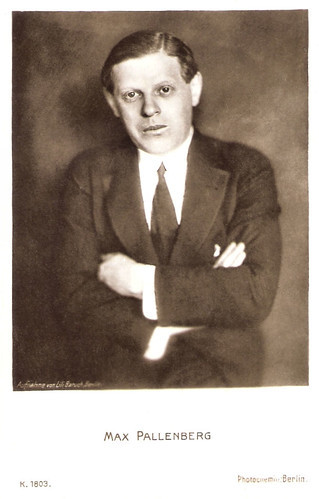
German postcard by Photochemie, Berlin, no. K 1803. Photo: Lili Baruch, Berlin.
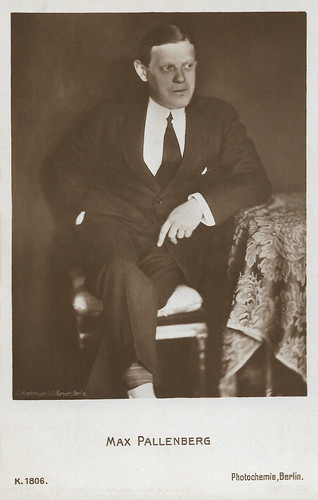
German postcard by Photochemie, Berlin, no. K 1806. Photo: Lili Baruch, Berlin.
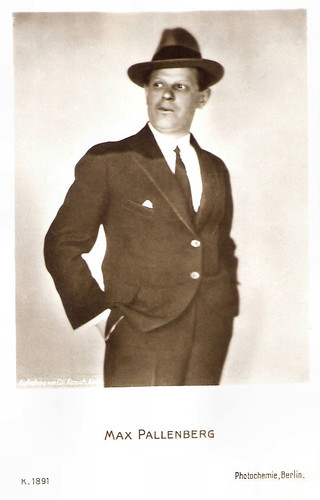
German postcard by Photochemie, Berlin, no. K 1891. Photo: Lili Baruch, Berlin.
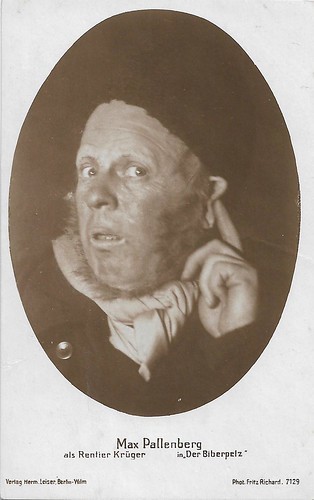
German postcard by Verlag Hermann Leiser, Berlin, no. 7129. Photo: Fritz Richard. Max Pallenberg as Rentier [Reindeer] Krüger in the stage play 'Der Biberpelz' (The beaver fur, 1919).
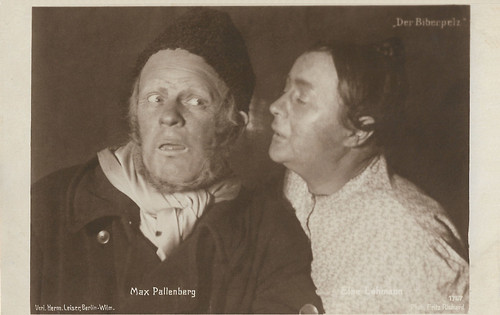
German postcard by Verlag Hermann Leiser, Berlin-Wilm., no. 1757. Photo: Fritz Richard. Max Pallenberg and Else Lehmann in the stage play Der Biberpelz (1919).
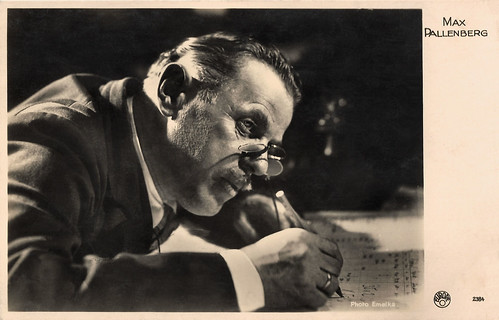
French postcard by Europe, no. 2384. Photo: Emelka. Max Pallenberg in Der brave Sünder/The Upright Sinner (Fritz Kortner, 1931).
The Good Soldier Švejk
Max Pallenberg was born as Max Pollack in 1877 in Vienna, Austria. Max was the son of Markus Pallenberg, who immigrated to Galicia from Vienna, and his wife Kressel (also Therese) born Korsower.
Pallenberg's career started in 1904 and he played in provincial theatres and with touring companies. In 1908, he joined the then famous Theater an der Wien as an operetta comedian and sang, inter alia, in the world premiere of Franz Lehár's operetta 'Der Graf von Luxemburg' (The Count of Luxembourg).
In 1910-1911, Pallenberg performed at the Volkstheater in Vienna, and from 1911 on in Munich at the Deutsches Theater. In 1914 he was committed by Max Reinhardt to the Deutsches Theater in Berlin. There he achieved his artistic breakthrough.
Under the direction of Max Reinhardt, he played brilliant roles such as Schluck in Gerhart Hauptmann's 'Schluck and Jau' and as Peachum in the 'Dreigroschenoper' (Threepenny Opera). Soon he became one of the most famous character comedians of his time. Pallenberg's stellar role was in Erwin Piscator's dramatic adaptation of Jaroslav Hašek's novel 'Der brave Soldat Schwejk' (The Good Soldier Švejk).
Pallenberg's most important roles at the Salzburg Festival include Mephisto in 'Faust', Argan in Mollière's 'Der eingebildet Kranke' (The Imaginary Invalid), the Devil in 'Jedermann' (Everyman), and Truffaldino in 'Turandot', all directed by Max Reinhardt.
In 1917 he married Fritzi Massary who became one of the operetta divas of the German stage of the 1920s. His first wife had been Betty Franke (1903-1917). They had one child.
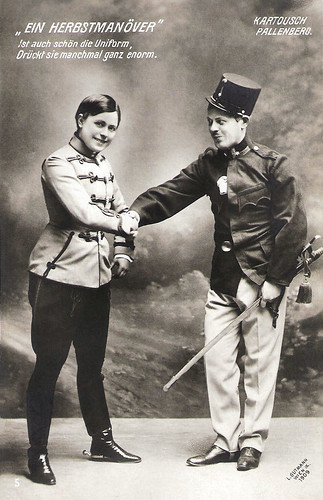
Austrian postcard by B.K.W.I. Photo: Ludwig Gutmann, Wien, 1909. Max Pallenberg and Louise Kartousch in the stage operetta 'Ein Herbstmanöver' (1909). Caption: "Ist auch schön die Uniform, Drückt sie manchmal ganz enorm." (Is also nice the uniform, Sometimes pushes her enormously). 'Ein Herbstmanöver' was the Viennese title of Emmerich Kalman’s first operetta hit, 'Tatájárás' which also launched his Austrian operetta career at Theater an der Wien. 'The Gay Hussars' was the title of the 1909 Broadway version. In 2003, it was recorded at the Ohio Light Opera and released on Albany Records, rechristened 'Autumn Maneuvers'.
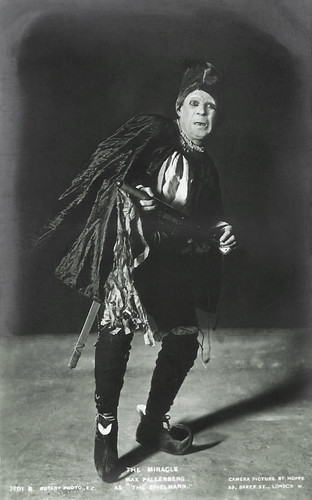
British postcard by Rotary, no. 2701 B. Photo: Hoppe, London. Max Pallenberg as the Spielmann in Max Reinhardt's stage production of The Miracle (1911).
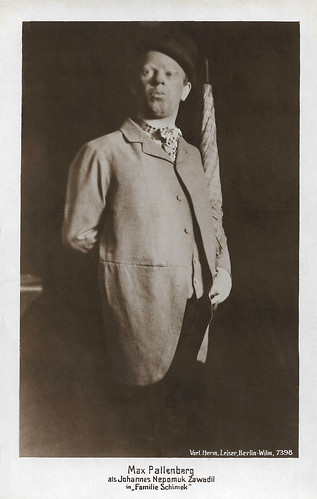
German postcard by Verlag Hermann Leiser, Berlin-Wilm., no. 7398. Photo: Max Pallenberg as Johannes Nepomuk Zawadil in the play 'Die Familie Schimek' by Gustav Kadelburg. In 1916 the play was performed by the Deutsches Theater Berlin under the direction of Emil Jannings .
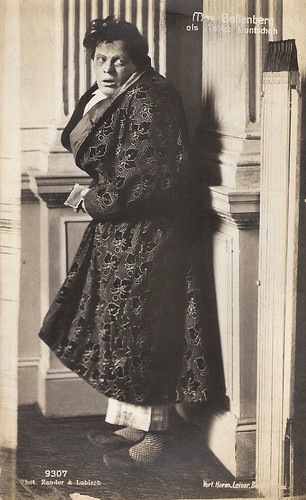
German postcard by Verlag Herm. Leiser, Berlin, no. 9307. Photo: Zander & Labisch. Max Pallenberg in the play 'Tobias Buntschuh' (1917).
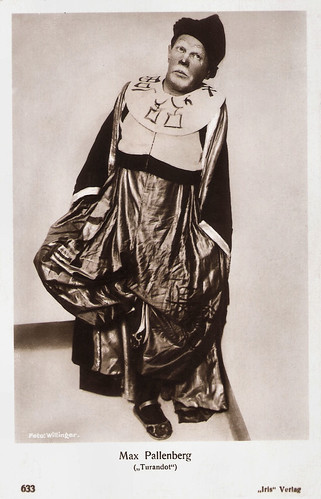
Austrian postcard by Iris Verlag, no. 633. Photo: Laszlo Willinger. Under the direction of Max Reinhardt, Max Pallenberg played Traffaldino in 'Turandot' (1926) by Giacomo Puccini at the Salzburger Festspiele.
A Butt of anti-Semitic propaganda
Max Pallenberg also starred in several silent and sound films. He made his film debut in the German short Der fidele Bauer - Ich hab mein Zipfelhaubn/The Merry Farmer - I have my Zipfel hood (Franz Glawatsch, 1908) with Wilhelm Binder and Louise Kartousch.
In the early 1910s, he had great success in the cinema with his figure Pampulik and appeared in such Austrian films as Pampulik als Affe/Pampulik as Ape (Alexander Kolowrat, 1912), Pampulik kriegt ein Kind/Pampulik gets a child (Alexander Kolowrat, 1912) and Pampulik hat Hunger/Pampulik is hungry (Alexander Kolowrat, 1913).
During World War I, such films followed as Max und seine zwei Frauen/Max and his two wives (Heinrich Bolten-Baeckers, 1915) with Martha Novelly , Der rasende Roland/The Racing Roland (Heinrich Bolten-Baeckers, 1915) and Kapellmeister Pflegekind/Conductor Pflegekind (Heinrich Bolten-Baeckers, 1915). After the war he appeared in Die Nacht und der Leichnam/The night and the corpse (Adolf Abter, 1921) with Ria Jende.
Pallenberg also appeared in sound films. In Der brave Sünder/The Virtuous Sinner (Fritz Kortner, 1931), he co-starred with Heinz Rühmann . The film is based on the play 'The Embezzlers' which was in turn based on a novel by the Soviet writer Valentin Kataev. Pallenberg had previously rejected all offers to appear in films based on his theatre appearances. He was finally convinced by the producer Arnold Pressburger to try and film one of his stage successes. The film also offered Fritz Kortner a chance to fulfill his ambitions to become a director.
In the 1930s, Max Pallenberg and Fritzi Massary became a butt of the anti-Semitic propaganda of the upcoming Nazis. The Jewish couple went into exile in Austria.
A year later, in 1934, Max Pallenberg died in an airplane crash near Karlovy Vary (Karlsbad) in today's Czech Republic. He had changed his ticket for the five o'clock flight against a ticket which left Prague already at three o'clock. The five o'clock flight arrived on time, Pallenberg's flight however crashed a few minutes after the takeoff. Pallenberg was 56. He was cremated at Feuerhalle Simmering, where his ashes are also buried.
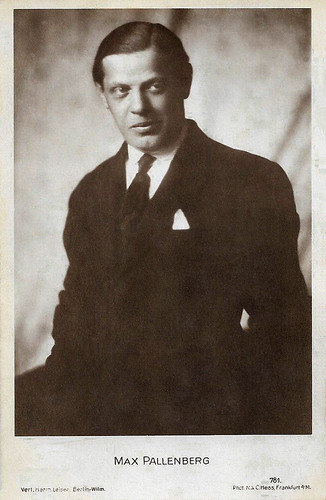
German postcard by Verlag Hermann Leiser, Berlin-Wilm., no. 781. Photo: N. & C. Hess, Frankfurt a.M.

German postcard in the Bühnen-Sterne series by Rotophot, Berlin, no. 3/2. Photo: Karl Schenker, Berlin.
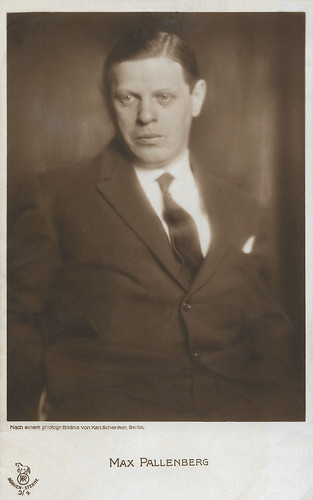
German postcard in the Bühnen-Sterne series by Rotophot, Berlin, no. 3/4. Photo: Karl Schenker, Berlin.

German postcard by Verlag Ross / W.J. Mörlins, Berlin, no. 420/1, 1919-1924. Photo: Karl Schenker.
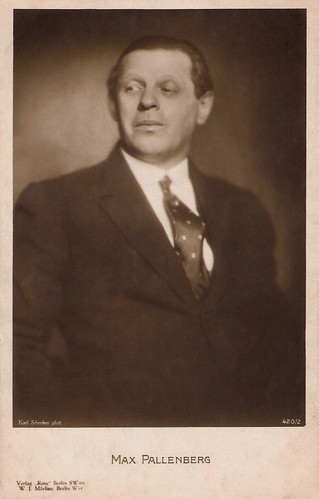
German postcard by Verlag Ross / W.J. Mörlins, Berlin, no. 420/2, 1919-1924. Photo: Karl Schenker.
Sources: Wikipedia (English and German) and .

German postcard by Photochemie, Berlin, no. K 1803. Photo: Lili Baruch, Berlin.

German postcard by Photochemie, Berlin, no. K 1806. Photo: Lili Baruch, Berlin.

German postcard by Photochemie, Berlin, no. K 1891. Photo: Lili Baruch, Berlin.

German postcard by Verlag Hermann Leiser, Berlin, no. 7129. Photo: Fritz Richard. Max Pallenberg as Rentier [Reindeer] Krüger in the stage play 'Der Biberpelz' (The beaver fur, 1919).

German postcard by Verlag Hermann Leiser, Berlin-Wilm., no. 1757. Photo: Fritz Richard. Max Pallenberg and Else Lehmann in the stage play Der Biberpelz (1919).

French postcard by Europe, no. 2384. Photo: Emelka. Max Pallenberg in Der brave Sünder/The Upright Sinner (Fritz Kortner, 1931).
The Good Soldier Švejk
Max Pallenberg was born as Max Pollack in 1877 in Vienna, Austria. Max was the son of Markus Pallenberg, who immigrated to Galicia from Vienna, and his wife Kressel (also Therese) born Korsower.
Pallenberg's career started in 1904 and he played in provincial theatres and with touring companies. In 1908, he joined the then famous Theater an der Wien as an operetta comedian and sang, inter alia, in the world premiere of Franz Lehár's operetta 'Der Graf von Luxemburg' (The Count of Luxembourg).
In 1910-1911, Pallenberg performed at the Volkstheater in Vienna, and from 1911 on in Munich at the Deutsches Theater. In 1914 he was committed by Max Reinhardt to the Deutsches Theater in Berlin. There he achieved his artistic breakthrough.
Under the direction of Max Reinhardt, he played brilliant roles such as Schluck in Gerhart Hauptmann's 'Schluck and Jau' and as Peachum in the 'Dreigroschenoper' (Threepenny Opera). Soon he became one of the most famous character comedians of his time. Pallenberg's stellar role was in Erwin Piscator's dramatic adaptation of Jaroslav Hašek's novel 'Der brave Soldat Schwejk' (The Good Soldier Švejk).
Pallenberg's most important roles at the Salzburg Festival include Mephisto in 'Faust', Argan in Mollière's 'Der eingebildet Kranke' (The Imaginary Invalid), the Devil in 'Jedermann' (Everyman), and Truffaldino in 'Turandot', all directed by Max Reinhardt.
In 1917 he married Fritzi Massary who became one of the operetta divas of the German stage of the 1920s. His first wife had been Betty Franke (1903-1917). They had one child.

Austrian postcard by B.K.W.I. Photo: Ludwig Gutmann, Wien, 1909. Max Pallenberg and Louise Kartousch in the stage operetta 'Ein Herbstmanöver' (1909). Caption: "Ist auch schön die Uniform, Drückt sie manchmal ganz enorm." (Is also nice the uniform, Sometimes pushes her enormously). 'Ein Herbstmanöver' was the Viennese title of Emmerich Kalman’s first operetta hit, 'Tatájárás' which also launched his Austrian operetta career at Theater an der Wien. 'The Gay Hussars' was the title of the 1909 Broadway version. In 2003, it was recorded at the Ohio Light Opera and released on Albany Records, rechristened 'Autumn Maneuvers'.

British postcard by Rotary, no. 2701 B. Photo: Hoppe, London. Max Pallenberg as the Spielmann in Max Reinhardt's stage production of The Miracle (1911).

German postcard by Verlag Hermann Leiser, Berlin-Wilm., no. 7398. Photo: Max Pallenberg as Johannes Nepomuk Zawadil in the play 'Die Familie Schimek' by Gustav Kadelburg. In 1916 the play was performed by the Deutsches Theater Berlin under the direction of Emil Jannings .

German postcard by Verlag Herm. Leiser, Berlin, no. 9307. Photo: Zander & Labisch. Max Pallenberg in the play 'Tobias Buntschuh' (1917).

Austrian postcard by Iris Verlag, no. 633. Photo: Laszlo Willinger. Under the direction of Max Reinhardt, Max Pallenberg played Traffaldino in 'Turandot' (1926) by Giacomo Puccini at the Salzburger Festspiele.
A Butt of anti-Semitic propaganda
Max Pallenberg also starred in several silent and sound films. He made his film debut in the German short Der fidele Bauer - Ich hab mein Zipfelhaubn/The Merry Farmer - I have my Zipfel hood (Franz Glawatsch, 1908) with Wilhelm Binder and Louise Kartousch.
In the early 1910s, he had great success in the cinema with his figure Pampulik and appeared in such Austrian films as Pampulik als Affe/Pampulik as Ape (Alexander Kolowrat, 1912), Pampulik kriegt ein Kind/Pampulik gets a child (Alexander Kolowrat, 1912) and Pampulik hat Hunger/Pampulik is hungry (Alexander Kolowrat, 1913).
During World War I, such films followed as Max und seine zwei Frauen/Max and his two wives (Heinrich Bolten-Baeckers, 1915) with Martha Novelly , Der rasende Roland/The Racing Roland (Heinrich Bolten-Baeckers, 1915) and Kapellmeister Pflegekind/Conductor Pflegekind (Heinrich Bolten-Baeckers, 1915). After the war he appeared in Die Nacht und der Leichnam/The night and the corpse (Adolf Abter, 1921) with Ria Jende.
Pallenberg also appeared in sound films. In Der brave Sünder/The Virtuous Sinner (Fritz Kortner, 1931), he co-starred with Heinz Rühmann . The film is based on the play 'The Embezzlers' which was in turn based on a novel by the Soviet writer Valentin Kataev. Pallenberg had previously rejected all offers to appear in films based on his theatre appearances. He was finally convinced by the producer Arnold Pressburger to try and film one of his stage successes. The film also offered Fritz Kortner a chance to fulfill his ambitions to become a director.
In the 1930s, Max Pallenberg and Fritzi Massary became a butt of the anti-Semitic propaganda of the upcoming Nazis. The Jewish couple went into exile in Austria.
A year later, in 1934, Max Pallenberg died in an airplane crash near Karlovy Vary (Karlsbad) in today's Czech Republic. He had changed his ticket for the five o'clock flight against a ticket which left Prague already at three o'clock. The five o'clock flight arrived on time, Pallenberg's flight however crashed a few minutes after the takeoff. Pallenberg was 56. He was cremated at Feuerhalle Simmering, where his ashes are also buried.

German postcard by Verlag Hermann Leiser, Berlin-Wilm., no. 781. Photo: N. & C. Hess, Frankfurt a.M.

German postcard in the Bühnen-Sterne series by Rotophot, Berlin, no. 3/2. Photo: Karl Schenker, Berlin.

German postcard in the Bühnen-Sterne series by Rotophot, Berlin, no. 3/4. Photo: Karl Schenker, Berlin.

German postcard by Verlag Ross / W.J. Mörlins, Berlin, no. 420/1, 1919-1924. Photo: Karl Schenker.

German postcard by Verlag Ross / W.J. Mörlins, Berlin, no. 420/2, 1919-1924. Photo: Karl Schenker.
Sources: Wikipedia (English and German) and .
Published on January 16, 2020 22:00
January 15, 2020
Kieron Moore
With his dark good looks and tall figure, Irish actor Kieron Moore (1924-2007) made a name for himself in post-war British films as both heroes and villains. His roles included Count Vronsky opposite Vivien Leigh in Anna Karenina (1947) and a homosexual bank robber in The League of Gentlemen (1960). He later also appeared in French, Italian and American productions, and starred in the Sci-Fi classics The Day of the Triffids (1962) and Crack in the World (1965).After Moore retired as an actor, he became a passionate Catholic journalist and charity worker.
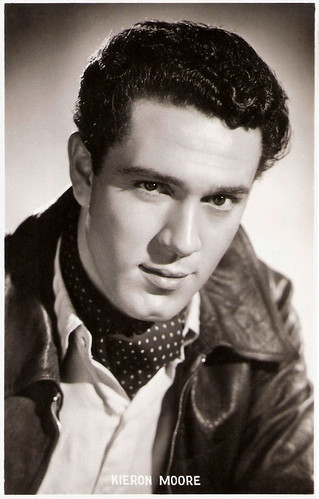
British postcard by A Real Photograph, no. F.S. 56.
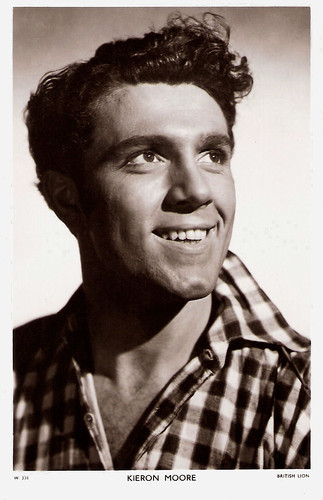
British postcard in the Picturegoer Series, London, no. W. 338. Photo: British Lion.
Everyman
Kieron Moore was born as Ciarán Ó hAnnracháin, Anglicised Kieron O'Hanrahan, in Skibbereen, in the County Cork in Ireland, in 1924. He grew up in a hearty, Irish-speaking-only household. His father, Peadar Ó hAnnracháin, was an Irish Nationalist writer, poet, editor and political activist who was twice imprisoned by the British during the Irish Civil War.
Kieron inherited from this family background a lifelong concern with oppressed or dispossessed people. Encouraged by their parents to pursue their artistic leanings, Kieron's sister Nease became an actress for the Raidió Éireann Players, brother Fachtna became a music director for the same radio station, and sister Blaithin played harp for the National Symphony Orchestra.
Kieron himself was educated in Dublin and started to study medicine at University College Dublin. He abandoned his studies, however, after an Abbey Theatre rep saw him in a Gaelic play at the Little Peacock Theatre, and accepted his application for membership. As Kieron O'Hanrahan he had a notable success at the Abbey Players as Everyman. In 1943 the handsome 19-year old moved to England and made his London stage debut as Heathcliff in a production of 'Wuthering Heights' at the Richmond Theatre. He went on to gain more notice in a production of 'Purple Dust' by Sean O'Casey in Liverpool.
He made an impressive film debut as an IRA killer in The Voice Within (Maurice J. Wilson, 1945). The heroine in the film, murdered by Kieron's character, was played by actress Barbara White. Despite their fatal on-camera relationship, they married in 1947. White retired shortly thereafter and they had three sons (Casey, Colm, Sean) and one daughter (Theresa).
Gary Brumburgh writes in his IMDb bio: “Kieron was a talented, durable player but seemed to lack the charisma or drive for top stardom despite his early promise. An impressed Alexander Korda signed him up with his London Films following a heralded performance in the West End version of Sean O'Casey's play 'Red Roses for Me' in 1946. The marquee name of Kieron Moore was bestowed upon him at this time. While he excelled in his next unsympathetic role, the psychological drama Mine Own Executioner (Anthony Kimmins, 1947) in which he plays a schizophrenic POW treated by doctor Burgess Meredith (with real-wife Barbara playing his wife in one of her last film roles), Kieron failed to capitalize on the one role that could have made him a star. As the urbane count in Anna Karenina (Julien Duvivier, 1948), he was deemed wooden and miscast by many of his reviews.”
Ironically, his role as Count Vronsky opposite Vivien Leigh 's Anna Karenina is now perhaps his best known performance. There is a restored version with an additional 15 minutes to the original theatrical version. At IMDb , reviewer Jandesimpson thinks the addition is an improvement: “mainly early scenes that established minor characters with greater clarity. However the most significant restoration was a closing shot held considerably longer, thus giving that additional weight to the final tragedy that a really thoughtful director of Duvivier's calibre must have originally intended.”
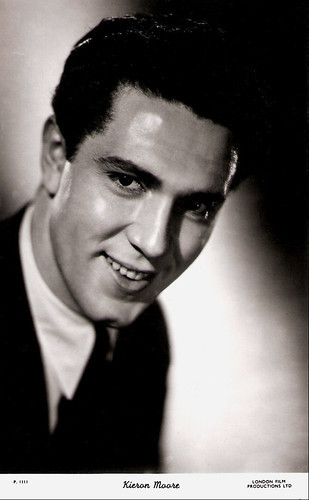
British postcard in The People series by Show Parade Picture Service, London, no. P 1111. Photo: London Film Productions LTD.
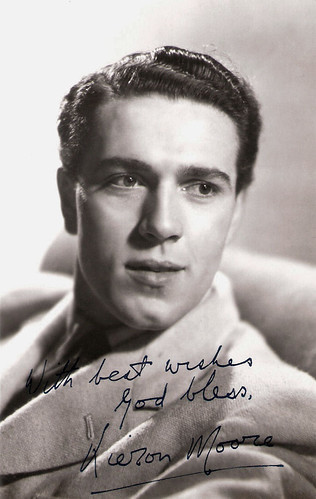
British postcard.
Flesh-eating Plants From Outer Space
Kieron Moore starred in some international co-productions. He appeared in the French-British production Maria Chapdelaine/The Naked Heart (Marc Allégret, 1950) opposite Michèle Morgan , and in Italy in Due mogli sono trope/Honeymoon Deferred (Mario Camerini, 1950) opposite Sally Ann Howes .
In Hollywood he appeared as Uriah the Hittite in the biblical epic David and Bathsheba (Henry King, 1951) opposite Gregory Peck, and as a dashing Foreign Legion corporal in Ten Tall Men (Willis Goldbeck, 1951), starring Burt Lancaster . Not much happened as a result and he returned to England.
There he continued to offer fine and varied performances, notably in The Green Scarf (George More O'Ferrall, 1954) starring Michael Redgrave , in which Moore earned applause for his role as a deaf, dumb and blind author who confesses to a murder in the mistaken belief that his wife is the guilty one.
Another part that garnered some attention was the bully Pony Sugrue in the Disney classic Darby O'Gill and the Little People (Robert Stevenson, 1959) with Sean Connery . This was topped by the strong kudos he received in the comedy-thriller The League of Gentlemen (Basil Dearden, 1960) as a homosexual ex-officer recruited by Jack Hawkins for a bank robbery.
He turned hero again as a man forced to battle flesh-eating plants from outer space in the classic sci-fi thriller The Day of the Triffids (Steve Sekely, 1962) with Nicole Maurey . His status started to regress in such routine films as the horror thriller Doctor Blood's Coffin (Sidney J. Furie, 1961) with Hazel Court , the Susan Hayward vehicle I Thank a Fool (Robert Stevens, 1962) and the war drama The Thin Red Line (Andrew Marton, 1964).
He played second fiddle to special effects in the Sci-Fi epic Crack in the World (Andrew Marton, 1965) and to Gregory Peck (again) in the adventure film Arabesque (Stanley Donen, 1966). He took as his final film the underwhelming Custer of the West (Robert Siodmak, 1967) in which he was oddly cast as Indian chief Dull Knife opposite Robert Shaw. Throughout the 1950s and 1960s he customarily performed on TV, including the short-lived BBC action series Ryan International (1970), which he also wrote.
After retiring from feature film work altogether in 1974, his life took a religious and socially-active turn. He joined CAFOD (the Catholic Agency for Overseas Development), for whom he worked for seven years, directing and narrating two film documentaries in the course of that time. The films dealt specifically with the struggle for survival in Third World countries. He also travelled extensively in the Middle East and India and provided voice-overs for other documentary features as well.
After this he became an associate editor of the biggest-selling Catholic paper in Great Britain, The Universe. In 1994, Kieron Moore retired quietly to the Charente-Maritime in France where he died in 2007 at age 82. He was survived by his wife, Barbara White, and their four children. They all entered caring professions: his daughter a nun, two of his sons teachers and the other a psychotherapist.
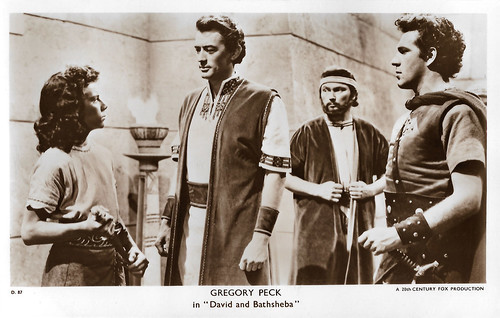
British postcard by The Picturegoer Series, London, no. D 87. Photo: 20th Century Fox. Gregory Peck and Kieron Moore in David and Bathsheba (Henry King, 1951).
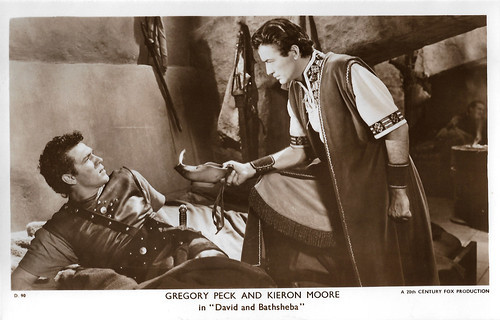
British postcard by The Picturegoer Series, London, no. D 90. Photo: 20th Century Fox. Gregory Peck and Kieron Moore in David and Bathsheba (Henry King, 1951).
Trailer Dr. Blood's Coffin (1961). Source: mirkodamian (YouTube).
Sources: (IMDb), Mark Lawson (The Guardian), Brian J. Walker (Brian´s Drive-in Theater), JandeSimpson (IMDb), BritMovie.co.uk, The Telegraph, Wikipedia and .

British postcard by A Real Photograph, no. F.S. 56.

British postcard in the Picturegoer Series, London, no. W. 338. Photo: British Lion.
Everyman
Kieron Moore was born as Ciarán Ó hAnnracháin, Anglicised Kieron O'Hanrahan, in Skibbereen, in the County Cork in Ireland, in 1924. He grew up in a hearty, Irish-speaking-only household. His father, Peadar Ó hAnnracháin, was an Irish Nationalist writer, poet, editor and political activist who was twice imprisoned by the British during the Irish Civil War.
Kieron inherited from this family background a lifelong concern with oppressed or dispossessed people. Encouraged by their parents to pursue their artistic leanings, Kieron's sister Nease became an actress for the Raidió Éireann Players, brother Fachtna became a music director for the same radio station, and sister Blaithin played harp for the National Symphony Orchestra.
Kieron himself was educated in Dublin and started to study medicine at University College Dublin. He abandoned his studies, however, after an Abbey Theatre rep saw him in a Gaelic play at the Little Peacock Theatre, and accepted his application for membership. As Kieron O'Hanrahan he had a notable success at the Abbey Players as Everyman. In 1943 the handsome 19-year old moved to England and made his London stage debut as Heathcliff in a production of 'Wuthering Heights' at the Richmond Theatre. He went on to gain more notice in a production of 'Purple Dust' by Sean O'Casey in Liverpool.
He made an impressive film debut as an IRA killer in The Voice Within (Maurice J. Wilson, 1945). The heroine in the film, murdered by Kieron's character, was played by actress Barbara White. Despite their fatal on-camera relationship, they married in 1947. White retired shortly thereafter and they had three sons (Casey, Colm, Sean) and one daughter (Theresa).
Gary Brumburgh writes in his IMDb bio: “Kieron was a talented, durable player but seemed to lack the charisma or drive for top stardom despite his early promise. An impressed Alexander Korda signed him up with his London Films following a heralded performance in the West End version of Sean O'Casey's play 'Red Roses for Me' in 1946. The marquee name of Kieron Moore was bestowed upon him at this time. While he excelled in his next unsympathetic role, the psychological drama Mine Own Executioner (Anthony Kimmins, 1947) in which he plays a schizophrenic POW treated by doctor Burgess Meredith (with real-wife Barbara playing his wife in one of her last film roles), Kieron failed to capitalize on the one role that could have made him a star. As the urbane count in Anna Karenina (Julien Duvivier, 1948), he was deemed wooden and miscast by many of his reviews.”
Ironically, his role as Count Vronsky opposite Vivien Leigh 's Anna Karenina is now perhaps his best known performance. There is a restored version with an additional 15 minutes to the original theatrical version. At IMDb , reviewer Jandesimpson thinks the addition is an improvement: “mainly early scenes that established minor characters with greater clarity. However the most significant restoration was a closing shot held considerably longer, thus giving that additional weight to the final tragedy that a really thoughtful director of Duvivier's calibre must have originally intended.”

British postcard in The People series by Show Parade Picture Service, London, no. P 1111. Photo: London Film Productions LTD.

British postcard.
Flesh-eating Plants From Outer Space
Kieron Moore starred in some international co-productions. He appeared in the French-British production Maria Chapdelaine/The Naked Heart (Marc Allégret, 1950) opposite Michèle Morgan , and in Italy in Due mogli sono trope/Honeymoon Deferred (Mario Camerini, 1950) opposite Sally Ann Howes .
In Hollywood he appeared as Uriah the Hittite in the biblical epic David and Bathsheba (Henry King, 1951) opposite Gregory Peck, and as a dashing Foreign Legion corporal in Ten Tall Men (Willis Goldbeck, 1951), starring Burt Lancaster . Not much happened as a result and he returned to England.
There he continued to offer fine and varied performances, notably in The Green Scarf (George More O'Ferrall, 1954) starring Michael Redgrave , in which Moore earned applause for his role as a deaf, dumb and blind author who confesses to a murder in the mistaken belief that his wife is the guilty one.
Another part that garnered some attention was the bully Pony Sugrue in the Disney classic Darby O'Gill and the Little People (Robert Stevenson, 1959) with Sean Connery . This was topped by the strong kudos he received in the comedy-thriller The League of Gentlemen (Basil Dearden, 1960) as a homosexual ex-officer recruited by Jack Hawkins for a bank robbery.
He turned hero again as a man forced to battle flesh-eating plants from outer space in the classic sci-fi thriller The Day of the Triffids (Steve Sekely, 1962) with Nicole Maurey . His status started to regress in such routine films as the horror thriller Doctor Blood's Coffin (Sidney J. Furie, 1961) with Hazel Court , the Susan Hayward vehicle I Thank a Fool (Robert Stevens, 1962) and the war drama The Thin Red Line (Andrew Marton, 1964).
He played second fiddle to special effects in the Sci-Fi epic Crack in the World (Andrew Marton, 1965) and to Gregory Peck (again) in the adventure film Arabesque (Stanley Donen, 1966). He took as his final film the underwhelming Custer of the West (Robert Siodmak, 1967) in which he was oddly cast as Indian chief Dull Knife opposite Robert Shaw. Throughout the 1950s and 1960s he customarily performed on TV, including the short-lived BBC action series Ryan International (1970), which he also wrote.
After retiring from feature film work altogether in 1974, his life took a religious and socially-active turn. He joined CAFOD (the Catholic Agency for Overseas Development), for whom he worked for seven years, directing and narrating two film documentaries in the course of that time. The films dealt specifically with the struggle for survival in Third World countries. He also travelled extensively in the Middle East and India and provided voice-overs for other documentary features as well.
After this he became an associate editor of the biggest-selling Catholic paper in Great Britain, The Universe. In 1994, Kieron Moore retired quietly to the Charente-Maritime in France where he died in 2007 at age 82. He was survived by his wife, Barbara White, and their four children. They all entered caring professions: his daughter a nun, two of his sons teachers and the other a psychotherapist.

British postcard by The Picturegoer Series, London, no. D 87. Photo: 20th Century Fox. Gregory Peck and Kieron Moore in David and Bathsheba (Henry King, 1951).

British postcard by The Picturegoer Series, London, no. D 90. Photo: 20th Century Fox. Gregory Peck and Kieron Moore in David and Bathsheba (Henry King, 1951).
Trailer Dr. Blood's Coffin (1961). Source: mirkodamian (YouTube).
Sources: (IMDb), Mark Lawson (The Guardian), Brian J. Walker (Brian´s Drive-in Theater), JandeSimpson (IMDb), BritMovie.co.uk, The Telegraph, Wikipedia and .
Published on January 15, 2020 22:00
January 14, 2020
Katharina Mayberg
German actress Katharina Mayberg (1925–2007) was a popular actress in German and Austrian film productions the 1950s and 1960s.
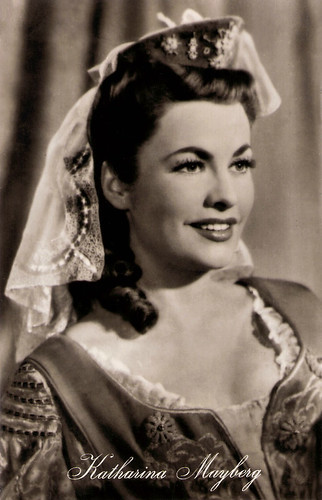
East-German postcard by VEB Progress Film-Vertrieb, Berlin, no. 4082/295, 1957. Photo: DEFA / Wunsch. Katharina Mayberg in Mazurka der Liebe/Der Bettelstudent/The Beggar Student (Hans Müller, 1957).
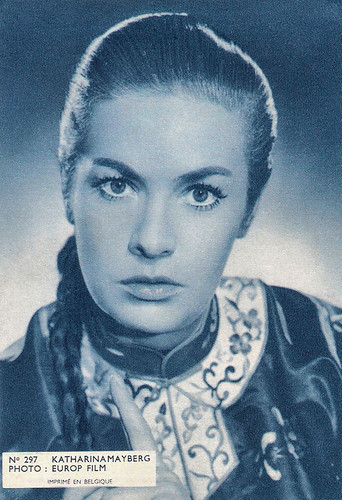
Belgian collectors card, no. 297. Photo: Europ Film. Katharina Mayberg in Dr. Crippen lebt/Doctor Crippen Lives (Erich Engels, 1958).
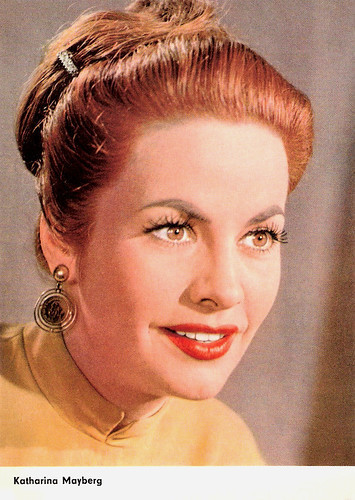
East-German postcard by VEB Progress Film-Vertrieb, Berlin, no. 1514, 1961. Photo: Kurt Wunsch.
The Marriage of Figaro
Katharina Mayberg was born in 1925 in Hamburg, Germany. Mayberg took acting classes with Waldemar Stegemann and initially worked as a stage actress.
She made her film debut with a small part in the drama Die Söhne des Herrn Gaspary/Gaspary's Sons (Rolf Meyer, 1948) starring Lil Dagover and Hans Stüwe .
The following year, she played Barbarina in the East German musical Figaros Hochzeit/The Marriage of Figaro (Georg Wildhagen, 1949) starring Angelika Hauff and Willi Domgraf-Fassbaender . It was based on the opera 'The Marriage of Figaro' by Wolfgang Amadeus Mozart and Lorenzo Da Ponte, which was itself based on the play 'The Marriage of Figaro' by Pierre Beaumarchais.
The film was made by DEFA, the state production company of East Germany, in their Babelsberg Studio and the nearby Babelsberg Park. The production used not the original Italian but a German text. The recitatives were replaced with dialogue spoken by the actors. It sold 5,479,427 tickets.
She had a supporting part in the Austrian-German sports comedy Der Theodor im Fußballtor/Theodore the Goalkeeper (E.W. Emo, 1950) starring Theo Lingen and Hans Moser . She had a major role in the drama Hinter Klostermauern/Behind Monastery Walls (Harald Reinl, 1952) starring Olga Tschechowa and Frits van Dongen (Philip Dorn). The film takes place in a priory and is sometimes known by the alternative title of The Unholy Intruders.
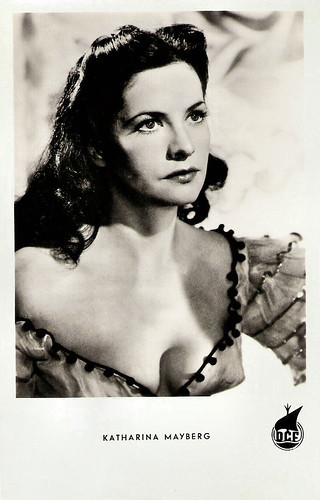
German postcard by Kunst und Bild, Berlin, no. A 891. Photo: DCF. Katharina Mayberg in Die Todesarena/Arena of Death (Kurt Meisel, 1953).
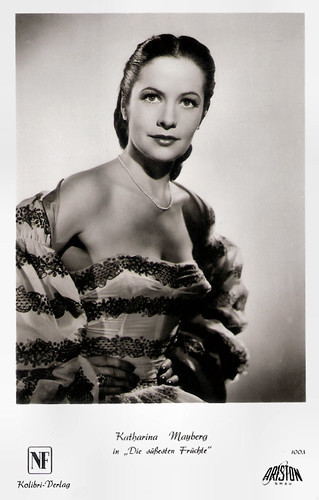
West-German postcard by Kolibri-Verlag, no. 1003. Photo: NF / Ariston GmbH. Katharina Mayberg in Die süssesten Früchte/The Sweetest Fruits (Franz Antel, 1954).
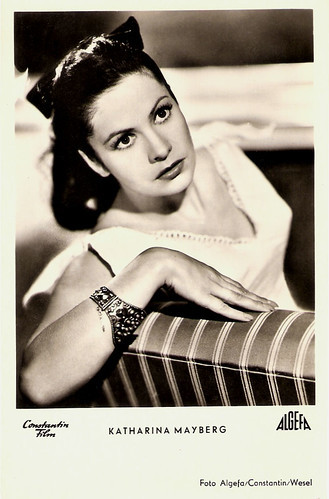
West-German postcard ny Kunst und Bild, Berlin, no. A 1221. Photo: Algefa / Constantin / Wesel. Katharina Mayberg in Die schöne Müllerin/The Beautiful Miller (Wolfgang Liebeneiner, 1954).
Her own production company
Katharina Mayberg had her first female leading role in the Austrian-German crime film Die Todesarena/Arena of Death (Kurt Meisel, 1953) co-starring Richard Häussler and Friedl Hardt.
A popular success was the drama Rosen-Resli/Rose-Girl Resli (Harald Reinl, 1954) which turned child actress Christine Kaufmann into a star. In this and other films like the romantic drama Die schöne Müllerin/The Beautiful Miller (Wolfgang Liebeneiner, 1954) featuring Waltraut Haas , Mayberg played supporting parts again.
Throughout the 1950s, her parts became smaller, such as in the Spanish film El batallón de las sombras/The Battalion in the Shadows (Manuel Mur Oti, 1957).
She played again a leading role as Brunilde in the Italian fantasy Sigfrido/The Dragon's Blood (Giacomo Gentilomo, 1957), based on Richard Wagner's 'Der Ring des Nibelungen'. Dragon's Blood giant dragon was one of the earliest creatures created by special effects artist Carlo Rambaldi, who later would be responsible for the special effects on King Kong (John Guillermin, 1976) and E.T. (Steven Spielberg, 1982).
Back in Germany, Mayberg appeared in comedies like Immer die Radfahrer/Cyclists Forever (Hans Deppe, 1958) and Kauf dir einen bunten Luftballon/Buy a colourful balloon (Géza von Cziffra, 1961). Later she appeared in the Austrian crime film Mann im Schatten/Man in the Shadow (Arthur Maria Rabenalt, 1961), the TV film Jan Himp und die kleine Brise/Jan Himp and the little Breeze (Arthur Maria Rabenalt, 1966) with Ulli Lommel, and the sexploitation Wilder Sex junger Mädchen/Love Times Three (Jürgen Schindler, Nino Casale, 1972).
In the literary adaptation Der Schimmelreiter/Rider of a White Horse (Alfred Weidenmann, 1977), starring John Phillip Law and Gert Fröbe, she played her last role, the maid Ann Grete. The film was produced by her own company Schimmelreiter Albis Film GmbH.
Mayberg was married to film producer Alf Teich from 1956 till 1992 (his death) and they had a son. Katharina Mayberg passed away after a long illness in 2007 at her home in Hamburg-Othmarschen. She was 83.
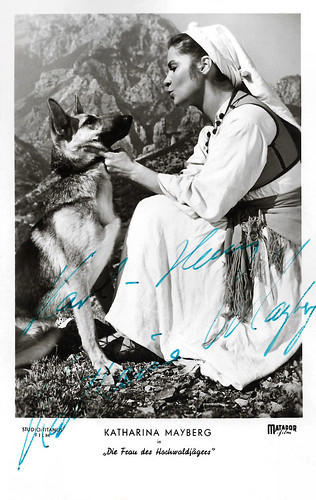
West-German postcard . Photo: Studio / Titanus Film / Matador-Film. Katharina Mayberg in Klisura (Bosko Kosanovic, 1956).
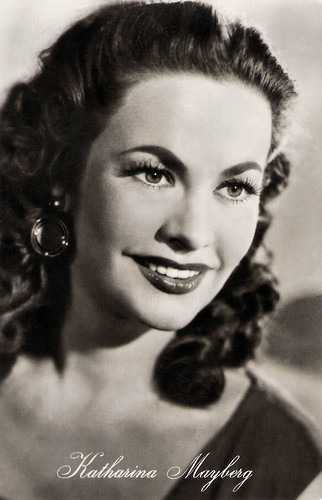
East-German postcard by VEB Progress Filmvertrieb, Berlin, no. 4077/294. Photo: DEFA / Wunsch. Katharina Mayberg in Mazurka der Liebe/Love's Mazurka (Hans Müller, 1957).
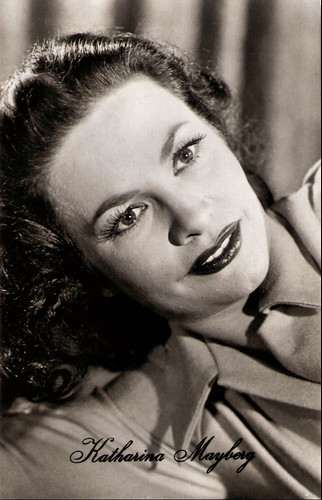
East-German postcard by VEB Progress Film-Vertrieb, Berlin, no. 5093/473, 1957. Photo: Kurt Wunsch.
Sources: Wikipedia (English and German), and .

East-German postcard by VEB Progress Film-Vertrieb, Berlin, no. 4082/295, 1957. Photo: DEFA / Wunsch. Katharina Mayberg in Mazurka der Liebe/Der Bettelstudent/The Beggar Student (Hans Müller, 1957).

Belgian collectors card, no. 297. Photo: Europ Film. Katharina Mayberg in Dr. Crippen lebt/Doctor Crippen Lives (Erich Engels, 1958).

East-German postcard by VEB Progress Film-Vertrieb, Berlin, no. 1514, 1961. Photo: Kurt Wunsch.
The Marriage of Figaro
Katharina Mayberg was born in 1925 in Hamburg, Germany. Mayberg took acting classes with Waldemar Stegemann and initially worked as a stage actress.
She made her film debut with a small part in the drama Die Söhne des Herrn Gaspary/Gaspary's Sons (Rolf Meyer, 1948) starring Lil Dagover and Hans Stüwe .
The following year, she played Barbarina in the East German musical Figaros Hochzeit/The Marriage of Figaro (Georg Wildhagen, 1949) starring Angelika Hauff and Willi Domgraf-Fassbaender . It was based on the opera 'The Marriage of Figaro' by Wolfgang Amadeus Mozart and Lorenzo Da Ponte, which was itself based on the play 'The Marriage of Figaro' by Pierre Beaumarchais.
The film was made by DEFA, the state production company of East Germany, in their Babelsberg Studio and the nearby Babelsberg Park. The production used not the original Italian but a German text. The recitatives were replaced with dialogue spoken by the actors. It sold 5,479,427 tickets.
She had a supporting part in the Austrian-German sports comedy Der Theodor im Fußballtor/Theodore the Goalkeeper (E.W. Emo, 1950) starring Theo Lingen and Hans Moser . She had a major role in the drama Hinter Klostermauern/Behind Monastery Walls (Harald Reinl, 1952) starring Olga Tschechowa and Frits van Dongen (Philip Dorn). The film takes place in a priory and is sometimes known by the alternative title of The Unholy Intruders.

German postcard by Kunst und Bild, Berlin, no. A 891. Photo: DCF. Katharina Mayberg in Die Todesarena/Arena of Death (Kurt Meisel, 1953).

West-German postcard by Kolibri-Verlag, no. 1003. Photo: NF / Ariston GmbH. Katharina Mayberg in Die süssesten Früchte/The Sweetest Fruits (Franz Antel, 1954).

West-German postcard ny Kunst und Bild, Berlin, no. A 1221. Photo: Algefa / Constantin / Wesel. Katharina Mayberg in Die schöne Müllerin/The Beautiful Miller (Wolfgang Liebeneiner, 1954).
Her own production company
Katharina Mayberg had her first female leading role in the Austrian-German crime film Die Todesarena/Arena of Death (Kurt Meisel, 1953) co-starring Richard Häussler and Friedl Hardt.
A popular success was the drama Rosen-Resli/Rose-Girl Resli (Harald Reinl, 1954) which turned child actress Christine Kaufmann into a star. In this and other films like the romantic drama Die schöne Müllerin/The Beautiful Miller (Wolfgang Liebeneiner, 1954) featuring Waltraut Haas , Mayberg played supporting parts again.
Throughout the 1950s, her parts became smaller, such as in the Spanish film El batallón de las sombras/The Battalion in the Shadows (Manuel Mur Oti, 1957).
She played again a leading role as Brunilde in the Italian fantasy Sigfrido/The Dragon's Blood (Giacomo Gentilomo, 1957), based on Richard Wagner's 'Der Ring des Nibelungen'. Dragon's Blood giant dragon was one of the earliest creatures created by special effects artist Carlo Rambaldi, who later would be responsible for the special effects on King Kong (John Guillermin, 1976) and E.T. (Steven Spielberg, 1982).
Back in Germany, Mayberg appeared in comedies like Immer die Radfahrer/Cyclists Forever (Hans Deppe, 1958) and Kauf dir einen bunten Luftballon/Buy a colourful balloon (Géza von Cziffra, 1961). Later she appeared in the Austrian crime film Mann im Schatten/Man in the Shadow (Arthur Maria Rabenalt, 1961), the TV film Jan Himp und die kleine Brise/Jan Himp and the little Breeze (Arthur Maria Rabenalt, 1966) with Ulli Lommel, and the sexploitation Wilder Sex junger Mädchen/Love Times Three (Jürgen Schindler, Nino Casale, 1972).
In the literary adaptation Der Schimmelreiter/Rider of a White Horse (Alfred Weidenmann, 1977), starring John Phillip Law and Gert Fröbe, she played her last role, the maid Ann Grete. The film was produced by her own company Schimmelreiter Albis Film GmbH.
Mayberg was married to film producer Alf Teich from 1956 till 1992 (his death) and they had a son. Katharina Mayberg passed away after a long illness in 2007 at her home in Hamburg-Othmarschen. She was 83.

West-German postcard . Photo: Studio / Titanus Film / Matador-Film. Katharina Mayberg in Klisura (Bosko Kosanovic, 1956).

East-German postcard by VEB Progress Filmvertrieb, Berlin, no. 4077/294. Photo: DEFA / Wunsch. Katharina Mayberg in Mazurka der Liebe/Love's Mazurka (Hans Müller, 1957).

East-German postcard by VEB Progress Film-Vertrieb, Berlin, no. 5093/473, 1957. Photo: Kurt Wunsch.
Sources: Wikipedia (English and German), and .
Published on January 14, 2020 22:00
January 13, 2020
Spasimi (1917)
EFSP starts a series of weekly posts on Spanish collectors cards, published by Chocolate manufacturers. Ivo Blom collects these cards, which were all published in the late 1910s. We start the series with a series by Chocolate Salas-Sabadell about the Italian silent film Spasimi/Spasms (Giuseppe Giusti, 1917). The Spanish release title of the film was Espasmos. Star was French actress Fabienne Fabrèges (1889-?) who was also a scriptwriter and director of silent films. She had a rich career at Gaumont, and afterwards in Italian silent film. The cards series consists of six cards, all of which Ivo found. As far as known, no copy of the film exists anymore.
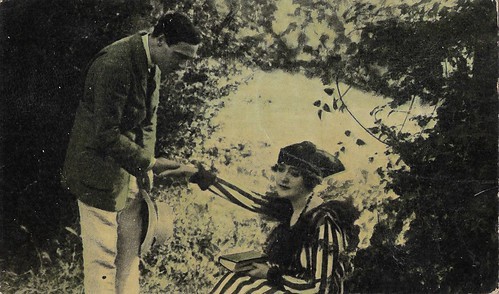
Spanish collectors card by Chocolate Salas-Sabadell, no. 1. Photo: Corona Films. Fabienne Fabrèges and Didaco Chellini in Spasimi (Giuseppe Giusti, 1917).
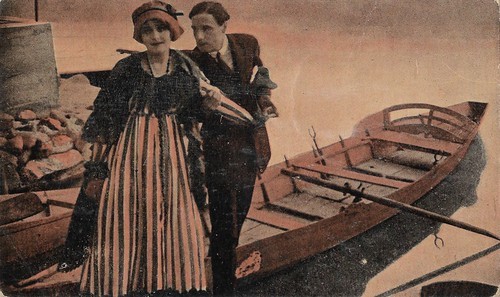
Spanish collectors card by Chocolate Salas-Sabadell, no. 2. Photo: Corona Films. Fabienne Fabrèges and probably Didaco Chellini in Spasimi (Giuseppe Giusti, 1917).
Gracious Fabienne
The plot of Spasimi/Spasms (Giuseppe Giusti, 1917) is told on the backside of the cards. Fabienne Fabrèges plays an orphan, alone and ruined. At the auction of her palace, Marquis Chabrol asks Fabienne to become the piano teacher of his daughter Renée. She is overcome by the wealth of the marquis's mansion, while Henri, the son of the marquis, falls in love with her.
His father chases him away and Henri goes for easy pleasures. Fabienne takes care of the ill marquis, which is rewarded by the marquis' gratitude but also the envy of his daughter. During a nightly garden party by the Count of St. Privat, Fabienne is the toast of the evening. The count whispers sweet words to her. She confesses him her only mistake in life but he forgives her and asks her in marriage.
Jealous Renée plots to ruin Fabienne's happiness by telling her brother Henri how fond their father is of Fabienne and asking him to return immediately. Henri returns after the wedding and is vexed Fabienne didn't choose him. The count, remembering Fabienne's confusion she once had another man, takes her on a honeymoon to far away places.
Henri pursues them, though. He confronts Fabienne, who declares she despises him and loves her husband, but she thinks he will kill her husband, so she agrees to a secret rendezvous. The count finds the letter and suspects his wife of adultery. Armed with a revolver, Fabienne goes to Henri's house to defend her husband, followed by the Count. But entering the house, she finds the corpse of Henri, who has killed himself and holds in his hands a letter exonerating Fabienne. From that day, the happiness for the couple returns.
In his reference work Il cinema muto italiano (1916, part II), Vittorio Martinelli doesn't list any of the other actors, and only gives a vague plot. Just like in Signora giurati (Giuseppe Giusti, 1916), one of the few remaining Italian films with Fabienne Fabrèges, and produced almost at the same time as Spasimi, we may conclude that Attilio De Virgiliis played the male lead of the film, the Count. If the same cast of Signori giurati collaborated, then Bonaventura Ibanez may have played the old Marquis, Didaco Chellini young Henri, and Valeria Creti Renée. Indeed, Chellini looks like the man on the first two cards.
Spasimi premiered in Rome on 12 June 1917. While the Italian press thought the plot unimpressive, it praised Fabienne Fabrèges' performance as "gracious, without the grand gestures and poses of the worst style", probably referring to the Italian divas or rather their epigones (Giuseppe Lega in Cine-Gazzetto, Rome, 9-6-2017). The film apparently was a public success.
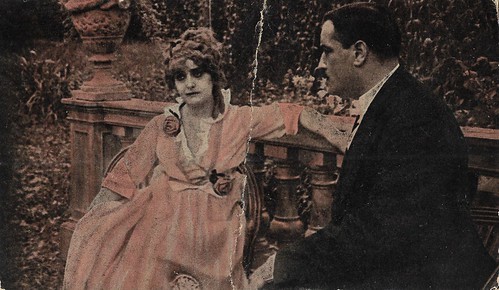
Spanish collectors card by Chocolate Salas-Sabadell, no. 3. Photo: Corona Films. Fabienne Fabrèges and Attilio De Virgiliis in Spasimi (Giuseppe Giusti, 1917).
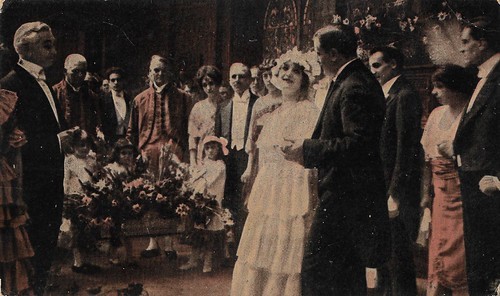
Spanish collectors card by Chocolate Salas-Sabadell, no. 4. Photo: Corona Films. Fabienne Fabrèges and Attilio De Virgiliis in Spasimi (Giuseppe Giusti, 1917).
A modern young woman
Fabienne Fabrèges was part of a generation of 'modern' young women who, at the beginning of the twentieth century, were able to overcome the roles of women who were forced upon them in Western society when pursuing their careers.
Fabrèges began as a young actress at the age of 15 in 'Cousin Bette' by Honoré de Balzac. In 1911, her talent as a performer was already receiving favourable reviews. Then she was part of the troupe of the company of Charles Baret, performing in Strasbourg and various French cities. Fabrèges also played in theatrical performances abroad, notably on the stages of Saint-Petersburg, Berlin, London, and Madrid.
Fabrèges's film career (1910-1923) can be divided into three phases. Between 1910 and 1916, she worked in France for the Société des Établissements Gaumont where she joined Léonce Perret's troupe, director of the company with Louis Feuillade. At Gaumont she acted in some forty films, mostly directed by Perret, and from 1913 also by Feuillade, including the third episode of Fantomas (1913).
During the First World War, in 1916, Fabienne Fabrèges moved to Italy, where she was immediately recognised as a leading actress by the Italian film industry. Film historian Vittorio Martinelli notes that critics of the time hailed her as a great actress of international standing and praised her refined acting style in these first films.
Between 1916 and 1923, she played in over twenty Italian films. Fabrèges first acted at the Turin based company Corona Films, e.g. in Signora giurati (Giuseppe Giusti, 1916), of which a tinted print was found at the Dutch EYE Filmmuseum. Fabrèges here plays the owner of an opium den, who falls in love with one of her victims (Bonaventura Ibáñez). Fabrèges also scripted the film.
Indeed, for several of these Italian films, Fabrèges is also credited as screenwriter. In 1917 she also acted at other companies, such as Gladiator Film and Latino Ars. In 1918 she reached the apex of her career, when moving to De Giglio films. Producer Alfonso De Giglio was so impressed by her that he not only gave her several leads, but also let her found her own company, the Fabrèges Film Company. It operated under the aegis of De Giglio and produced four films in 1919: Il cuore di Musette, L’altalena della vita, Sua Maestà il Denaro, and Sua Maestà l’Amore.
Fabrèges scripted all four films and played the lead, while for L'altalena della vita she also functioned as director. Yet, despite praise for her direction and performance, critics condemned her script of the latter film. This may have meant the end of her own company (of which very few details are known), though Fabrèges still acted in two films by De Giglio in 1920, while a third had a late release in 1923.
Finally, somewhere in 1920-1921, she left the stage and the screen in Italy and moved to Britain, where she continued to perform on stage in theatres, and starred in one film, The Pennyless Millionnaire (Einar Bruun, 1921), with Stewart Rome in the lead, and Gregory Scott and Cameron Carr as co-stars.
There, her career seems to have ended after 1923, following a breakup in love. She retired to Scotland and no longer showed herself in public. It is unknown when and where Fabienne Fabrèges died. She is sometimes mentioned as Fabrège or Fabrege.
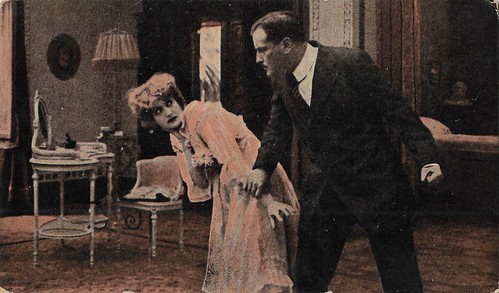
Spanish collectors card by Chocolate Salas-Sabadell, no. 5. Photo: Corona Films. Fabienne Fabrèges and Attilio De Virgiliis in Spasimi (Giuseppe Giusti, 1917).
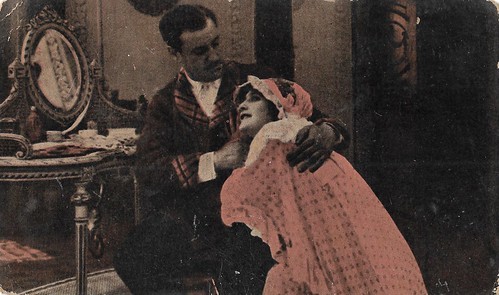
Spanish collectors card by Chocolate Salas-Sabadell, no. 6. Photo: Corona Films. Fabienne Fabrèges and Attilio De Virgiliis in Spasimi (Giuseppe Giusti, 1917).
Sources: Vittorio Martinelli (Il cinema muto italiano 1916 - Italian), Elena Nepoti (Women Film Pioneers Project), the collectors cards themselves, Wikipedia (English and French) and IMDb.

Spanish collectors card by Chocolate Salas-Sabadell, no. 1. Photo: Corona Films. Fabienne Fabrèges and Didaco Chellini in Spasimi (Giuseppe Giusti, 1917).

Spanish collectors card by Chocolate Salas-Sabadell, no. 2. Photo: Corona Films. Fabienne Fabrèges and probably Didaco Chellini in Spasimi (Giuseppe Giusti, 1917).
Gracious Fabienne
The plot of Spasimi/Spasms (Giuseppe Giusti, 1917) is told on the backside of the cards. Fabienne Fabrèges plays an orphan, alone and ruined. At the auction of her palace, Marquis Chabrol asks Fabienne to become the piano teacher of his daughter Renée. She is overcome by the wealth of the marquis's mansion, while Henri, the son of the marquis, falls in love with her.
His father chases him away and Henri goes for easy pleasures. Fabienne takes care of the ill marquis, which is rewarded by the marquis' gratitude but also the envy of his daughter. During a nightly garden party by the Count of St. Privat, Fabienne is the toast of the evening. The count whispers sweet words to her. She confesses him her only mistake in life but he forgives her and asks her in marriage.
Jealous Renée plots to ruin Fabienne's happiness by telling her brother Henri how fond their father is of Fabienne and asking him to return immediately. Henri returns after the wedding and is vexed Fabienne didn't choose him. The count, remembering Fabienne's confusion she once had another man, takes her on a honeymoon to far away places.
Henri pursues them, though. He confronts Fabienne, who declares she despises him and loves her husband, but she thinks he will kill her husband, so she agrees to a secret rendezvous. The count finds the letter and suspects his wife of adultery. Armed with a revolver, Fabienne goes to Henri's house to defend her husband, followed by the Count. But entering the house, she finds the corpse of Henri, who has killed himself and holds in his hands a letter exonerating Fabienne. From that day, the happiness for the couple returns.
In his reference work Il cinema muto italiano (1916, part II), Vittorio Martinelli doesn't list any of the other actors, and only gives a vague plot. Just like in Signora giurati (Giuseppe Giusti, 1916), one of the few remaining Italian films with Fabienne Fabrèges, and produced almost at the same time as Spasimi, we may conclude that Attilio De Virgiliis played the male lead of the film, the Count. If the same cast of Signori giurati collaborated, then Bonaventura Ibanez may have played the old Marquis, Didaco Chellini young Henri, and Valeria Creti Renée. Indeed, Chellini looks like the man on the first two cards.
Spasimi premiered in Rome on 12 June 1917. While the Italian press thought the plot unimpressive, it praised Fabienne Fabrèges' performance as "gracious, without the grand gestures and poses of the worst style", probably referring to the Italian divas or rather their epigones (Giuseppe Lega in Cine-Gazzetto, Rome, 9-6-2017). The film apparently was a public success.

Spanish collectors card by Chocolate Salas-Sabadell, no. 3. Photo: Corona Films. Fabienne Fabrèges and Attilio De Virgiliis in Spasimi (Giuseppe Giusti, 1917).

Spanish collectors card by Chocolate Salas-Sabadell, no. 4. Photo: Corona Films. Fabienne Fabrèges and Attilio De Virgiliis in Spasimi (Giuseppe Giusti, 1917).
A modern young woman
Fabienne Fabrèges was part of a generation of 'modern' young women who, at the beginning of the twentieth century, were able to overcome the roles of women who were forced upon them in Western society when pursuing their careers.
Fabrèges began as a young actress at the age of 15 in 'Cousin Bette' by Honoré de Balzac. In 1911, her talent as a performer was already receiving favourable reviews. Then she was part of the troupe of the company of Charles Baret, performing in Strasbourg and various French cities. Fabrèges also played in theatrical performances abroad, notably on the stages of Saint-Petersburg, Berlin, London, and Madrid.
Fabrèges's film career (1910-1923) can be divided into three phases. Between 1910 and 1916, she worked in France for the Société des Établissements Gaumont where she joined Léonce Perret's troupe, director of the company with Louis Feuillade. At Gaumont she acted in some forty films, mostly directed by Perret, and from 1913 also by Feuillade, including the third episode of Fantomas (1913).
During the First World War, in 1916, Fabienne Fabrèges moved to Italy, where she was immediately recognised as a leading actress by the Italian film industry. Film historian Vittorio Martinelli notes that critics of the time hailed her as a great actress of international standing and praised her refined acting style in these first films.
Between 1916 and 1923, she played in over twenty Italian films. Fabrèges first acted at the Turin based company Corona Films, e.g. in Signora giurati (Giuseppe Giusti, 1916), of which a tinted print was found at the Dutch EYE Filmmuseum. Fabrèges here plays the owner of an opium den, who falls in love with one of her victims (Bonaventura Ibáñez). Fabrèges also scripted the film.
Indeed, for several of these Italian films, Fabrèges is also credited as screenwriter. In 1917 she also acted at other companies, such as Gladiator Film and Latino Ars. In 1918 she reached the apex of her career, when moving to De Giglio films. Producer Alfonso De Giglio was so impressed by her that he not only gave her several leads, but also let her found her own company, the Fabrèges Film Company. It operated under the aegis of De Giglio and produced four films in 1919: Il cuore di Musette, L’altalena della vita, Sua Maestà il Denaro, and Sua Maestà l’Amore.
Fabrèges scripted all four films and played the lead, while for L'altalena della vita she also functioned as director. Yet, despite praise for her direction and performance, critics condemned her script of the latter film. This may have meant the end of her own company (of which very few details are known), though Fabrèges still acted in two films by De Giglio in 1920, while a third had a late release in 1923.
Finally, somewhere in 1920-1921, she left the stage and the screen in Italy and moved to Britain, where she continued to perform on stage in theatres, and starred in one film, The Pennyless Millionnaire (Einar Bruun, 1921), with Stewart Rome in the lead, and Gregory Scott and Cameron Carr as co-stars.
There, her career seems to have ended after 1923, following a breakup in love. She retired to Scotland and no longer showed herself in public. It is unknown when and where Fabienne Fabrèges died. She is sometimes mentioned as Fabrège or Fabrege.

Spanish collectors card by Chocolate Salas-Sabadell, no. 5. Photo: Corona Films. Fabienne Fabrèges and Attilio De Virgiliis in Spasimi (Giuseppe Giusti, 1917).

Spanish collectors card by Chocolate Salas-Sabadell, no. 6. Photo: Corona Films. Fabienne Fabrèges and Attilio De Virgiliis in Spasimi (Giuseppe Giusti, 1917).
Sources: Vittorio Martinelli (Il cinema muto italiano 1916 - Italian), Elena Nepoti (Women Film Pioneers Project), the collectors cards themselves, Wikipedia (English and French) and IMDb.
Published on January 13, 2020 22:00
January 12, 2020
Edoardo Ferravilla
Edoardo Ferravilla (1846-1915) was a comic actor and playwright of the Italian stage and silent screen. He performed in Milanese dialect and became the darling of the Italian public. Between 1913 and 1915, Ferravilla also had a short but successful film career. This post gives an impression of his characters and the films he made in 1914 for the Comerio Film company. Just a year later the actor passed away.
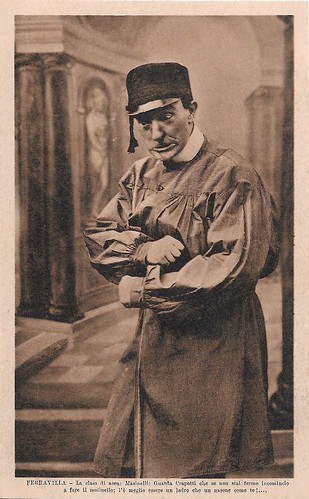
Italian postcard by IPA CT Duplex, no. 5894. Photo: Comerio, Milano / V. Uff. Rev. St. Terni. Edoardo Ferravilla in Ferravilla nelle sue più caratteristiche interpretazioni/Ferravilla in his most characteristic interpretations (Arnaldo Giacomelli, 1915). Caption in Milanese dialect: Masinelli: Watch out, Crapotti, if you don't stand still, I will become a vortex. It is better to be a thief than a nosebody like you.

Italian postcard by IPA CT Duplex, no. 5895. Photo: Fot. Comerio, Milano / V. Uff. Rev. St. Terni. Edoardo Ferravilla in Ferravilla nelle sue più caratteristiche interpretazioni/Ferravilla in his most characteristic interpretations (Arnaldo Giacomelli, 1915). Caption in Milanese dialect: Gajna (the drunkard): Is it me wanting to meet the light or is it the light wanting to meet me?
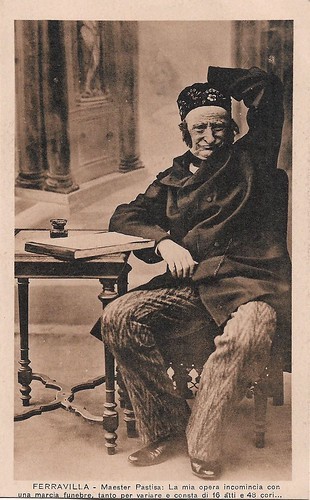
Italian postcard by IPA CT Duplex, no. 5896. Photo: Comerio, Milano / V. Uff. Rev. St. Terni.Edoardo Ferravilla in Ferravilla nelle sue più caratteristiche interpretazioni/Ferravilla in his most characteristic interpretations (Arnaldo Giacomelli, 1915). Caption in Milanese dialect: Maester Pastisa: My opera will start with a funeral march, just for a change, and will consist of 16 acts and 48 choruses. Mocking Italian composers, Ferravilla here performs his character Maester Pastisa.
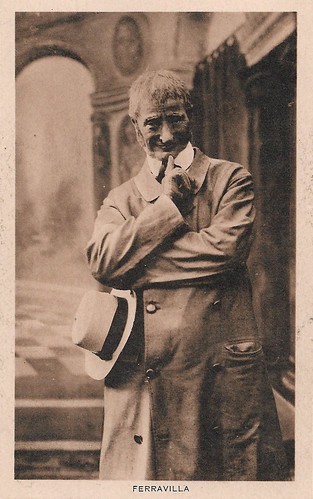
Italian postcard by IPA CT Duplex, no. 5897. Photo: Fot. Comerio, Milano / V. Uff. Rev. St. Terni.
Verdi and Queen Margherita among his fans
Edoardo Ferravilla was born in Milano, Italy in 1846. As an actor Ferravilla would always perform in the Milanese dialect.
The surname Ferravilla might have been the union between the initials of the mother's surname, the variety actress Luisa Maria Ferrari, and that of his natural father, Marquis Filippo Villani, so his nom de plume would be a pseudonym of Edoardo Villani.
According to the Enciclopedia Italiana, though, his mother was the Portuguese singer Giulia Ferravilla, whose surname he then adopted. An orphan of his mother at the age of six and abandoned by his father who married a dancer, he was adopted by the family of his guardian, the accountant Vigliezzi.
Discovered as an actor by Cletto Arrighi, founder of the Teatro Milanese, he acted with him from 1870 on. He made his debut in the comedy 'El Barchett de Boffalora', which would become one of the most important in his repertoire. He would stage it hundreds of times.
He soon became the darling of the Italian public. Even opera composer Giuseppe Verdi and Queen Margherita were among his fans. This success allowed him to take the artistic direction of the theatre company in 1876. During the second half of the nineteenth century, he was active in various theatre companies
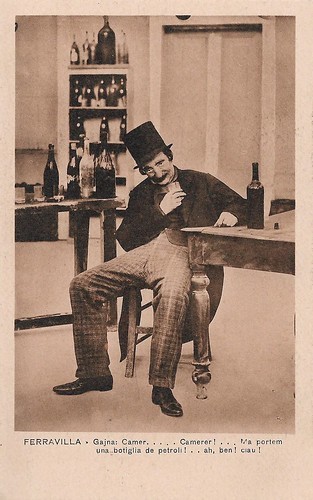
Italian postcard by IPA CT Duplex, no. 5898. Photo: Fot. Comerio, Milano / V. Uff. Rev. St. Terni. Caption in Milanese dialect: Gajna (the drunkard): Wait...Waiter!... Bring me a bottle of petrol! ...Ah, well! ciao! Here Ferravilla performs his character Tecoppa.
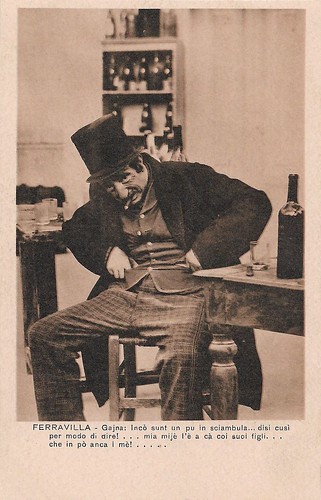
Italian postcard by IPA CT Duplex, no. 5899. Photo: Comerio, Milano / V. Uff. Rev. St. Terni. Edoardo Ferravilla in Tecoppa & c. (1914). Caption in Milanese dialect: Gajna, I am a bit in shambles, so to say! My wife is at home with her children, which are a bit also mine! Here Ferravilla performs his character Tecoppa.
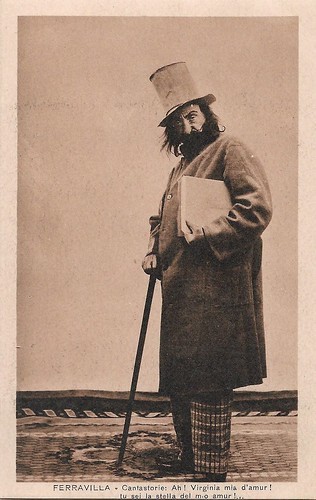
Italian postcard by IPA CT Duplex, no. 5900. Photo: Fot. Comerio, Milano / V. Uff. Rev. St. Terni. Caption [in Milanese dialect]: The songwriter: Ah! Virginia, my love! You are the star of my love! Here Ferravilla performs his character Gigione.
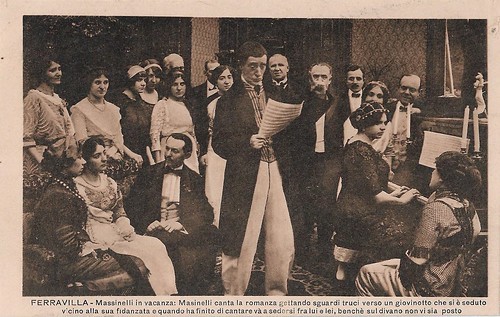
Italian postcard by IPA CT Duplex, no. 5901. Photo: Fot. Comerio, Milano / V. Uff. Rev. St. Terni. Ferravilla in Massinelli in vacanza (Arnaldo Giacomelli, 1914). Caption: Massinelli sings a romantic song, while grimly glaring a young man sitting next to his fiancee, and when he has finished singing, he will sit down next to him and her, even if there is no place anymore on the sofa.
Legendary for his naturalness
In 1900, Edoardo Ferravilla published his memoir as Edoardo Ferravilla parla della sua vita, della sua arte, del suo teatro (Edoardo Ferravilla talks about his life, his art, his theatre). From 1902 on, he alternated his appearances on the scene alternated with longer and longer periods of rest.
During his career, Ferravilla wrote some 22 comedies, vaudeville acts, farces and parodies, often reworkings of existing farces by other actors. Ferravilla was legendary for the naturalness with which he interpreted comedies in the vernacular language. He created a series of very important characters in the imagination of the Milanese public of the late nineteenth century: Massinelli, El sciur Pànera, Gigione, Master Pastizza, and Tecoppa.
He also performed these characters in the cinema. In the eve of World War I, he performed in several comical and theatrical short films, shot between 1913 and 1915. He thus immortalised some of his most popular sketches, and linked the early cinema to the repertoire of an ancient stage tradition.
First he worked at Mediolanum Film and then at Comerio Films, the company of Luca Comerio. Actor Piero Mazzarella considered him his artistic father, and in some comedies, he also recreated his characters, including the aforementioned Tecoppa.
The Cineteca Italiana in Milan recently restored 5 film sketches with Ferravilla and released them on DVD: Tecoppa e gli altri personaggi di Edoardo Ferravilla. The related film titles are: Ferravilla nelle sue più caratteristiche interpretazioni/Ferravilla in his most characteristic interpretations, Tecoppa & c., La class di asen/The class of asses, Massinelli in vacanza/Massinelli on vacation, and Ferravilla al trucco, all dating from 1914. Apart from Tecoppa & c., all films were directed by Arnaldo Giacomelli.
At the Paolo Grassi Library in Milan, a sound fragment with Ferravilla's voice was discovered which matched with one of the films restored by the Cineteca Italiano, Scena a soggetto musicale (Arnaldo Giacomelli, 1915), in which he appeared with his wife Maria Ferravilla. It is the exceptional testimony of how 'experimental' cinema was already in 1915!
In the autumn of 1915, Edoardo Ferravilla passed away in his beloved hometown Milan.
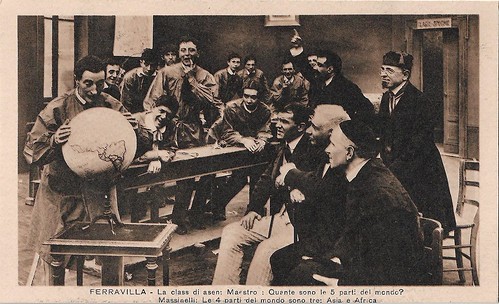
Italian postcard by IPA CT Duplex, no. 5902. Photo: Fot. Comerio, Milano / V. Uff. Rev. St. Terni. Ferravilla in La class di asen (Arnaldo Giacomelli, 1914). La class di asen is Milanese dialect for La classe degli asini (The class of the asses). Caption: Teacher: What are the five continents of the world? Massinelli: The four contents of the world are three: Asia and Africa.
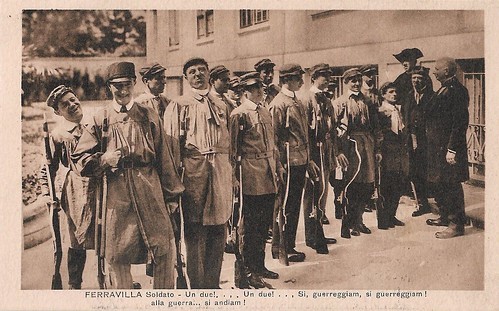
Italian postcard by IPA CT Duplex, no. 5903. Fot. Comerio, Milano / V. Uff. Rev. St. Terni. The card refers probably to La class di asen (Arnaldo Giacomelli, 1914), staring Ferravilla. Caption: Ferravilla as soldier - One two... One two!... Yes, let's go to war! To war, we'll go!
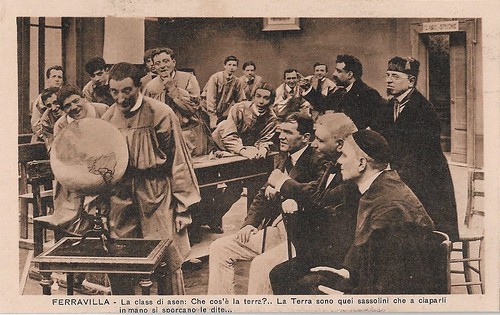
Italian postcard by IPA CT Duplex, no. 5904. Photo: Fot. Comerio, Milano / V. Uff. Rev. St. Terni. Postcard for the film La class di asen (Arnaldo Giacomelli, 1914). Caption: What is earth? Earth are those little stones that dirt your fingers when you pick them up.
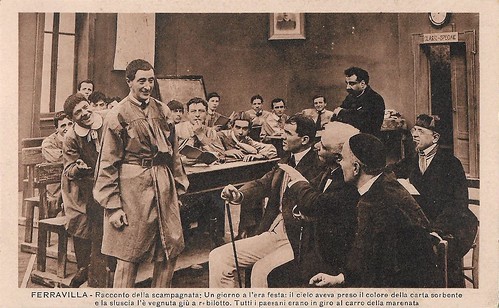
Italian postcard by IPA CT Duplex, no. 5905. Photo: Fot. Comerio, Milano / V. Uff. Rev. St. Terni. Ferravilla in La class di asen (Arnaldo Giacomelli, 1914). La class di asen is Milanese dialect for La classe degli asini (The class of the asses). Caption partly in Milanese dialect: The story of the excursion. One day it was party time, the sky had taken the color of blotting paper, and then the rain came pouring down. All the farmers grouped around the cart with the marenata (marenata is a typical dessert made with amarene/ black cherries).
Sources: Cineteca Milano (Italian), Enciclopedia Treccani (Italian), Wikipedia (Italian) and
With special thanks to Marcello Seregni for helping us to translate the captions.

Italian postcard by IPA CT Duplex, no. 5894. Photo: Comerio, Milano / V. Uff. Rev. St. Terni. Edoardo Ferravilla in Ferravilla nelle sue più caratteristiche interpretazioni/Ferravilla in his most characteristic interpretations (Arnaldo Giacomelli, 1915). Caption in Milanese dialect: Masinelli: Watch out, Crapotti, if you don't stand still, I will become a vortex. It is better to be a thief than a nosebody like you.

Italian postcard by IPA CT Duplex, no. 5895. Photo: Fot. Comerio, Milano / V. Uff. Rev. St. Terni. Edoardo Ferravilla in Ferravilla nelle sue più caratteristiche interpretazioni/Ferravilla in his most characteristic interpretations (Arnaldo Giacomelli, 1915). Caption in Milanese dialect: Gajna (the drunkard): Is it me wanting to meet the light or is it the light wanting to meet me?

Italian postcard by IPA CT Duplex, no. 5896. Photo: Comerio, Milano / V. Uff. Rev. St. Terni.Edoardo Ferravilla in Ferravilla nelle sue più caratteristiche interpretazioni/Ferravilla in his most characteristic interpretations (Arnaldo Giacomelli, 1915). Caption in Milanese dialect: Maester Pastisa: My opera will start with a funeral march, just for a change, and will consist of 16 acts and 48 choruses. Mocking Italian composers, Ferravilla here performs his character Maester Pastisa.

Italian postcard by IPA CT Duplex, no. 5897. Photo: Fot. Comerio, Milano / V. Uff. Rev. St. Terni.
Verdi and Queen Margherita among his fans
Edoardo Ferravilla was born in Milano, Italy in 1846. As an actor Ferravilla would always perform in the Milanese dialect.
The surname Ferravilla might have been the union between the initials of the mother's surname, the variety actress Luisa Maria Ferrari, and that of his natural father, Marquis Filippo Villani, so his nom de plume would be a pseudonym of Edoardo Villani.
According to the Enciclopedia Italiana, though, his mother was the Portuguese singer Giulia Ferravilla, whose surname he then adopted. An orphan of his mother at the age of six and abandoned by his father who married a dancer, he was adopted by the family of his guardian, the accountant Vigliezzi.
Discovered as an actor by Cletto Arrighi, founder of the Teatro Milanese, he acted with him from 1870 on. He made his debut in the comedy 'El Barchett de Boffalora', which would become one of the most important in his repertoire. He would stage it hundreds of times.
He soon became the darling of the Italian public. Even opera composer Giuseppe Verdi and Queen Margherita were among his fans. This success allowed him to take the artistic direction of the theatre company in 1876. During the second half of the nineteenth century, he was active in various theatre companies

Italian postcard by IPA CT Duplex, no. 5898. Photo: Fot. Comerio, Milano / V. Uff. Rev. St. Terni. Caption in Milanese dialect: Gajna (the drunkard): Wait...Waiter!... Bring me a bottle of petrol! ...Ah, well! ciao! Here Ferravilla performs his character Tecoppa.

Italian postcard by IPA CT Duplex, no. 5899. Photo: Comerio, Milano / V. Uff. Rev. St. Terni. Edoardo Ferravilla in Tecoppa & c. (1914). Caption in Milanese dialect: Gajna, I am a bit in shambles, so to say! My wife is at home with her children, which are a bit also mine! Here Ferravilla performs his character Tecoppa.

Italian postcard by IPA CT Duplex, no. 5900. Photo: Fot. Comerio, Milano / V. Uff. Rev. St. Terni. Caption [in Milanese dialect]: The songwriter: Ah! Virginia, my love! You are the star of my love! Here Ferravilla performs his character Gigione.

Italian postcard by IPA CT Duplex, no. 5901. Photo: Fot. Comerio, Milano / V. Uff. Rev. St. Terni. Ferravilla in Massinelli in vacanza (Arnaldo Giacomelli, 1914). Caption: Massinelli sings a romantic song, while grimly glaring a young man sitting next to his fiancee, and when he has finished singing, he will sit down next to him and her, even if there is no place anymore on the sofa.
Legendary for his naturalness
In 1900, Edoardo Ferravilla published his memoir as Edoardo Ferravilla parla della sua vita, della sua arte, del suo teatro (Edoardo Ferravilla talks about his life, his art, his theatre). From 1902 on, he alternated his appearances on the scene alternated with longer and longer periods of rest.
During his career, Ferravilla wrote some 22 comedies, vaudeville acts, farces and parodies, often reworkings of existing farces by other actors. Ferravilla was legendary for the naturalness with which he interpreted comedies in the vernacular language. He created a series of very important characters in the imagination of the Milanese public of the late nineteenth century: Massinelli, El sciur Pànera, Gigione, Master Pastizza, and Tecoppa.
He also performed these characters in the cinema. In the eve of World War I, he performed in several comical and theatrical short films, shot between 1913 and 1915. He thus immortalised some of his most popular sketches, and linked the early cinema to the repertoire of an ancient stage tradition.
First he worked at Mediolanum Film and then at Comerio Films, the company of Luca Comerio. Actor Piero Mazzarella considered him his artistic father, and in some comedies, he also recreated his characters, including the aforementioned Tecoppa.
The Cineteca Italiana in Milan recently restored 5 film sketches with Ferravilla and released them on DVD: Tecoppa e gli altri personaggi di Edoardo Ferravilla. The related film titles are: Ferravilla nelle sue più caratteristiche interpretazioni/Ferravilla in his most characteristic interpretations, Tecoppa & c., La class di asen/The class of asses, Massinelli in vacanza/Massinelli on vacation, and Ferravilla al trucco, all dating from 1914. Apart from Tecoppa & c., all films were directed by Arnaldo Giacomelli.
At the Paolo Grassi Library in Milan, a sound fragment with Ferravilla's voice was discovered which matched with one of the films restored by the Cineteca Italiano, Scena a soggetto musicale (Arnaldo Giacomelli, 1915), in which he appeared with his wife Maria Ferravilla. It is the exceptional testimony of how 'experimental' cinema was already in 1915!
In the autumn of 1915, Edoardo Ferravilla passed away in his beloved hometown Milan.

Italian postcard by IPA CT Duplex, no. 5902. Photo: Fot. Comerio, Milano / V. Uff. Rev. St. Terni. Ferravilla in La class di asen (Arnaldo Giacomelli, 1914). La class di asen is Milanese dialect for La classe degli asini (The class of the asses). Caption: Teacher: What are the five continents of the world? Massinelli: The four contents of the world are three: Asia and Africa.

Italian postcard by IPA CT Duplex, no. 5903. Fot. Comerio, Milano / V. Uff. Rev. St. Terni. The card refers probably to La class di asen (Arnaldo Giacomelli, 1914), staring Ferravilla. Caption: Ferravilla as soldier - One two... One two!... Yes, let's go to war! To war, we'll go!

Italian postcard by IPA CT Duplex, no. 5904. Photo: Fot. Comerio, Milano / V. Uff. Rev. St. Terni. Postcard for the film La class di asen (Arnaldo Giacomelli, 1914). Caption: What is earth? Earth are those little stones that dirt your fingers when you pick them up.

Italian postcard by IPA CT Duplex, no. 5905. Photo: Fot. Comerio, Milano / V. Uff. Rev. St. Terni. Ferravilla in La class di asen (Arnaldo Giacomelli, 1914). La class di asen is Milanese dialect for La classe degli asini (The class of the asses). Caption partly in Milanese dialect: The story of the excursion. One day it was party time, the sky had taken the color of blotting paper, and then the rain came pouring down. All the farmers grouped around the cart with the marenata (marenata is a typical dessert made with amarene/ black cherries).
Sources: Cineteca Milano (Italian), Enciclopedia Treccani (Italian), Wikipedia (Italian) and
With special thanks to Marcello Seregni for helping us to translate the captions.
Published on January 12, 2020 22:00
January 11, 2020
A Dog's Life (1918)
The 35 minutes short A Dog's Life (1918) was Charlie Chaplin's first film for First National Films under a $1M contract where Chaplin had full creative control over his films for the first time. His co-star is Mut who plays the stray dog Scraps. As the title says, Scraps is the hero of the film, as he helps the Tramp and dance hall singer Edna (Edna Purviance) towards a better life. A small part as a lunchwagon owner is played by Sydney Chaplin. It was the first time the two brothers were on screen together. A Dog's Life was a worthy predecessor for Chaplin's first full-length feature The Kid (1921). This postcard series by the Spanish chocolate manufacturer Amatller, Marca Luna, was collected by Ivo Blom. In the coming months, we'll do more film specials at EFSP on other series by Amattler.
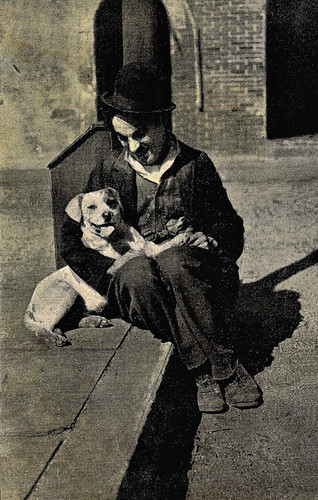
Spanish postcard by Chocolate Amatller, Marca Luna, series 9, no. 11. Photo: First National. Charlie Chaplin in A Dog's Life (Charles Chaplin, 1918).
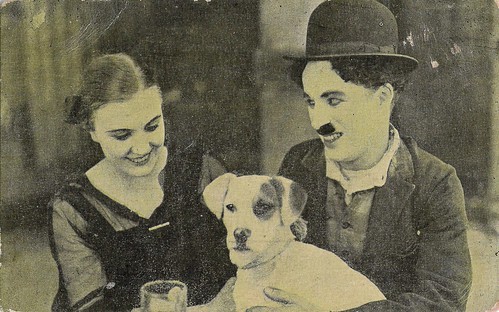
Spanish postcard by Chocolate Amatller, Marca Luna, series 9, no. 1. Photo: First National. Edna Purviance and Charlie Chaplin in A Dog's Life (Charles Chaplin, 1918).
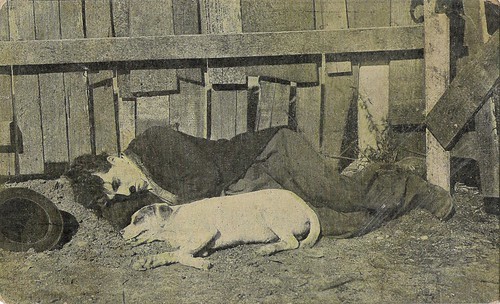
Spanish postcard by Chocolate Amatller, Marca Luna, series 9, no. 3. Photo: First National. Charlie Chaplin in A Dog's Life (Charles Chaplin, 1918).
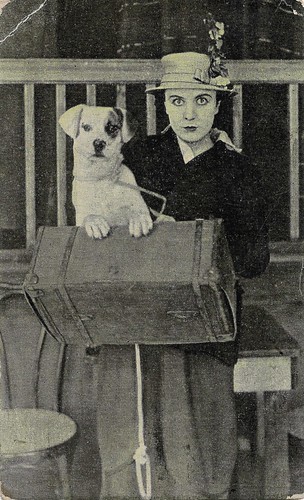
Spanish postcard by Chocolate Amatller, Marca Luna, series 9, no. 4. Photo: First National. Edna Purviance in A Dog's Life (Charles Chaplin, 1918).
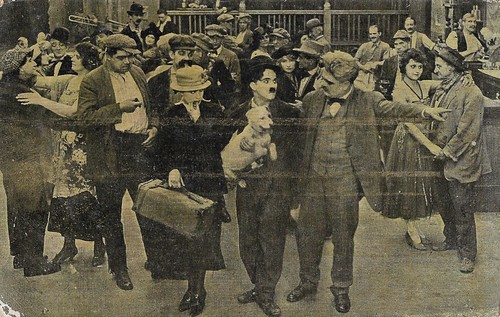
Spanish postcard by Chocolate Amatller, Marca Luna, series 9, no. 6. Photo: First National. Edna Purviance and Charlie Chaplin in A Dog's Life (Charles Chaplin, 1918). Granville Redmond played the dancehall owner.
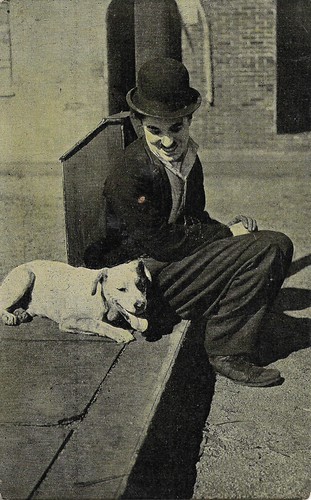
Spanish postcard by Chocolate Amatller, Marca Luna, series 9, no. 10. Photo: First National. Charlie Chaplin in A Dog's Life (Charles Chaplin, 1918).
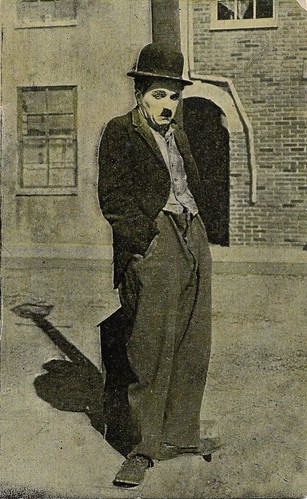
Spanish postcard by Chocolate Amatller, Marca Luna, series 9, no. 12. Photo: First National. Charlie Chaplin in A Dog's Life (Charles Chaplin, 1918).
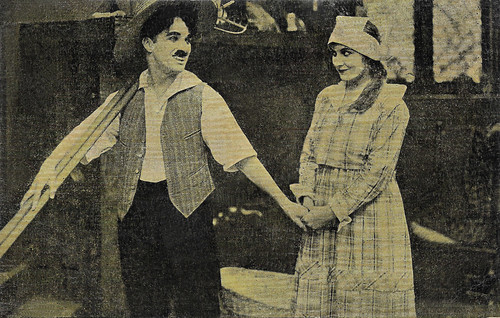
Spanish postcard by Chocolate Amatller, Marca Luna, series 9, no. 13. Photo: First National. Charlie Chaplin and Edna Purviance in A Dog's Life (Charles Chaplin, 1918).
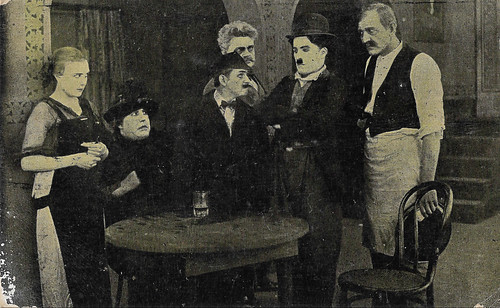
Spanish postcard by Chocolate Amatller, Marca Luna, series 9, no. 15. Photo: First National. Edna Purviance and Charlie Chaplin in A Dog's Life (Charles Chaplin, 1918). Second from left: Henry Bergman.
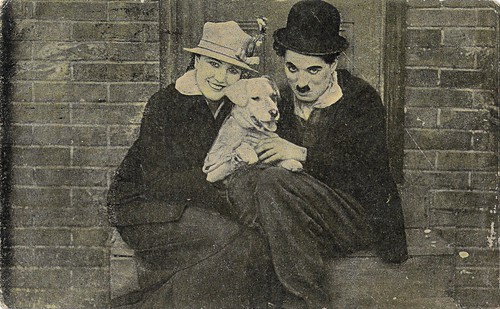
Spanish postcard by Chocolate Amatller, Marca Luna, series 9, no. 16. Photo: First National. Edna Purviance and Charlie Chaplin in A Dog's Life (Charles Chaplin, 1918).
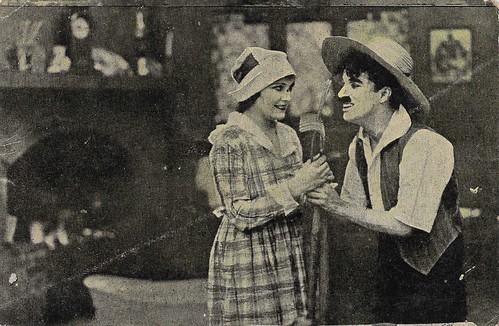
Spanish postcard by Chocolate Amatller, Marca Luna, series 9, no. 17. Photo: First National. Edna Purviance and Charlie Chaplin in A Dog's Life (Charles Chaplin, 1918).
Sources: Wikipedia and IMDb

Spanish postcard by Chocolate Amatller, Marca Luna, series 9, no. 11. Photo: First National. Charlie Chaplin in A Dog's Life (Charles Chaplin, 1918).

Spanish postcard by Chocolate Amatller, Marca Luna, series 9, no. 1. Photo: First National. Edna Purviance and Charlie Chaplin in A Dog's Life (Charles Chaplin, 1918).

Spanish postcard by Chocolate Amatller, Marca Luna, series 9, no. 3. Photo: First National. Charlie Chaplin in A Dog's Life (Charles Chaplin, 1918).

Spanish postcard by Chocolate Amatller, Marca Luna, series 9, no. 4. Photo: First National. Edna Purviance in A Dog's Life (Charles Chaplin, 1918).

Spanish postcard by Chocolate Amatller, Marca Luna, series 9, no. 6. Photo: First National. Edna Purviance and Charlie Chaplin in A Dog's Life (Charles Chaplin, 1918). Granville Redmond played the dancehall owner.

Spanish postcard by Chocolate Amatller, Marca Luna, series 9, no. 10. Photo: First National. Charlie Chaplin in A Dog's Life (Charles Chaplin, 1918).

Spanish postcard by Chocolate Amatller, Marca Luna, series 9, no. 12. Photo: First National. Charlie Chaplin in A Dog's Life (Charles Chaplin, 1918).

Spanish postcard by Chocolate Amatller, Marca Luna, series 9, no. 13. Photo: First National. Charlie Chaplin and Edna Purviance in A Dog's Life (Charles Chaplin, 1918).

Spanish postcard by Chocolate Amatller, Marca Luna, series 9, no. 15. Photo: First National. Edna Purviance and Charlie Chaplin in A Dog's Life (Charles Chaplin, 1918). Second from left: Henry Bergman.

Spanish postcard by Chocolate Amatller, Marca Luna, series 9, no. 16. Photo: First National. Edna Purviance and Charlie Chaplin in A Dog's Life (Charles Chaplin, 1918).

Spanish postcard by Chocolate Amatller, Marca Luna, series 9, no. 17. Photo: First National. Edna Purviance and Charlie Chaplin in A Dog's Life (Charles Chaplin, 1918).
Sources: Wikipedia and IMDb
Published on January 11, 2020 22:00
January 10, 2020
New Acquisitions: Kino-Autogrammkarten
Lately, I found this series of German autograph cards on eBay. These 'Autogrammkarten' were published by film magazine Kino in the late 1980s and early 1990s. Four cards were printed on one sheet which was glued into each magazine, and the reader had to tear them loose. Bravo magazine in Germany and other European magazines also supplied these kind of cards in this way as, an extra for their readers. A Kino-Autogrammkarte consists of a star photo, a pre-printed autograph and the Kino logo on the front side and on the other side: biographical information, a contact address and a film list, which always stops in 1988, 1989 or 1990. I like these cards because the range of stars is much more varied than on the film star postcards of that period. Here you find other faces than just the Hollywood mega stars, such as one-time Oscar nominated Sally Kirkland or B-movie Queen Sybil Danning.

German autograph card by Kino.
In the Swinging Sixties, shy, awkward-looking British actress Jane Birkin (1946) made a huge international splash as one of the nude models in Antonioni's Blow-Up (1966). In France she became the muse of singer-songwriter Serge Gainsbourg , who wrote several of her albums, plus their explicitly erotic duet Je t'aime... moi non plus. Later she worked with such respected film directors as Jacques Rivette, Agnès Varda and Jacques Doillon, and won several acting awards.

German autograph card by Kino.
English actress Jacqueline Bisset (1944) has been an international film star since the late 1960s. She received her first roles mainly because of her stunning beauty, but over time she has become a fine actress respected by fans and critics alike. Bisset has worked with directors John Huston, François Truffaut, George Cukor and Roman Polanski. She received France’s Légion d'honneur in 2010.
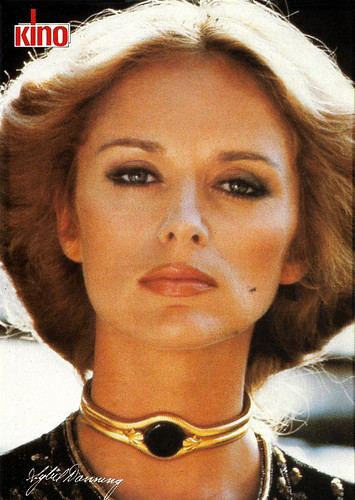
German autograph card by Kino, ca. 1988.
Austrian actress Sybil Danning (1949) was a statuesque blonde beauty who became a dynamic and commanding B-movie queen. Never a helpless victim or mere boy-toy, the voluptuous Danning gained her widest audience with a series of sweat-drenched action pictures in the 1980s. For her work in Chained Heat (1983) and Hercules (1983), she won a Golden Razzie.
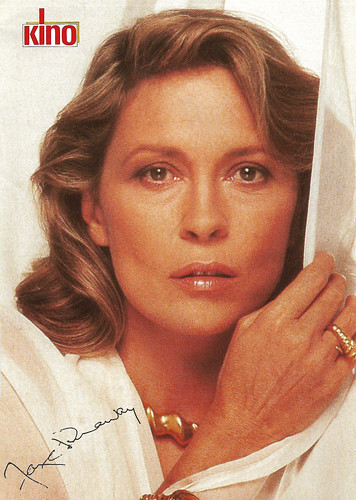
German autograph card by Kino, ca. 1988.
American film actress Faye Dunaway (1941) is a classic beauty with high cheekbones and a husky resonant voice. She had her breakthrough as Bonnie Parker in Bonnie and Clyde (1967) and became one of Hollywood's biggest stars of the 1970s with Chinatown (1974), Three Days of the Condor (1975) and Network (1976), for which she won the Oscar.
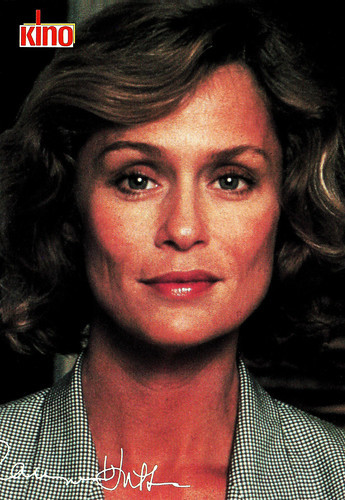
German autograph card by Kino, 1988.
Over her career, Lauren Hutton (1943) has worked both as a model and an actress. Though she was initially dismissed by agents for a signature gap in her teeth, Hutton signed a modelling contract with Revlon in 1973, which at the time was the biggest contract in the history of the modelling industry. She made her film debut in the sports drama Paper Lion (1968) and played leading roles in The Gambler (1974) and American Gigolo (1980). On television, she appeared in such series as Paper Dolls (1984) and Nip/Tuck (2007).
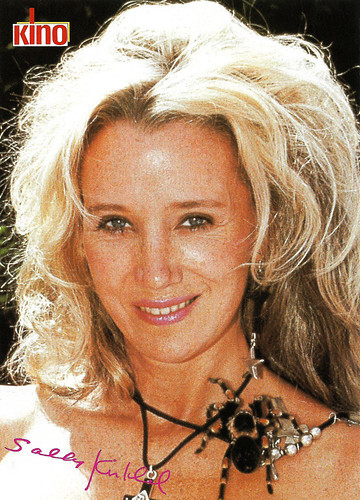
German Autograph card by Kino.
American actress Sally Kirkland (1941) received a Golden Globe and an Oscar nomination for her performance in Anna (1987). She is also known for Cold Feet (1989), and The Haunted (1991).
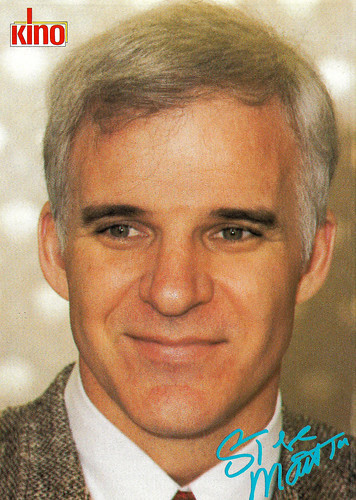
German autograph card by Kino.
American actor Steve Martin (1945) is also known as a comedian, writer, and musician. Martin came to public notice in the 1960s as a writer for The Smothers Brothers Comedy Hour, and later as a frequent guest on The Tonight Show and Saturday Night Live. Martin performed his offbeat, absurdist comedy routines before packed houses on national tours. His collaboration with writer-director-actor Carl Reiner on the hit comedies The Jerk (1979), Dead Men Don’t Wear Plaid (1982), The Man with Two Brains (1983), and All of Me (1984) established Martin as a film star of the first rank. Since the 1980s, Martin also became an author, playwright, pianist, and banjo player.
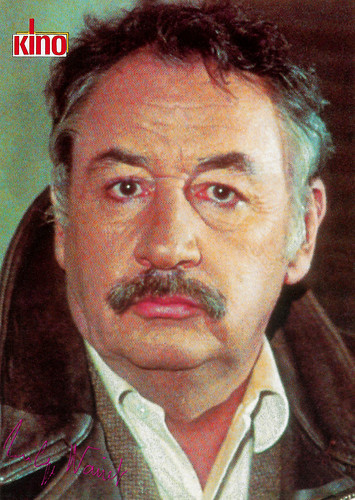
German autograph card by Kino.
French film actor Philippe Noiret (1930-2006) acted in several Hollywood productions, but he is best known for his roles as Alfredo in Cinema Paradiso (1988), Pablo Neruda in Il Postino (1994), and Major Dellaplane in Bertrand Tavernier's La vie et rien d'autre/Life and Nothing But (1989).
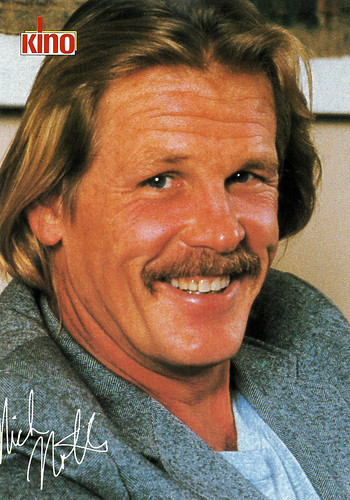
German autograph card by Kino, 1988.
American actor Nick Nolte (1941) won a Golden Globe Award and was nominated for the Oscar for his role in The Prince of Tides (1991). He went on to receive Academy Award nominations for Affliction (1998) and Warrior (2011). His other film appearances include The Deep (1977), 48 Hrs. (1982), Down and Out in Beverly Hills (1986), Cape Fear (1991), The Thin Red Line (1998), and Hotel Rwanda (2004).
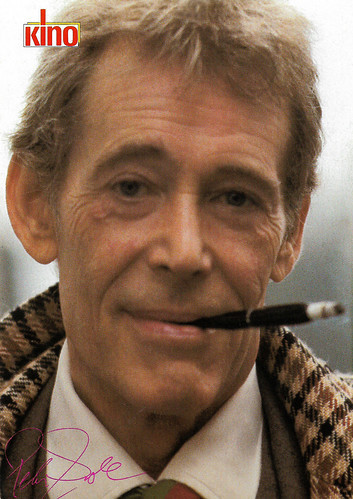
German autograph card by Kino.
Golden-haired, blue-eyed Peter O'Toole (1932-2013) became an international superstar with his unforgettable turn as the British expatriate T.E. Lawrence in David Lean's epic masterpiece Lawrence of Arabia (1962). After surviving cancer and alcoholism, O’Toole made a triumphant come-back with Oscar nominated appearances in The Stunt Man (1980) and My Favorite Year (1982).

German autograph card by Kino.
French actor Michel Piccoli (1925) has appeared in many different roles, from seducer to cop to gangster to Pope in more than 200 films and TV films. Among the directors he worked with are Jean Renoir, Jean-Pierre Melville, Jean-Luc Godard, Agnès Varda, Luis Buñuel, and Alfred Hitchcock.

German autograph card by Kino, ca. 1988.
Canadian-born actor William Shatner, (1931) is best known as Captain James Tiberius 'Jim' Kirk, the main character in the classic American TV series Star Trek and its subsequent films. As the commander of the starship U.S.S. Enterprise, square-jawed Kirk leads his crew as they explore "where no man has gone before".
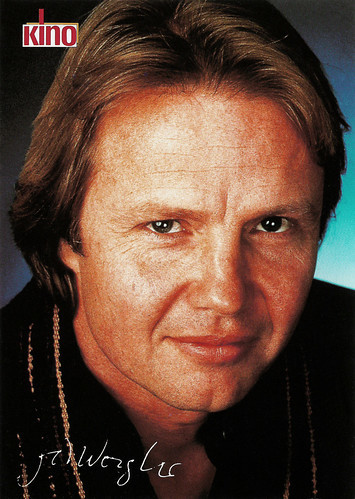
German autograph card by Kino.
American actor Jon Voight (1938) became a star playing the street hustler Joe Buck in the groundbreaking film Midnight Cowboy (1969). He had a successful career taking on challenging leading and character roles in a wide range of films and television shows. Voight is the father of actress Angelina Jolie and actor James Haven.
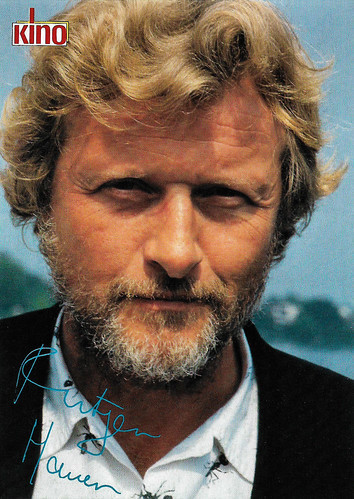
German autograph card by Kino, ca. 1989.
Blonde, blue-eyed, tall and handsome Dutch actor Rutger Hauer (1944-2019) played everything - from romantic leads to action heroes to sinister villains. During the 1970s, he had his international breakthrough with the Dutch films by Paul Verhoeven and later he became a cult star with Blade Runner (1982), The Hitcher (1986) and Blind Fury (1989). Before that he was the hero of many Dutch kids in the classic TV series Floris (1969), also directed by Verhoeven.
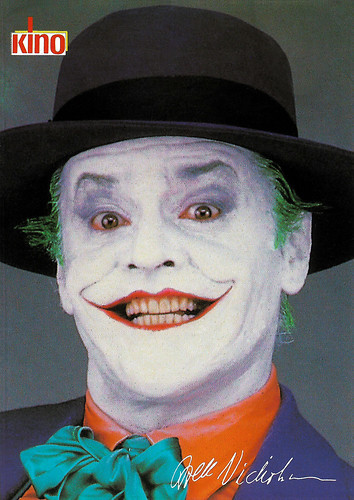
German autograph card by Kino. Photo: Jack Nicholson in Batman (Tim Burton, 1989).
Jack Nicholson (1937) is an American actor and filmmaker who has performed for over sixty years. His rise in Hollywood was far from meteoric, and for years, he sustained his career with guest spots in television series and Roger Corman films. He is known for his wide range of roles, including satirical comedy, romance, and dark portrayals of anti-heroes and villainous characters. In many films, he played rebels against the social structure. Nicholson's 12 Oscar nominations make him the most nominated male actor ever. He won the Oscars for Best Actor twice – for One Flew Over the Cuckoo's Nest (1975), and As Good as It Gets (1997), and the Oscar for Best Supporting Actor for Terms of Endearment (1983).

German autograph card by Kino, ca. 1989.
French actor Pierre Richard (1934) became popular as a clumsy daydreamer in comedy films of the 1970s. Richard is best known internationally as the star of the zany spy farce Le Grand Blond Avec Une Chassure Noire/The Tall Blond Man with One Black Shoe (1972) and for his hilarious comedies with Gérard Dépardieu . He also wrote and directed several films himself.
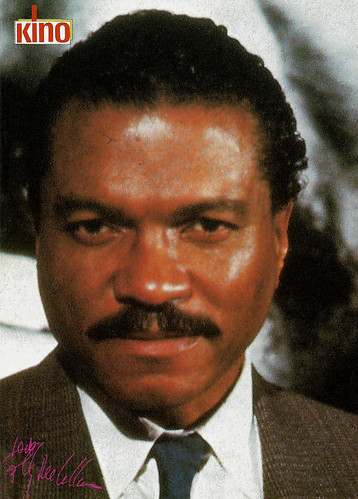
German autograph card by Kino, ca. 1989.
American actor Billy Dee Williams (1937) is best known as Lando Calrissian in the Star Wars franchise. First he starred in The Empire Strikes Back (1980), and Return of the Jedi (1983), and nearly forty years later again in The Rise of Skywalker (2019). Williams has appeared in at least 70 films over six decades.
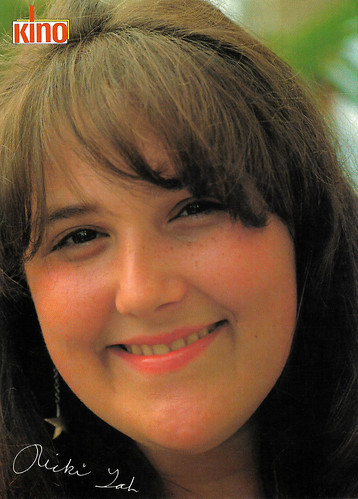
German autograph card by Kino, ca. 1990.
American actress Ricki Lake (1968) is best known for her lead role as Tracy Turnblad in John Waters' cult classic Hairspray (1988). She is also known for her talk show which was broadcast internationally between 1993 and 2004.
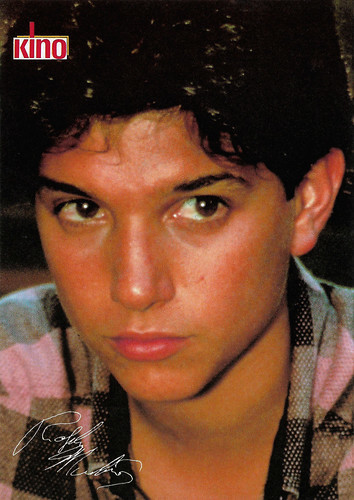
German autograph card by Kino, ca. 1990.
American actor Ralph Macchio Jr. (1961) became a teen idol with his role as Daniel LaRusso in three Karate Kid films. He is also known for his roles in The Outsiders (1983), My Cousin Vinny (1992), and the TV series Ugly Betty (2008-2009). In 2018, he returned as Daniel la Russo in the YouTube series Cobra Kai.

German autograph card by Kino.
In the Swinging Sixties, shy, awkward-looking British actress Jane Birkin (1946) made a huge international splash as one of the nude models in Antonioni's Blow-Up (1966). In France she became the muse of singer-songwriter Serge Gainsbourg , who wrote several of her albums, plus their explicitly erotic duet Je t'aime... moi non plus. Later she worked with such respected film directors as Jacques Rivette, Agnès Varda and Jacques Doillon, and won several acting awards.

German autograph card by Kino.
English actress Jacqueline Bisset (1944) has been an international film star since the late 1960s. She received her first roles mainly because of her stunning beauty, but over time she has become a fine actress respected by fans and critics alike. Bisset has worked with directors John Huston, François Truffaut, George Cukor and Roman Polanski. She received France’s Légion d'honneur in 2010.

German autograph card by Kino, ca. 1988.
Austrian actress Sybil Danning (1949) was a statuesque blonde beauty who became a dynamic and commanding B-movie queen. Never a helpless victim or mere boy-toy, the voluptuous Danning gained her widest audience with a series of sweat-drenched action pictures in the 1980s. For her work in Chained Heat (1983) and Hercules (1983), she won a Golden Razzie.

German autograph card by Kino, ca. 1988.
American film actress Faye Dunaway (1941) is a classic beauty with high cheekbones and a husky resonant voice. She had her breakthrough as Bonnie Parker in Bonnie and Clyde (1967) and became one of Hollywood's biggest stars of the 1970s with Chinatown (1974), Three Days of the Condor (1975) and Network (1976), for which she won the Oscar.

German autograph card by Kino, 1988.
Over her career, Lauren Hutton (1943) has worked both as a model and an actress. Though she was initially dismissed by agents for a signature gap in her teeth, Hutton signed a modelling contract with Revlon in 1973, which at the time was the biggest contract in the history of the modelling industry. She made her film debut in the sports drama Paper Lion (1968) and played leading roles in The Gambler (1974) and American Gigolo (1980). On television, she appeared in such series as Paper Dolls (1984) and Nip/Tuck (2007).

German Autograph card by Kino.
American actress Sally Kirkland (1941) received a Golden Globe and an Oscar nomination for her performance in Anna (1987). She is also known for Cold Feet (1989), and The Haunted (1991).

German autograph card by Kino.
American actor Steve Martin (1945) is also known as a comedian, writer, and musician. Martin came to public notice in the 1960s as a writer for The Smothers Brothers Comedy Hour, and later as a frequent guest on The Tonight Show and Saturday Night Live. Martin performed his offbeat, absurdist comedy routines before packed houses on national tours. His collaboration with writer-director-actor Carl Reiner on the hit comedies The Jerk (1979), Dead Men Don’t Wear Plaid (1982), The Man with Two Brains (1983), and All of Me (1984) established Martin as a film star of the first rank. Since the 1980s, Martin also became an author, playwright, pianist, and banjo player.

German autograph card by Kino.
French film actor Philippe Noiret (1930-2006) acted in several Hollywood productions, but he is best known for his roles as Alfredo in Cinema Paradiso (1988), Pablo Neruda in Il Postino (1994), and Major Dellaplane in Bertrand Tavernier's La vie et rien d'autre/Life and Nothing But (1989).

German autograph card by Kino, 1988.
American actor Nick Nolte (1941) won a Golden Globe Award and was nominated for the Oscar for his role in The Prince of Tides (1991). He went on to receive Academy Award nominations for Affliction (1998) and Warrior (2011). His other film appearances include The Deep (1977), 48 Hrs. (1982), Down and Out in Beverly Hills (1986), Cape Fear (1991), The Thin Red Line (1998), and Hotel Rwanda (2004).

German autograph card by Kino.
Golden-haired, blue-eyed Peter O'Toole (1932-2013) became an international superstar with his unforgettable turn as the British expatriate T.E. Lawrence in David Lean's epic masterpiece Lawrence of Arabia (1962). After surviving cancer and alcoholism, O’Toole made a triumphant come-back with Oscar nominated appearances in The Stunt Man (1980) and My Favorite Year (1982).

German autograph card by Kino.
French actor Michel Piccoli (1925) has appeared in many different roles, from seducer to cop to gangster to Pope in more than 200 films and TV films. Among the directors he worked with are Jean Renoir, Jean-Pierre Melville, Jean-Luc Godard, Agnès Varda, Luis Buñuel, and Alfred Hitchcock.

German autograph card by Kino, ca. 1988.
Canadian-born actor William Shatner, (1931) is best known as Captain James Tiberius 'Jim' Kirk, the main character in the classic American TV series Star Trek and its subsequent films. As the commander of the starship U.S.S. Enterprise, square-jawed Kirk leads his crew as they explore "where no man has gone before".

German autograph card by Kino.
American actor Jon Voight (1938) became a star playing the street hustler Joe Buck in the groundbreaking film Midnight Cowboy (1969). He had a successful career taking on challenging leading and character roles in a wide range of films and television shows. Voight is the father of actress Angelina Jolie and actor James Haven.

German autograph card by Kino, ca. 1989.
Blonde, blue-eyed, tall and handsome Dutch actor Rutger Hauer (1944-2019) played everything - from romantic leads to action heroes to sinister villains. During the 1970s, he had his international breakthrough with the Dutch films by Paul Verhoeven and later he became a cult star with Blade Runner (1982), The Hitcher (1986) and Blind Fury (1989). Before that he was the hero of many Dutch kids in the classic TV series Floris (1969), also directed by Verhoeven.

German autograph card by Kino. Photo: Jack Nicholson in Batman (Tim Burton, 1989).
Jack Nicholson (1937) is an American actor and filmmaker who has performed for over sixty years. His rise in Hollywood was far from meteoric, and for years, he sustained his career with guest spots in television series and Roger Corman films. He is known for his wide range of roles, including satirical comedy, romance, and dark portrayals of anti-heroes and villainous characters. In many films, he played rebels against the social structure. Nicholson's 12 Oscar nominations make him the most nominated male actor ever. He won the Oscars for Best Actor twice – for One Flew Over the Cuckoo's Nest (1975), and As Good as It Gets (1997), and the Oscar for Best Supporting Actor for Terms of Endearment (1983).

German autograph card by Kino, ca. 1989.
French actor Pierre Richard (1934) became popular as a clumsy daydreamer in comedy films of the 1970s. Richard is best known internationally as the star of the zany spy farce Le Grand Blond Avec Une Chassure Noire/The Tall Blond Man with One Black Shoe (1972) and for his hilarious comedies with Gérard Dépardieu . He also wrote and directed several films himself.

German autograph card by Kino, ca. 1989.
American actor Billy Dee Williams (1937) is best known as Lando Calrissian in the Star Wars franchise. First he starred in The Empire Strikes Back (1980), and Return of the Jedi (1983), and nearly forty years later again in The Rise of Skywalker (2019). Williams has appeared in at least 70 films over six decades.

German autograph card by Kino, ca. 1990.
American actress Ricki Lake (1968) is best known for her lead role as Tracy Turnblad in John Waters' cult classic Hairspray (1988). She is also known for her talk show which was broadcast internationally between 1993 and 2004.

German autograph card by Kino, ca. 1990.
American actor Ralph Macchio Jr. (1961) became a teen idol with his role as Daniel LaRusso in three Karate Kid films. He is also known for his roles in The Outsiders (1983), My Cousin Vinny (1992), and the TV series Ugly Betty (2008-2009). In 2018, he returned as Daniel la Russo in the YouTube series Cobra Kai.
Published on January 10, 2020 22:00
January 9, 2020
Zappy Max
Dynamic Zappy Max (1921-2019) was one of the most popular radio hosts in France and Belgium during the 1950s till the 1970s. He worked for Radio Luxembourg (now RTL) and Radio Monte Carlo (RMC), and his partner was Mr. Champagne. He also appeared in several French films, often as himself. In June 2019, Max passed away at the age of 97.
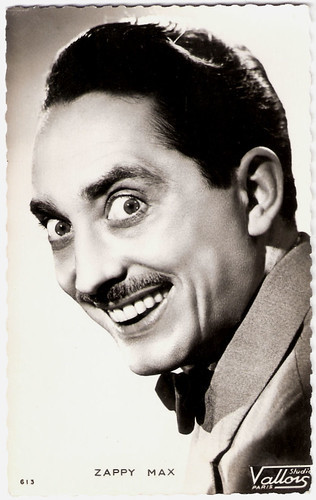
French postcard by Editions P.I., Paris, no. 613. Photo: Studio Vallois, Paris.
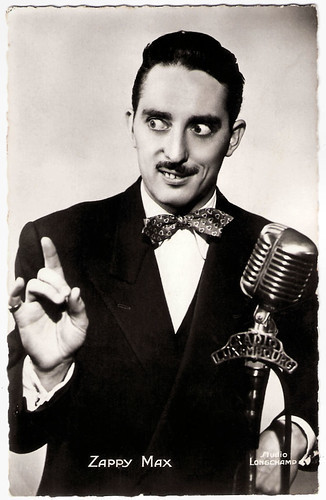
French postcard by Editions P.I., Paris / Édition du Radio-Circus, Paris, no. 2 10 A. Photo: Studio Longchamp.
A Passion for the Music-Hall
Zappy Max is the pseudonym of Maxime Doucet, who was born in Paris in 1921. He was the only son of Maxime and Julia Doucet.
He lost his father in 1937. His father passed him a passion for the Music-Hall. In 1941, Zappy began appearing in Music-Halls with the group The 5 Mathurins where he imitated Popeye in English wearing the uniform of the Marines.
In 1945, he became a singer and entertainer at the orchestra of Jacques Hélian, with whom he remained for two years.
In 1947, he went to work for Radio Luxembourg, where he hosted many games such as 'Quitte ou double' (Double or Nothing) and 'Crochet radiophonique'.
The 'Crochet radiophonique' was part of the Radio Circus, a combination of show, talent contest and game show created by Roger Audiffred and Jean Coupan. With Radio Circus, Zappy travelled all over France and Belgium. Radio-Circus gave shows for 10,000 to 20,000 spectators, while promoting Dop shampoo.
For Radio Luxembourg, Zappy made several radio serials: 'Vas-y Zappy' (Go Zappy), 'Ça va bouillir' (It will boil) and 'C'est parti mon Zappy' (It’s gone My Zappy). His contract at Radio Luxembourg ended in 1966 when the station became RTL. His eviction reportedly annoyed him very much.
Max continued his radio career from 1974 until 1982/1983 at Radio Monte Carlo (RMC). There he hosted the game 'Quitte ou double' (Double or Nothing) again.
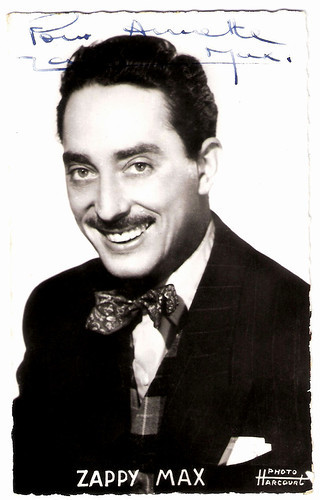
French postcard by Édition du Radio-Circus. Photo: Harcourt. Caption: Vedette des disques "Festival".
Hamming it up and rolling his eyes every five minutes
Zappy Max performed in plays and in several films. He made his first appearances as an extra. he was a musician in the Fernandel comedy Coeur de coq/Rooster Heart (Maurice Cloche, 1946) and played another bit part in the anthology film Souvenirs perdus/Lost Souvenirs (Christian Jacque, 1950).
Two years later, he appeared as himself in Quitte ou Double/Double or Nothing (Robert Vernay, 1952) with Suzanne Dehelly and Danielle Godet .
Max had his first leading part in the comedy Faites-Moi Confiance/Trust me (Gilles Grangier, 1954) with André Gabriello and Louis de Funès in a supporting part. DB DuMonteil at IMDb is not enthusiastic about Zappy's film antics: "On the screen, to put it mildly, he reveals himself a limited actor, hamming it up and rolling his eyes every five minutes."
There's a reference to his radio show in the classic thriller Les Diaboliques (Henri-Georges Clouzot, 1955): Simone Signoret 's tenants are listening to Zappy Max while their landlady is helping to murder her boyfriend.
Other films with Max include Les Chiffoniers d'Emmaüs/The Chiffoniers Emmaus (Robert Darène, 1955) with Dany Carrel , Les lumières du soir/The Evening Lights (Robert Vernay, 1956) with Gaby Morlay , and Printemps à Paris/Spring in Paris (Jean-Claude Roy, 1957) starring Dominique Boschero .
During the following decades, he did a few more performances in films and TV series. His last film appearance was in the drama Outremer/Overseas (Brigitte Roüan, 1990) with Nicole Garcia and Marianne Basler.
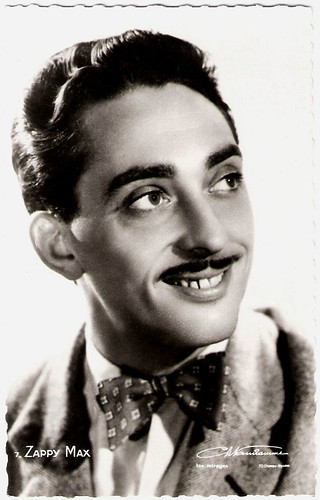
French postcard by Editions P.I., Paris, no. 7. Photo: Charles Vandamme, Paris.
It will boil!
Zappy Max published his memories in 'Ça va bouillir' (It will boil!, 2000) and 'L'âge d'or de la radio' (The Golden Age of Radio, 2004).
In 2005, he was awarded with the Prix Jean Nohain, and was also honoured as Chevalier (Knight) of the Ordre des Arts et des Lettres (Order of Arts and Letters).
A comic entitled 'Zappy Max: ça va bouillir' (Zappy Max: it's going to boil) was designed by Maurice Tillieux for the journal Pilote in 1959, but it was republished in 2010 by Editions de l'Élan.
That year, Max also published a new book about his passion for the Music-Hall: 'Mes GEANTS du music-hall' (My GIANTS of the Music-Hall).
Indefatigable, he announced a new book, 'Mes Z d'or... Mémoires d'un cinéphile' (My Golden Z ... Memoirs of a film buff), with portraits of his favourite actors.
However, Zappy Max passed away in 2019, before the book was published. He was 97.
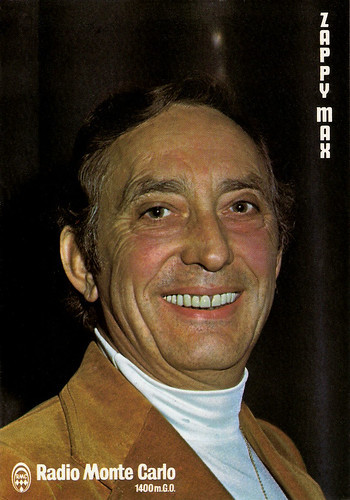
French postcard by Po, no. 7. Photo: Jean Louis Kramel. Caption: Radio Monte Carlo - 1400 m G;O.
Scopitone clip for the song Elle S'était Fait Couper Les Cheveux (She had her hair cut) by accordionist Aimable and Zappy Max. The clip was directed by Claude Lelouch. Source: Music Zone 1 (YouTube).
Sources: DB DuMonteil (IMDb), Wikipedia (French) and .

French postcard by Editions P.I., Paris, no. 613. Photo: Studio Vallois, Paris.

French postcard by Editions P.I., Paris / Édition du Radio-Circus, Paris, no. 2 10 A. Photo: Studio Longchamp.
A Passion for the Music-Hall
Zappy Max is the pseudonym of Maxime Doucet, who was born in Paris in 1921. He was the only son of Maxime and Julia Doucet.
He lost his father in 1937. His father passed him a passion for the Music-Hall. In 1941, Zappy began appearing in Music-Halls with the group The 5 Mathurins where he imitated Popeye in English wearing the uniform of the Marines.
In 1945, he became a singer and entertainer at the orchestra of Jacques Hélian, with whom he remained for two years.
In 1947, he went to work for Radio Luxembourg, where he hosted many games such as 'Quitte ou double' (Double or Nothing) and 'Crochet radiophonique'.
The 'Crochet radiophonique' was part of the Radio Circus, a combination of show, talent contest and game show created by Roger Audiffred and Jean Coupan. With Radio Circus, Zappy travelled all over France and Belgium. Radio-Circus gave shows for 10,000 to 20,000 spectators, while promoting Dop shampoo.
For Radio Luxembourg, Zappy made several radio serials: 'Vas-y Zappy' (Go Zappy), 'Ça va bouillir' (It will boil) and 'C'est parti mon Zappy' (It’s gone My Zappy). His contract at Radio Luxembourg ended in 1966 when the station became RTL. His eviction reportedly annoyed him very much.
Max continued his radio career from 1974 until 1982/1983 at Radio Monte Carlo (RMC). There he hosted the game 'Quitte ou double' (Double or Nothing) again.

French postcard by Édition du Radio-Circus. Photo: Harcourt. Caption: Vedette des disques "Festival".
Hamming it up and rolling his eyes every five minutes
Zappy Max performed in plays and in several films. He made his first appearances as an extra. he was a musician in the Fernandel comedy Coeur de coq/Rooster Heart (Maurice Cloche, 1946) and played another bit part in the anthology film Souvenirs perdus/Lost Souvenirs (Christian Jacque, 1950).
Two years later, he appeared as himself in Quitte ou Double/Double or Nothing (Robert Vernay, 1952) with Suzanne Dehelly and Danielle Godet .
Max had his first leading part in the comedy Faites-Moi Confiance/Trust me (Gilles Grangier, 1954) with André Gabriello and Louis de Funès in a supporting part. DB DuMonteil at IMDb is not enthusiastic about Zappy's film antics: "On the screen, to put it mildly, he reveals himself a limited actor, hamming it up and rolling his eyes every five minutes."
There's a reference to his radio show in the classic thriller Les Diaboliques (Henri-Georges Clouzot, 1955): Simone Signoret 's tenants are listening to Zappy Max while their landlady is helping to murder her boyfriend.
Other films with Max include Les Chiffoniers d'Emmaüs/The Chiffoniers Emmaus (Robert Darène, 1955) with Dany Carrel , Les lumières du soir/The Evening Lights (Robert Vernay, 1956) with Gaby Morlay , and Printemps à Paris/Spring in Paris (Jean-Claude Roy, 1957) starring Dominique Boschero .
During the following decades, he did a few more performances in films and TV series. His last film appearance was in the drama Outremer/Overseas (Brigitte Roüan, 1990) with Nicole Garcia and Marianne Basler.

French postcard by Editions P.I., Paris, no. 7. Photo: Charles Vandamme, Paris.
It will boil!
Zappy Max published his memories in 'Ça va bouillir' (It will boil!, 2000) and 'L'âge d'or de la radio' (The Golden Age of Radio, 2004).
In 2005, he was awarded with the Prix Jean Nohain, and was also honoured as Chevalier (Knight) of the Ordre des Arts et des Lettres (Order of Arts and Letters).
A comic entitled 'Zappy Max: ça va bouillir' (Zappy Max: it's going to boil) was designed by Maurice Tillieux for the journal Pilote in 1959, but it was republished in 2010 by Editions de l'Élan.
That year, Max also published a new book about his passion for the Music-Hall: 'Mes GEANTS du music-hall' (My GIANTS of the Music-Hall).
Indefatigable, he announced a new book, 'Mes Z d'or... Mémoires d'un cinéphile' (My Golden Z ... Memoirs of a film buff), with portraits of his favourite actors.
However, Zappy Max passed away in 2019, before the book was published. He was 97.

French postcard by Po, no. 7. Photo: Jean Louis Kramel. Caption: Radio Monte Carlo - 1400 m G;O.
Scopitone clip for the song Elle S'était Fait Couper Les Cheveux (She had her hair cut) by accordionist Aimable and Zappy Max. The clip was directed by Claude Lelouch. Source: Music Zone 1 (YouTube).
Sources: DB DuMonteil (IMDb), Wikipedia (French) and .
Published on January 09, 2020 22:00
January 8, 2020
Lido Manetti a.k.a. Arnold Kent
Italian actor Lido Manetti (1899-1928) had a prolific career as a young leading man in Italian silent cinema. He was brought to America and renamed Arnold Kent, but he died before living up to his promise.
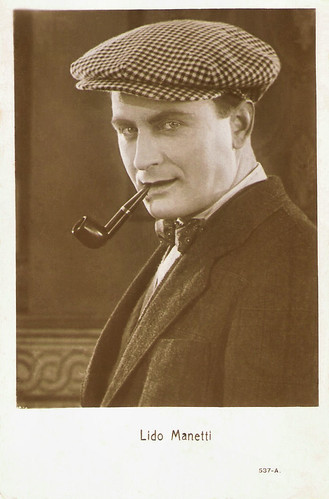
Italian postcard by G.B. Falci Editore, Milano, no. 537A.
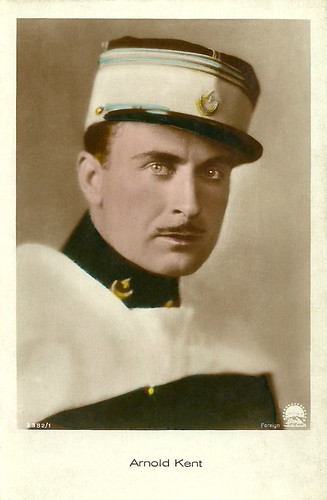
'Foreign' postcard by Ross Verlag, no. 3382/1, 1928-1929. Photo: Paramount.
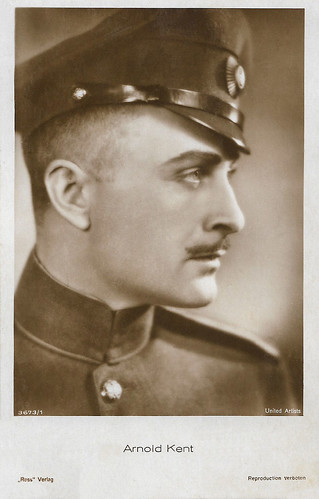
German postcard by Ross Verlag, no. 3673/1, 1928-1929. Photo: United Artists. Lido Manetti (Arnold Kent) in The Woman Disputed (Henry King, Sam Taylor, 1928).
Male Love Interest
Lido Manetti was born in Florence, Italy in 1899 (according to all our sources, but this must be a mistake, looking at his film curriculum with his first leading film roles already in 1917).
He studied civil engineering, but entered the theatre and then films subsequently to his schooling. His first Italian film was probably La principessa/The Princess (Camillo De Riso, 1917) starring diva Leda Gys for Caesar Film.
From then on Manetti would be the male love interest in many diva-like films such as Il processo Clemenceau/The Clemenceau Affair (Alfredo De Antoni, 1917) and Malia/Liliana (Alfredo De Antoni, 1917) both with Francesca Bertini , and La passagera/The Passager (Gero Zambuto, 1917) with Pina Menichelli .
In 1918 followed Addio giovinezza/Good-bye Youth (Augusto Genina, 1918) with both Maria Jacobini and Helena Makowska , Femmina/Female (Augusto Genina, 1918) with Italia Almirante Manzini , and L’onestà del peccato/The Wife He Neglected (Augusto Genina, 1918) with Maria Jacobini .
The next year saw Una donna funesta/A baleful woman (Camillo De Riso, 1919) with Tilde Kassay, Il bacio di Dorina/The kiss of Dorina (Giulio Antamoro, 1919) with Lina Millefleurs, La signora delle rose/The Lady of the Roses (Diana Karenne, 1919) starring Diana Karenne herself, and La fiamma e il cenere/The flame and the ashes (Giulio Antamoro), 1919 with again Karenne.
Memorable titles from the early 1920s were Amore rosso/Red Love (Gennaro Righelli, 1921) and La preda/The prey (Guglielmo Zorzi, 1921), both co-starring Maria Jacobini and Amleto Novelli , La statua di carne/The statue of meat (Mario Almirante, 1921) with Italia Almirante Manzini , Il richiamo/The call (Gennaro Righelli, 1921) with Maria Jacobini , La madre folle/Through the Shadows (Carmine Gallone, 1923) with Soava Gallone , La leggenda delle Dolomiti/The legend of the Dolomites (Guglielmo Zorzi, 1920) and Povere bimbe/Poor girls (Giovanni Pastrone, 1924) both with Linda Pini .
The plot of La statua di carne looks a bit like Alfred Hitchcock’s Vertigo (1958) and its literary predecessor Bruges-la-Morte by Georges Rodenbach. Well-to-do Paul has an affair with simple, innocent flowershop girl Mary until she dies of a weak heart. He meets Noemi, an eccentric femme fatale who is the spitting image of Mary, and who agrees to pose for him every day as Mary. Noemi falls in love with Paul, but cannot stand that he doesn’t love herself but only the defunct Mary. In contrast to Rodenbach, here the man doesn’t kill the lookalike, but he duels for her with her ex-lover. In the end he wins the duel but also admits his love for Noemi.
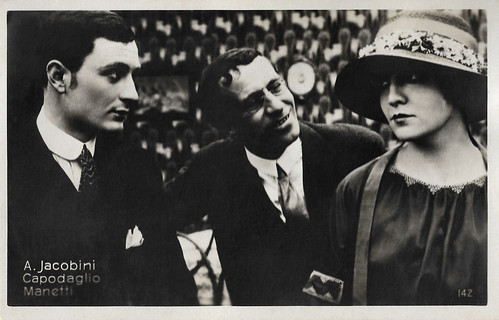
Italian postcard by G. Vettori, Milano, no. 142. Photo: Lido Manetti, Ruggero Capodaglio and Maria Jacobini in Addio giovinezza/Good-bye youth (Augusto Genina, 1918), a silent film adaptation of the play by Sandro Camasio and Nino Oxilia.
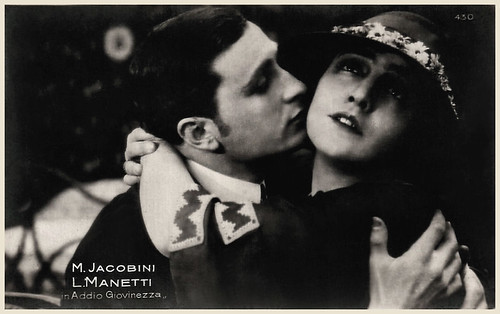
Italian postcard, no. 430. Photo: Maria Jacobini and Lido Manetti in Addio giovinezza/Good-bye youth (Augusto Genina, 1918).
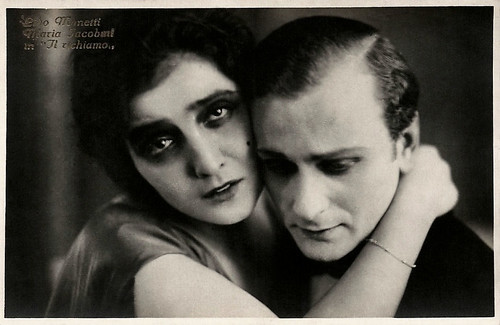
Italian postcard by G.B. Falci, Milano, no. 67. Publicity still of Maria Jacobini and Lido Manetti in Il richiamo/The call (Gennaro Righelli, 1921). A print of this film is in the Komiya Collection at the National Film Center in Tokyo. A restored version was shown at the festival Cinema Ritrovato in Bologna (June/July 2012).
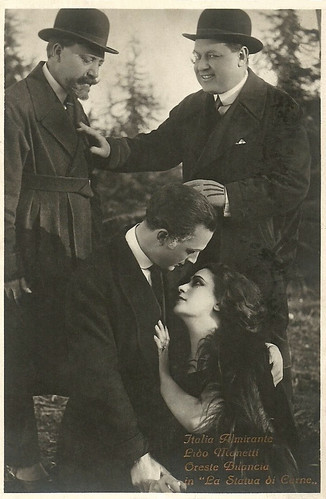
Italian postcard by G.B. Falci, Milano. Photo: Italia Almirante Manzini , Lido Manetti and Oreste Bilancia in the closing scene of La statua di carne/The statue of meat (Mario Almirante, 1921).
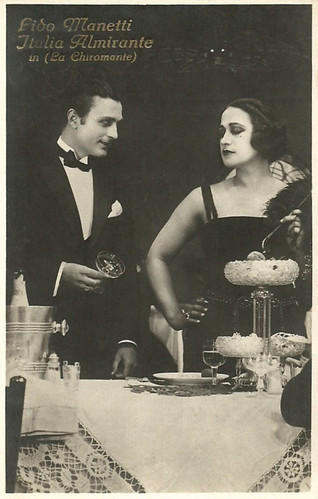
Italian postcard by G.B. Falci, Milano. Photo: Italia Almirante Manzini and Lido Manetti in La chiromante/The Fortune Teller (Mario Almirante, 1921).
Car Accident on a Hollywood Street
Lido Manetti also performed in strong man films such as Saetta, principe per un giorno/Saetta, Prince for a day (Mario Camerini, 1924) starring Domenico Gambino alias Saetta, and Maciste contro lo sceicco/Maciste against the Sheikh (Mario Camerini, 1926) starring Bartolomeo Pagano as Maciste. It would be one his last Italian films.
While he had a small part as Roman Guard in the epic Quo vadis? (Gabriellino d’Annunzio, Georg Jacoby, 1924) starring Emil Jannings as Nero, Manetti had major parts in films such as Il focolare spento/The extinguished fire (Augusto Genina, 1925) with Carmen Boni and La bocca chiusa/The Closed Mouth (Guglielmo Zorzi, 1925) starring Maria Jacobini .
In La bocca chiusa, Manetti plays a British duke who seduces a poor country girl (Jacobini). Her stepfather (Augusto Poggioli) sells her child to the duke, making her believe the child died. With the money he embellishes his house, but when the girl finds out, she goes mad, burns down the house and becomes a wanderer. Twenty years later, her son (Manetti again) lovingly takes her into his service, not knowing who she is. She recognises a picture, though, and not wanting to destroy his happiness, she silently goes away.
At that time the Italian film production was in decline, and when Manetti was spotted by a Universal studio talent scout in 1925, he moved to Hollywood. He played a small part in The Love Thief (John McDermott, 1926) starring Norman Kerry and Greta Nissen .
After two more small roles in Universal productions, he signed a contract with Paramount. He was renamed with the less ethnic stage name Arnold Kent and got male leads or major supporting roles in films like The World at Her Feet (Luther Reed, 1927) with Florence Vidor, The Woman on Trial (Mauritz Stiller, 1927) with Pola Negri , Hula (Victor Fleming, 1928) starring It-girl Clara Bow, and the adventure film Beau Sabreur (John Waters, 1928) starring Gary Cooper .
Handsome Kent appeared often in the fan magazines and the rising young star bought a La Salle standard seven passenger sedan. He was playing a prominent role in the adventure film The Four Feathers (Merian C. Cooper, Lothar Mendes, Ernest B. Schoedsack, 1929), when one evening a car driven by a film extra struck him on a Hollywood street.
Arnold Kent aka Lido Manetti died of the injuries from the road accident. He was replaced in the film and his scenes were reshot (probably with Theodore Von Eltz). He had been considered for a role in Mary Pickford ’s Coquette (1929) at the time of his death. Actor Matt Moore later portrayed this role in a film that won Pickford an Oscar.
The last film in which Arnold Kent is credited, was the part-talkie The Woman Disputed (Henry King, Sam Taylor, 1928) with Norma Talmadge .
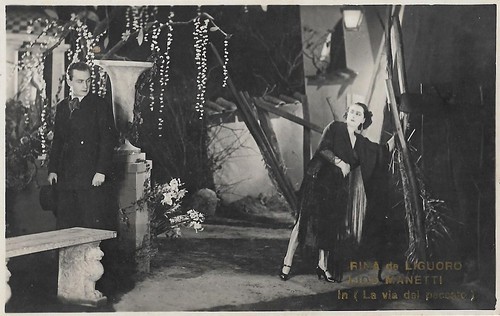
Italian postcard by G.B. Falci Editore, Milano (La Fotominio), no. 355. Photo: A.P. Film. Rina De Liguoro and Lido Manetti (Arnold Kent) in La via del peccato (Amleto Palermi, A.P. Film 1925).
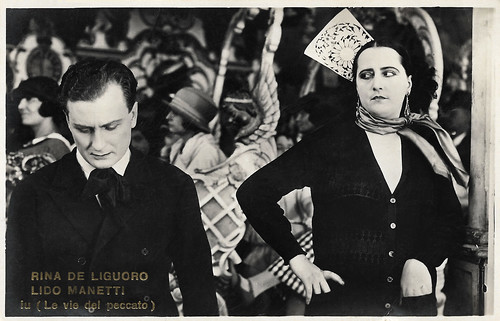
Italian postcard by G.B. Falci Editore, Milano (La Fotominio), no. 361. Rina de Liguoro and Lido Manetti in La via del peccato/The Way of Sin (Amleto Palermi, 1925).
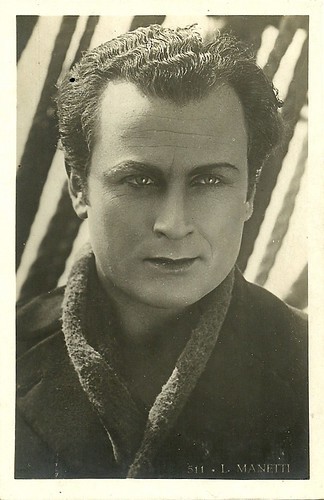
Italian postcard, no. 511. Photo: FERT. Lido Manetti in Maciste contro lo sceicco (Mario Camerini, 1926).
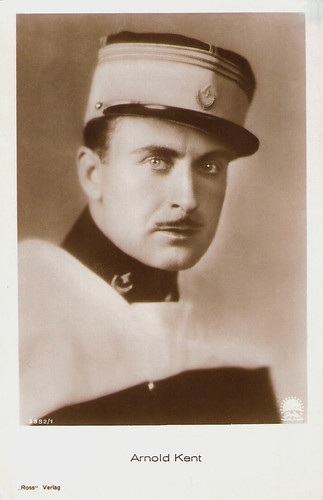
German postcard by Ross Verlag, no. 3382/1, 1928-1929. Sent by mail in the Netherlands in 1929. Photo: Paramount.
Sources: (IMDb), Hans J. Wollstein (AllMovie), Wikipedia (French and English) and .

Italian postcard by G.B. Falci Editore, Milano, no. 537A.

'Foreign' postcard by Ross Verlag, no. 3382/1, 1928-1929. Photo: Paramount.

German postcard by Ross Verlag, no. 3673/1, 1928-1929. Photo: United Artists. Lido Manetti (Arnold Kent) in The Woman Disputed (Henry King, Sam Taylor, 1928).
Male Love Interest
Lido Manetti was born in Florence, Italy in 1899 (according to all our sources, but this must be a mistake, looking at his film curriculum with his first leading film roles already in 1917).
He studied civil engineering, but entered the theatre and then films subsequently to his schooling. His first Italian film was probably La principessa/The Princess (Camillo De Riso, 1917) starring diva Leda Gys for Caesar Film.
From then on Manetti would be the male love interest in many diva-like films such as Il processo Clemenceau/The Clemenceau Affair (Alfredo De Antoni, 1917) and Malia/Liliana (Alfredo De Antoni, 1917) both with Francesca Bertini , and La passagera/The Passager (Gero Zambuto, 1917) with Pina Menichelli .
In 1918 followed Addio giovinezza/Good-bye Youth (Augusto Genina, 1918) with both Maria Jacobini and Helena Makowska , Femmina/Female (Augusto Genina, 1918) with Italia Almirante Manzini , and L’onestà del peccato/The Wife He Neglected (Augusto Genina, 1918) with Maria Jacobini .
The next year saw Una donna funesta/A baleful woman (Camillo De Riso, 1919) with Tilde Kassay, Il bacio di Dorina/The kiss of Dorina (Giulio Antamoro, 1919) with Lina Millefleurs, La signora delle rose/The Lady of the Roses (Diana Karenne, 1919) starring Diana Karenne herself, and La fiamma e il cenere/The flame and the ashes (Giulio Antamoro), 1919 with again Karenne.
Memorable titles from the early 1920s were Amore rosso/Red Love (Gennaro Righelli, 1921) and La preda/The prey (Guglielmo Zorzi, 1921), both co-starring Maria Jacobini and Amleto Novelli , La statua di carne/The statue of meat (Mario Almirante, 1921) with Italia Almirante Manzini , Il richiamo/The call (Gennaro Righelli, 1921) with Maria Jacobini , La madre folle/Through the Shadows (Carmine Gallone, 1923) with Soava Gallone , La leggenda delle Dolomiti/The legend of the Dolomites (Guglielmo Zorzi, 1920) and Povere bimbe/Poor girls (Giovanni Pastrone, 1924) both with Linda Pini .
The plot of La statua di carne looks a bit like Alfred Hitchcock’s Vertigo (1958) and its literary predecessor Bruges-la-Morte by Georges Rodenbach. Well-to-do Paul has an affair with simple, innocent flowershop girl Mary until she dies of a weak heart. He meets Noemi, an eccentric femme fatale who is the spitting image of Mary, and who agrees to pose for him every day as Mary. Noemi falls in love with Paul, but cannot stand that he doesn’t love herself but only the defunct Mary. In contrast to Rodenbach, here the man doesn’t kill the lookalike, but he duels for her with her ex-lover. In the end he wins the duel but also admits his love for Noemi.

Italian postcard by G. Vettori, Milano, no. 142. Photo: Lido Manetti, Ruggero Capodaglio and Maria Jacobini in Addio giovinezza/Good-bye youth (Augusto Genina, 1918), a silent film adaptation of the play by Sandro Camasio and Nino Oxilia.

Italian postcard, no. 430. Photo: Maria Jacobini and Lido Manetti in Addio giovinezza/Good-bye youth (Augusto Genina, 1918).

Italian postcard by G.B. Falci, Milano, no. 67. Publicity still of Maria Jacobini and Lido Manetti in Il richiamo/The call (Gennaro Righelli, 1921). A print of this film is in the Komiya Collection at the National Film Center in Tokyo. A restored version was shown at the festival Cinema Ritrovato in Bologna (June/July 2012).

Italian postcard by G.B. Falci, Milano. Photo: Italia Almirante Manzini , Lido Manetti and Oreste Bilancia in the closing scene of La statua di carne/The statue of meat (Mario Almirante, 1921).

Italian postcard by G.B. Falci, Milano. Photo: Italia Almirante Manzini and Lido Manetti in La chiromante/The Fortune Teller (Mario Almirante, 1921).
Car Accident on a Hollywood Street
Lido Manetti also performed in strong man films such as Saetta, principe per un giorno/Saetta, Prince for a day (Mario Camerini, 1924) starring Domenico Gambino alias Saetta, and Maciste contro lo sceicco/Maciste against the Sheikh (Mario Camerini, 1926) starring Bartolomeo Pagano as Maciste. It would be one his last Italian films.
While he had a small part as Roman Guard in the epic Quo vadis? (Gabriellino d’Annunzio, Georg Jacoby, 1924) starring Emil Jannings as Nero, Manetti had major parts in films such as Il focolare spento/The extinguished fire (Augusto Genina, 1925) with Carmen Boni and La bocca chiusa/The Closed Mouth (Guglielmo Zorzi, 1925) starring Maria Jacobini .
In La bocca chiusa, Manetti plays a British duke who seduces a poor country girl (Jacobini). Her stepfather (Augusto Poggioli) sells her child to the duke, making her believe the child died. With the money he embellishes his house, but when the girl finds out, she goes mad, burns down the house and becomes a wanderer. Twenty years later, her son (Manetti again) lovingly takes her into his service, not knowing who she is. She recognises a picture, though, and not wanting to destroy his happiness, she silently goes away.
At that time the Italian film production was in decline, and when Manetti was spotted by a Universal studio talent scout in 1925, he moved to Hollywood. He played a small part in The Love Thief (John McDermott, 1926) starring Norman Kerry and Greta Nissen .
After two more small roles in Universal productions, he signed a contract with Paramount. He was renamed with the less ethnic stage name Arnold Kent and got male leads or major supporting roles in films like The World at Her Feet (Luther Reed, 1927) with Florence Vidor, The Woman on Trial (Mauritz Stiller, 1927) with Pola Negri , Hula (Victor Fleming, 1928) starring It-girl Clara Bow, and the adventure film Beau Sabreur (John Waters, 1928) starring Gary Cooper .
Handsome Kent appeared often in the fan magazines and the rising young star bought a La Salle standard seven passenger sedan. He was playing a prominent role in the adventure film The Four Feathers (Merian C. Cooper, Lothar Mendes, Ernest B. Schoedsack, 1929), when one evening a car driven by a film extra struck him on a Hollywood street.
Arnold Kent aka Lido Manetti died of the injuries from the road accident. He was replaced in the film and his scenes were reshot (probably with Theodore Von Eltz). He had been considered for a role in Mary Pickford ’s Coquette (1929) at the time of his death. Actor Matt Moore later portrayed this role in a film that won Pickford an Oscar.
The last film in which Arnold Kent is credited, was the part-talkie The Woman Disputed (Henry King, Sam Taylor, 1928) with Norma Talmadge .

Italian postcard by G.B. Falci Editore, Milano (La Fotominio), no. 355. Photo: A.P. Film. Rina De Liguoro and Lido Manetti (Arnold Kent) in La via del peccato (Amleto Palermi, A.P. Film 1925).

Italian postcard by G.B. Falci Editore, Milano (La Fotominio), no. 361. Rina de Liguoro and Lido Manetti in La via del peccato/The Way of Sin (Amleto Palermi, 1925).

Italian postcard, no. 511. Photo: FERT. Lido Manetti in Maciste contro lo sceicco (Mario Camerini, 1926).

German postcard by Ross Verlag, no. 3382/1, 1928-1929. Sent by mail in the Netherlands in 1929. Photo: Paramount.
Sources: (IMDb), Hans J. Wollstein (AllMovie), Wikipedia (French and English) and .
Published on January 08, 2020 22:00
Paul van Yperen's Blog
- Paul van Yperen's profile
- 13 followers
Paul van Yperen isn't a Goodreads Author
(yet),
but they
do have a blog,
so here are some recent posts imported from
their feed.



